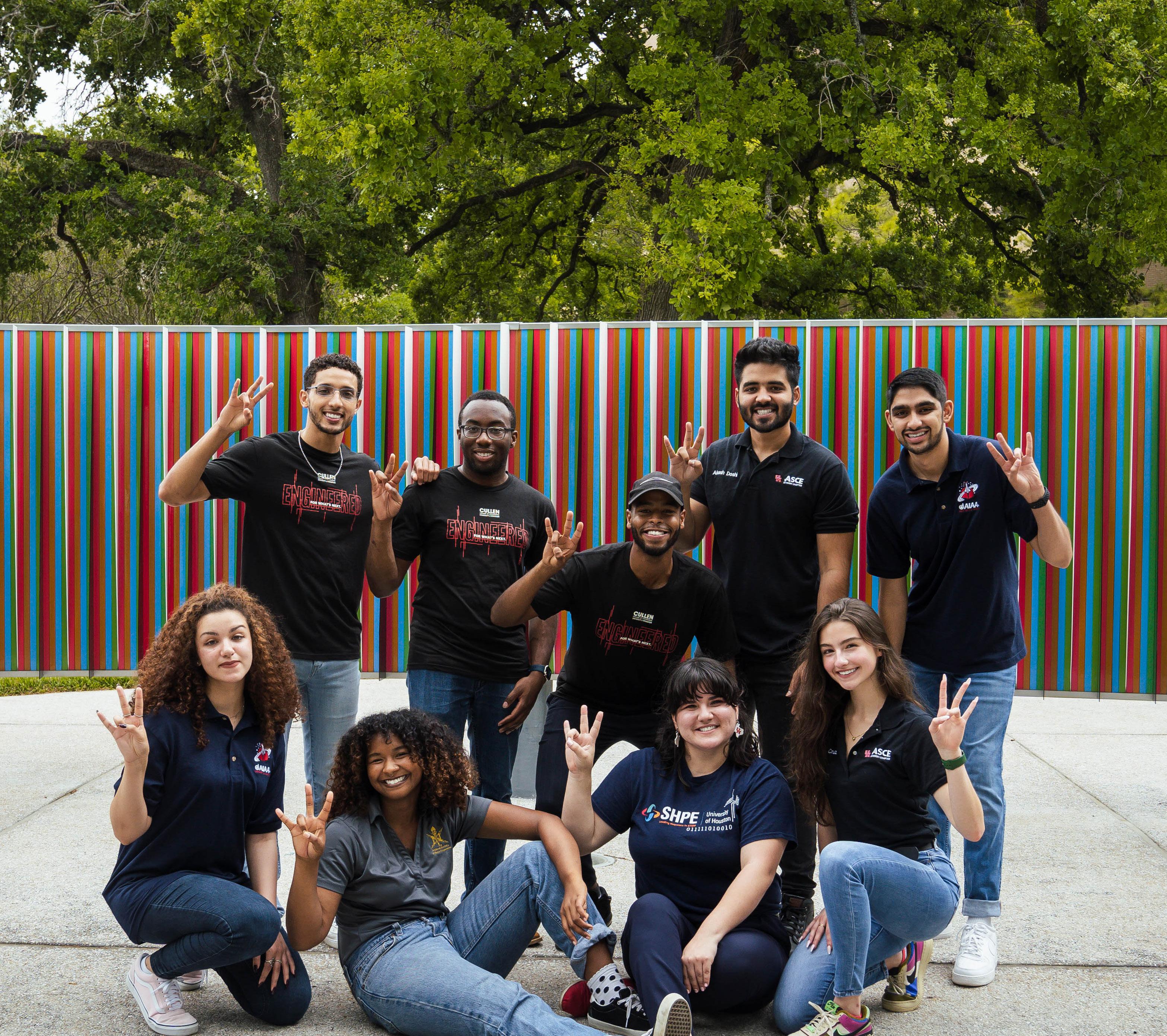
CULLEN COLLEGE OF ENGINEERING


CULLEN COLLEGE OF ENGINEERING
 Cullen College of Engineering Magazine
Cullen College of Engineering Magazine
WE KNOW WHAT NEEDS TO BE DONE. AND WE ARE THE ONES DOING IT.
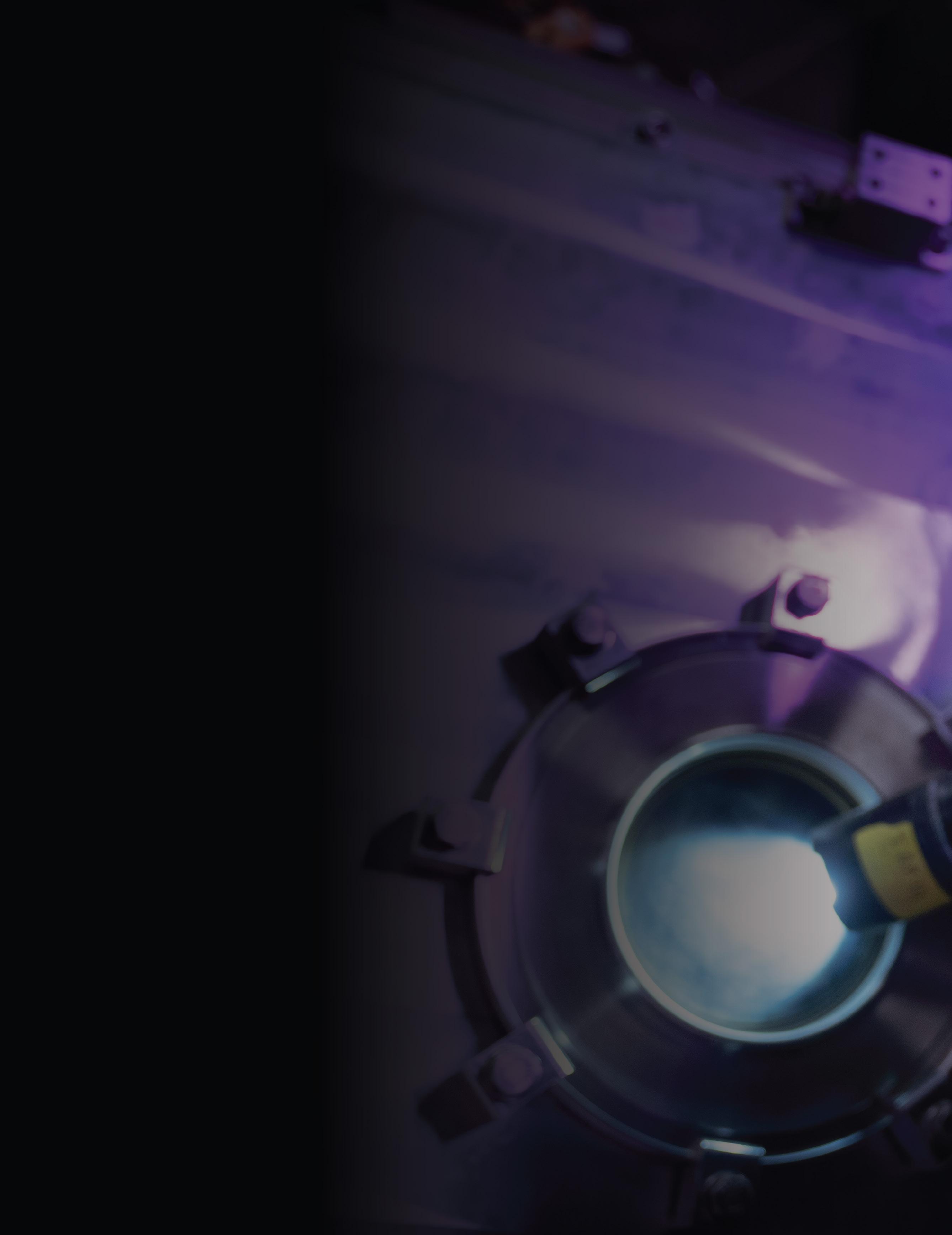

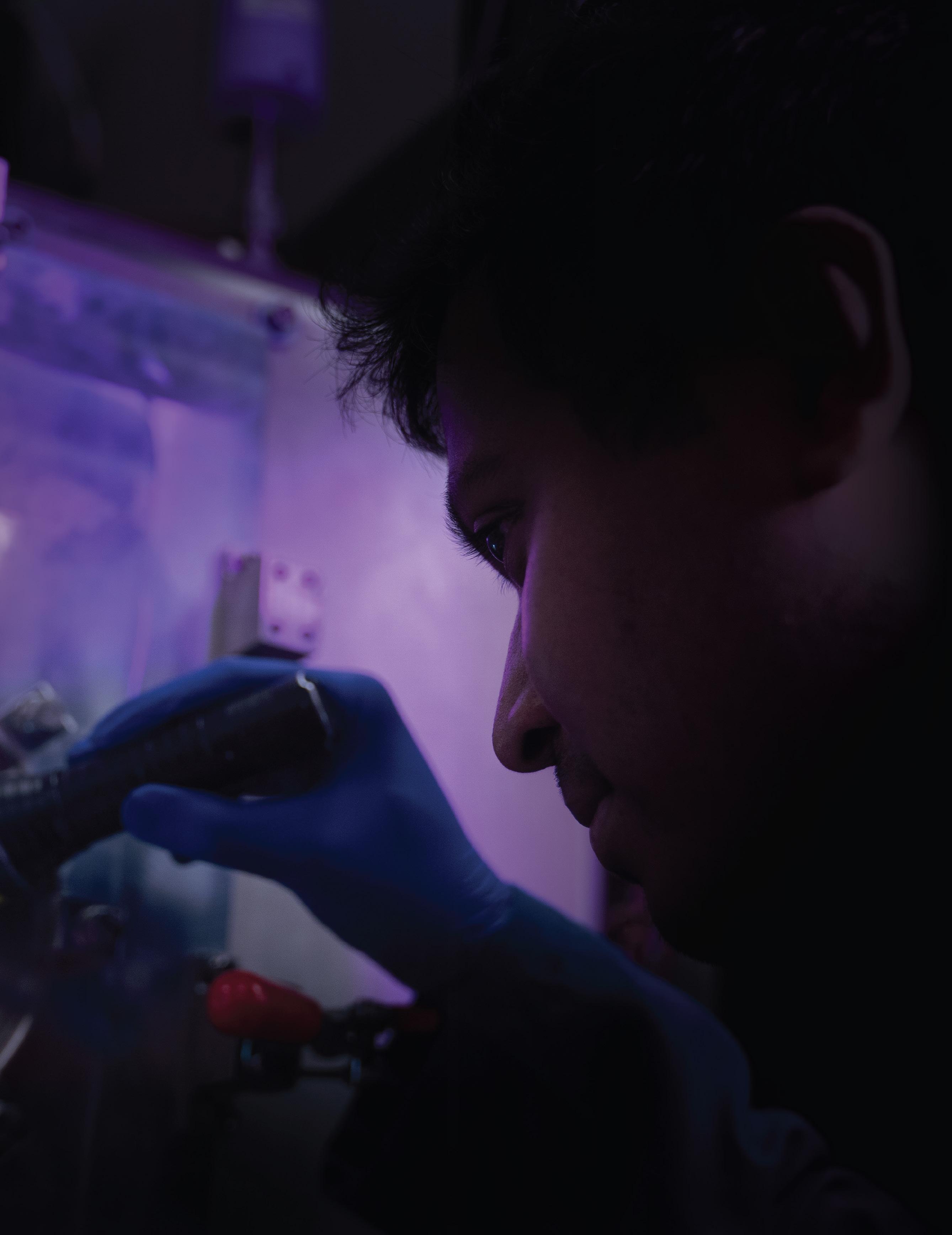
Hugh Roy and Lillie Cranz Cullen Distinguished University Professor and Interim Dean
Pradeep Sharma
Senior Associate Dean for Research and Facilities
Dmitri Litvinov
Senior Associate Dean for Graduate Programs and Computing Facilities
Suresh K. Khator
Senior Associate Dean for Undergraduate Programs and Distance Learning
JR Rao
Senior Associate Dean for the Technology Division
Heidar Malki
Associate Dean for Academic Affairs for the Technology Division
Ron Hopkins
Associate Dean for Student Success and Undergraduate Support Services
Jamison V. Kovach
Parameters is published biannually by the University of Houston's Cullen College of Engineering, Office of Communications.
Executive Director of Communications
Inez Hutchinson
Communications Manager
Hunter Corfield
Program Manager II
Shandolyn Arline-Johnson
Graphic Designer
Olga Medrano
Communications Coordinator
Alex Keimig
Senior Writer/Editor
Stephen Greenwell
Photographer/Videographer
Andrew Dees
Contributing Writers and Editors
Nusayba El-Ali | Laurie Fickman
Rashda Khan | John Lienhard
Bryan Luhn | Alison Medley
Maria Ramirez | Chris Stipes
Sally Strong | Ashley V. Velazquez
Stock imagery provided by iStock, pexels, unsplashed and Freepik
Contact us:
University of Houston
Cullen College of Engineering
Office of Communications
Engineering Building 2
4222 Martin Luther King Blvd, Suite E311 Houston, Texas 77204-4009
The University of Houston is an Equal Opportunity/Affirmative Action institution. Minorities, women, veterans and persons with disabilities are encouraged to apply.
Those wishing to reprint articles or photographs should contact the director. Use the credit line: Reprinted with permission of the University of Houston Cullen College of Engineering. Clippings are appreciated.
Biomedical Engineering
Chairman: Metin Akay www.bme.uh.edu 832-842-8813
Chemical & Biomolecular Engineering
Chairman: Triantafillos (Lakis) Mountziaris www.chee.uh.edu 713-743-4300
Civil & Environmental Engineering
Chairman: Roberto Ballarini www.cive.uh.edu 713-743-4250
Construction Management
Interim Chairman: Ahmed Senouci www. dot.egr.uh.edu/departments/cm 713-743-6131
Electrical & Computer Engineering
Chairman: Badri Roysam www.ece.uh.edu 713-743-4400
Engineering Technology
Chairwoman: Fatima Merchant www.dot.egr.uh.edu/departments/et 713-743-8292
Human Development & Consumer Sciences
Chairwoman: Barbara Stewart www.dot.egr.uh.edu/departments/hdcs 713-743-4119
Industrial Engineering
Chairman: Gino J. Lim www.ie.uh.edu 713-743-4180
Information Science Technology
Chairman: Amaury Lendasse www.dot.egr.uh.edu/departments/ilt 713-743-6405
Mechanical Engineering
Chairman: Karolos Grigoriadis www.me.uh.edu 713-743-4500
Petroleum Engineering
Chairman: Mohamed Soliman www.petro.uh.edu 832-842-4848
Office of Advancement
Mail: University of Houston Cullen College of Engineering Engineering Building 2 4222 Martin Luther King Blvd, Suite E421 Houston, Texas 77204-4007
Attn: Margarita Frinsco advancement.egr.uh.edu
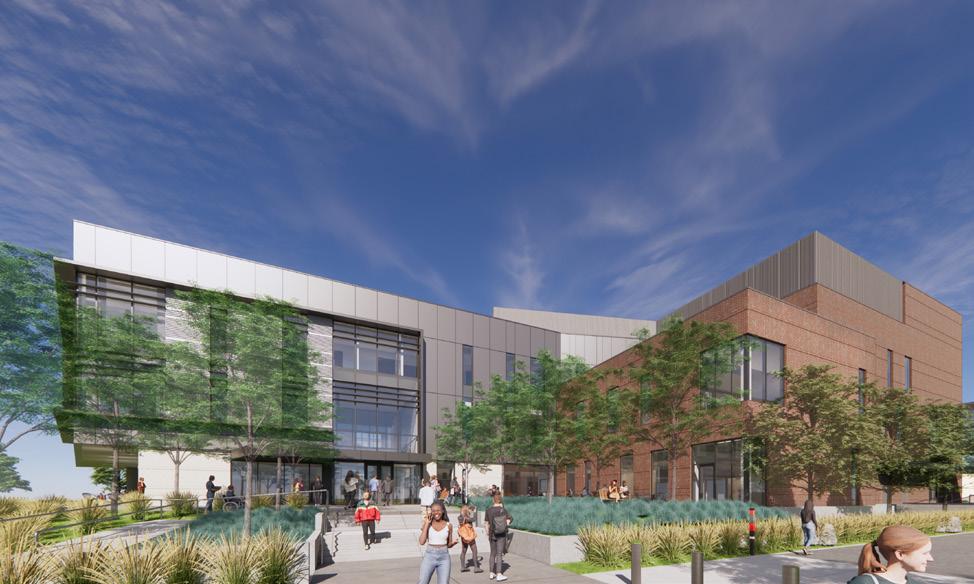

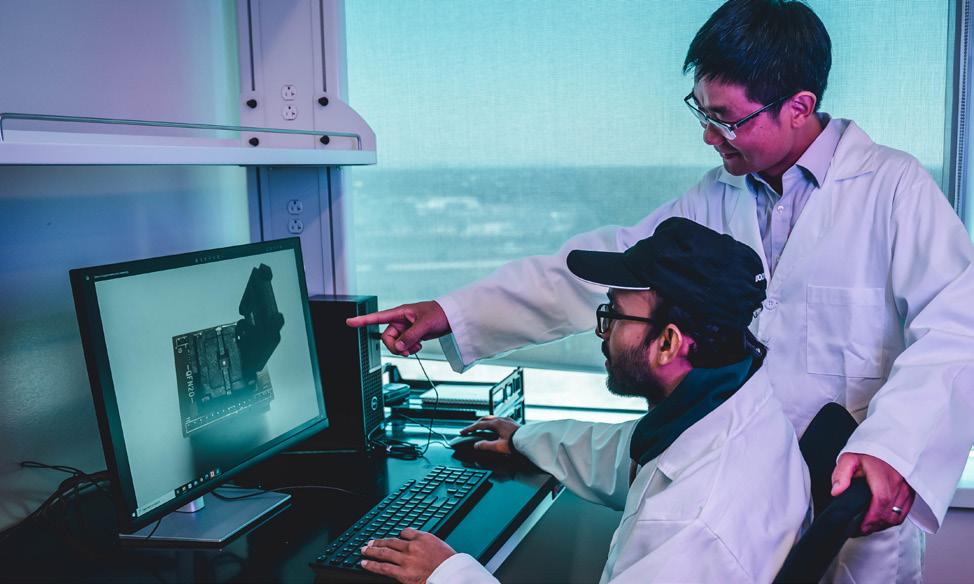



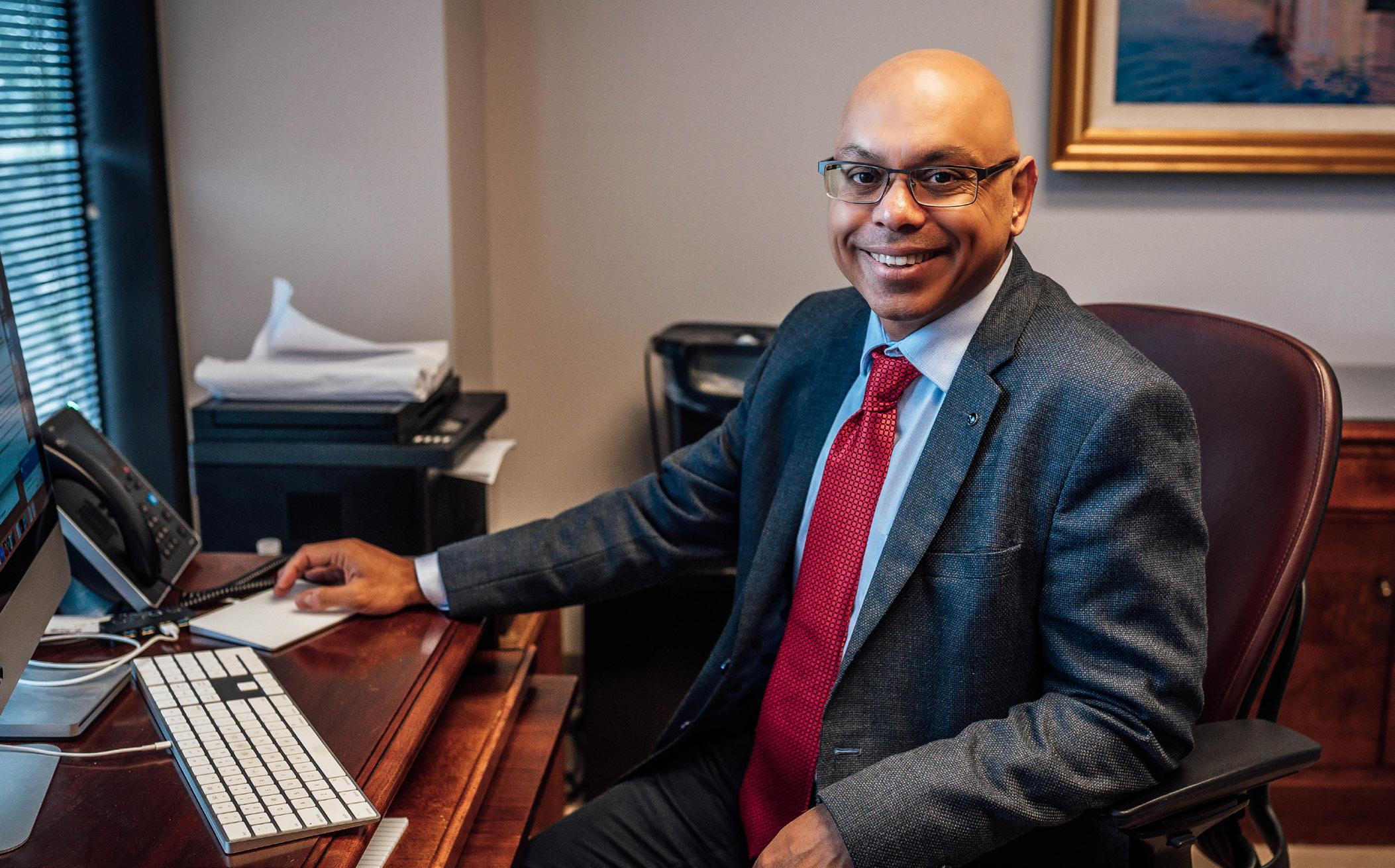
Bold. Innovative. Revolutionary. Here at the Cullen College of Engineering, we strive for excellence and to be the leader in cutting-edge research and technology. With more than $50 million in research expenditures, the highest of any academic unit at the University of Houston, we have proven ourselves to be a Research Enterprise Powerhouse. Every day, our faculty and students work together to conduct innovative and impactful research to help find answers to real-world issues, be it using artificial intelligence to help define the future of the battlefield or developing measures that best serve our health and medical needs while also finding new purposeful ways to reuse plastic wastes.
These enormous strides we’ve made as a college community in the last few decades are astounding, and our college is at a critical juncture and poised to reach even greater heights. For instance, the University of Houston was awarded a $63.5 million contract by the U.S. Department of Defense to enhance the Army’s decision-making capabilities. It is the largest contract or grant ever awarded to the University of Houston, and our very own civil and environmental engineering professor, Dr. Craig Glennie, will be leading this project along with a team
of researchers focused on helping the Army to build realistic modeling using artificial intelligence and machine learning. To continue our climb, Dr. Jeffrey Rimer and Dr. Megan Robertson received funding from The Welch Foundation totaling $9 million to establish two new Welch Centers. These are just a few examples of the great work showcased in this issue of Parameters
You will also have a chance to read about our student successes and how our alumni are making an impact in our college and beyond. These stories show why we are engineered for what’s next.
Sincerely,
 Pradeep Sharma
Interim Dean of the Cullen College of Engineering
Hugh Roy and Lillie Cranz Cullen Distinguished University Professor
Pradeep Sharma
Interim Dean of the Cullen College of Engineering
Hugh Roy and Lillie Cranz Cullen Distinguished University Professor

Three Chemical & Biomolecular Engineering professors received grants from the Welch Foundation, one of the nation’s largest private funding sources for fundamental chemical research. Jeremy Palmer, then an assistant professor, received $240,000 to expand on his postdoctoral research on the phase behavior of liquid water at low temperatures. Jeffrey Rimer, the Abraham E. Dukler Professor, received earned his third grant from the foundation to study the treatment and formation of kidney stones, building on earlier work from 2012 and 2015. And Jacinta Conrad, Ernest and Barbara Henley Associate Professor, received $195,000 to study one of the most intriguing problems
Ryan Hannemann was named the Outstanding Senior for the 2013-14 academic year, which came after he won Outstanding Junior the previous year. Unlike many undergraduates, he had joined the Army a year after his graduation from high school. He spent six years in the service, including a combined 33 months on deployments to Iraq. He chose UH when he finished his stint because of its proximity to his family and the career opportunities the metro area could provide for a mechanical engineering degree.
in physical chemistry – the nature of the glass transition.
In the years since, Palmer has earned a promotion to Ernest and Barbara Henley Associate Professor as well, and Conrad is now the Frank M. Tiller Professor. Rimer is now also the Director of Graduate Studies. And, the Welch Foundation has continued to recognize the stellar research efforts of the Cullen College of Engineering. It has provided $5 million for a research center for Rimer, and $4 million for a similar effort for Megan Robertson, a professor and Associate Chair for Faculty Development and Inclusive Excellence.




Even before graduating, Hannemann completed an internship with Marathon, which turned into a full-time job offer. He has now spent 10 years at the company, being promoted along the way into his current role as a planning manager. In October 2023, he was named to Hart Energy's list of Forty Under 40.
“I have to give a big 'thank you' to the University of Houston and Cullen College of Engineering for seamlessly integrating students into the energy industry,” he said. “The outstanding students, alumni, professors, strategic partnerships and our prime location have significantly shaped my academic and professional trajectory.”


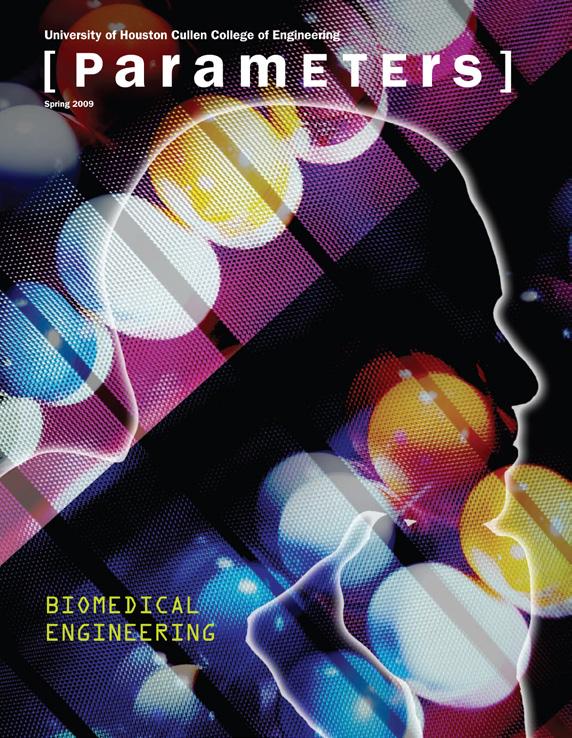
The College welcomed Yashashree Kulkarni to the Mechanical Engineering Department, at the position of assistant professor. She was hired after working as a postdoctoral research at the University of California, San Diego, and earning her doctorate in applied mechanics from the California Institute of Technology.
Kulkarni has been a strong researcher in her time at UH, earning ASME Fellow status in 2022 and the 2017 Sia Nemat-Nasser Early Career Award. She is now the Bill D. Cook Professor of Mechanical Engineering. Most recently in 2023, she received two separate awards totaling $675,000 from the NSF, to explore research into biological membranes and the role of mechanics in material sciences to biology.


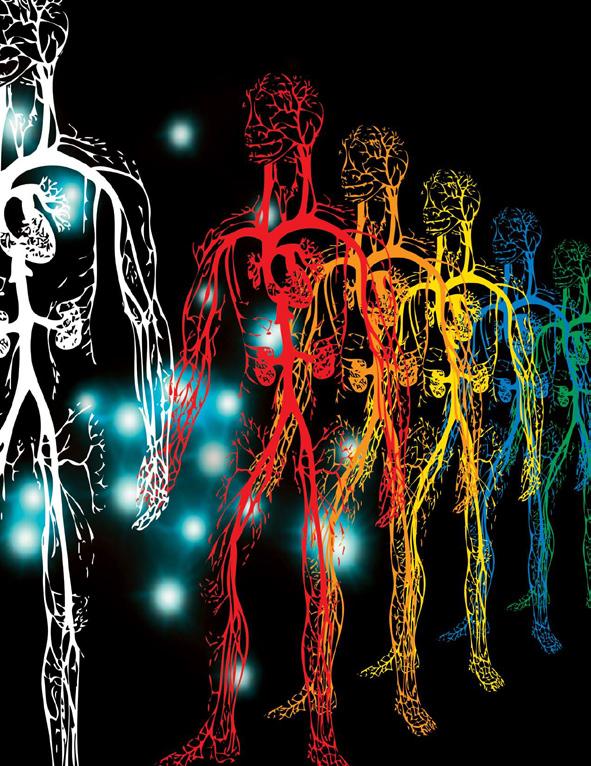
The University of Houston broke ground on the Science and Engineering Research and Classroom Complex (SERCC), one of the most ambitious building and construction projects taken by the university at the time. The effort had an $81 million price tag, with $30 million of that total earmarked for state of the art equipment. Between an auditorium and 11 classrooms, the building was designed to serve 1,700 students per teaching hour.
After opening fully in Fall 2006, the complex continues to serve Cullen today, hosting several labs and classrooms for Biomedical Engineering students. In today's dollars, the project would have cost roughly $131 million.


KPRC 2 spotlights UH Researcher Juan Carlos Fernandez-Diaz, co-principal investigator of NCALM, housed in the Cullen College of Engineering, and a team of researchers that found a lost Maya city deep in the jungles of Campeche, on the Yucatan Peninsula, in Mexico.
READ ONLINE AT:
https://www.click2houston.com/news/local/2023/07/17/photosresearchers-find-lost-maya-city-deep-in-mexican-jungle/?utm_ source=instagram&utm_medium=social&utm_campaign=sndbio&utm_content=kprc




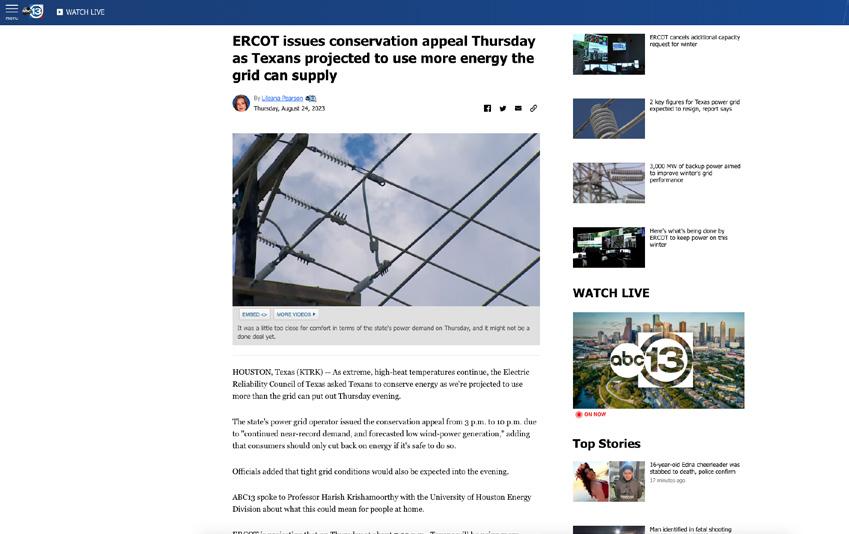
ABC13 featured Harish Krishnamoorthy in a segment discussing the continued near-record demand and forecasted low wind-power generation for the Texas power grid system. Krishnamoorthy, an associate professor of electrical and computer engineering, explains that longterm planning for ERCOT will require more energy storage and capacity to support th grid and avoid potential outages during extreme weather conditions.
READ MORE ONLINE AT:
https://abc13.com/ercot-texas-power-grid-issues-conservation-energy-consumption/13695322/
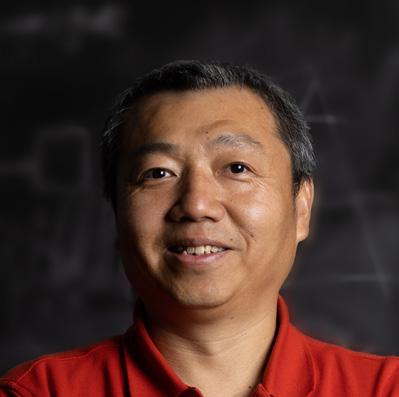
Houston's InnovationMap recently featured a story on Yunpeng "Jack" Zhang, who will lead a national consortium focused on cybersecurity in the transportation sector. Known as the Transportation Cybersecurity Center for Advanced Research and Education, or CYBER-CARE, is funded by a $2 million grant from U.S. Department of Transportation for its first year, with anticipated total federal funding of $10 million over five years. Zhang is also an associate professor in the Department of Information Science Technology at the UH Cullen College of Engineering’s Technology Division.
VIEW ONLINE AT:
https://houston.innovationmap.com/university-of-houston-department-of-transportation-cybersecurity-2662332840.html



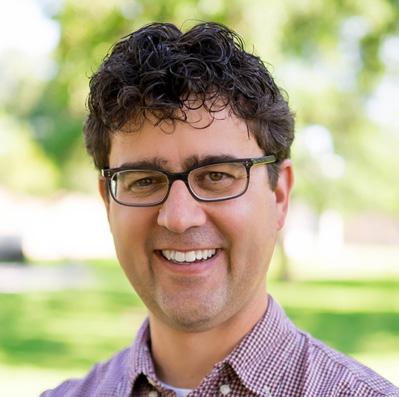
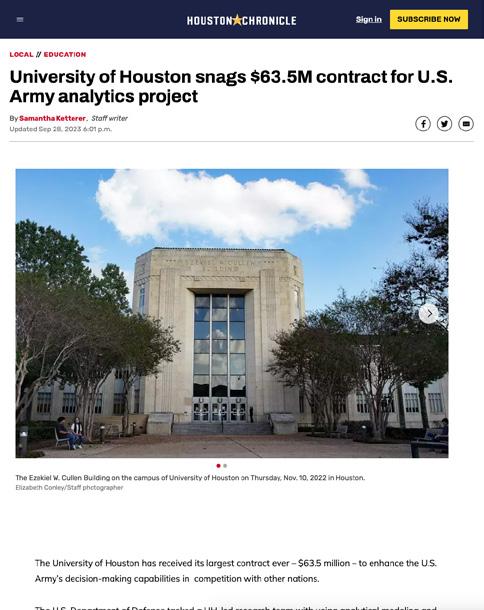
The Houston Chronicle featured the largest contract ever received at the University of Houston - $63.5 million to enhance the U.S. Army’s decision-making capabilities with other nations. Craig Glennie, a UH professor of civil and environmental engineering at the Cullen College of Engineering, will be leading the project.
READ MORE ONLINE AT:
https://www.houstonchronicle.com/news/houston-texas/education/article/university-houston-receives-63m-u-s-army-project-18389971.php
In an online article, the Houston Business Journal wrote about the groundbreaking for the new building at the Sugar Land campus for the Technology Division at the University of Houston's Cullen College of Engineering.
VIEW ONLINE AT:
https://www.bizjournals.com/houston/news/2023/10/05/university-of-houston-sugar-land-new-building.html
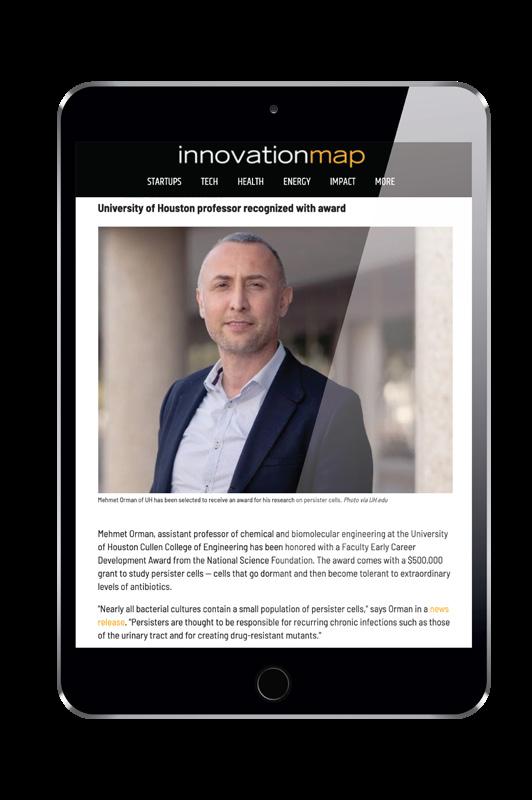
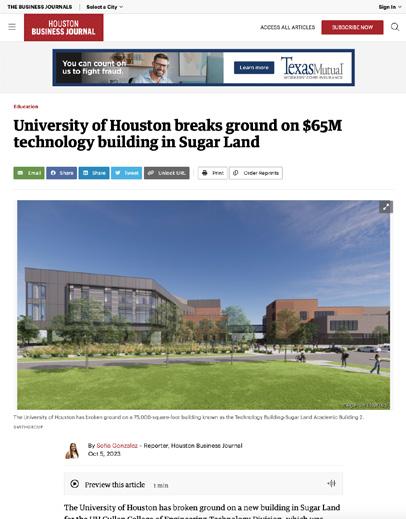


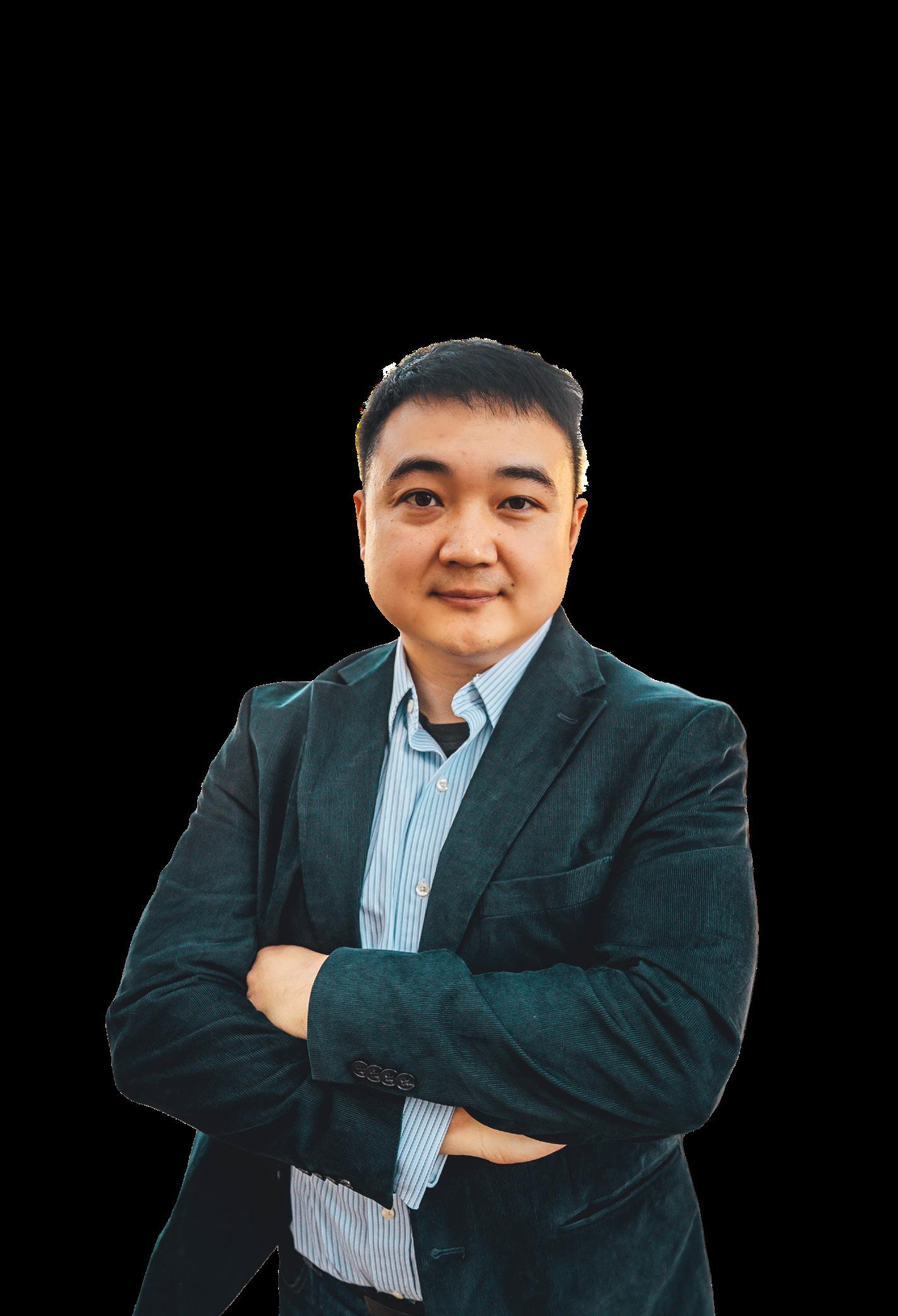

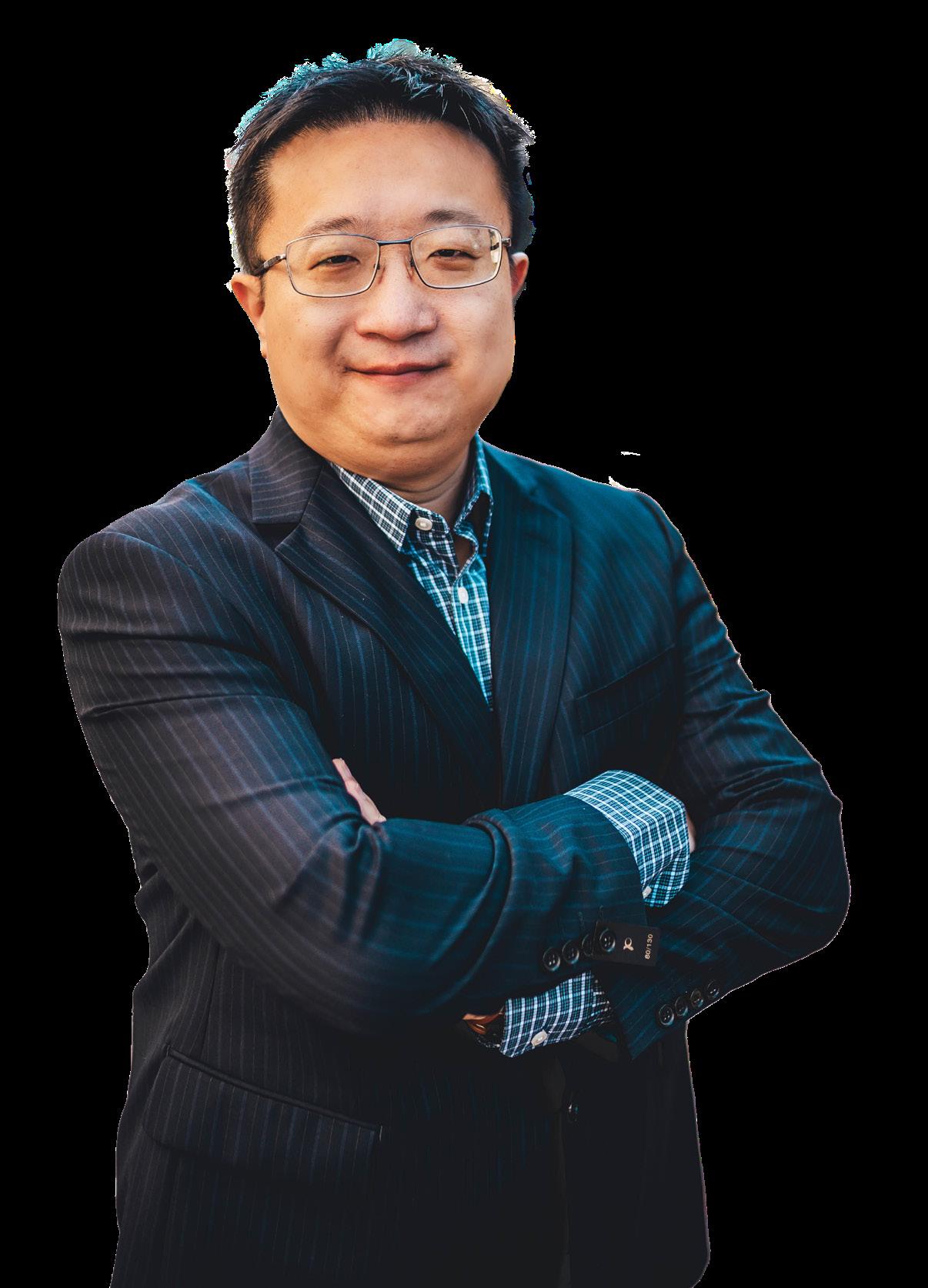
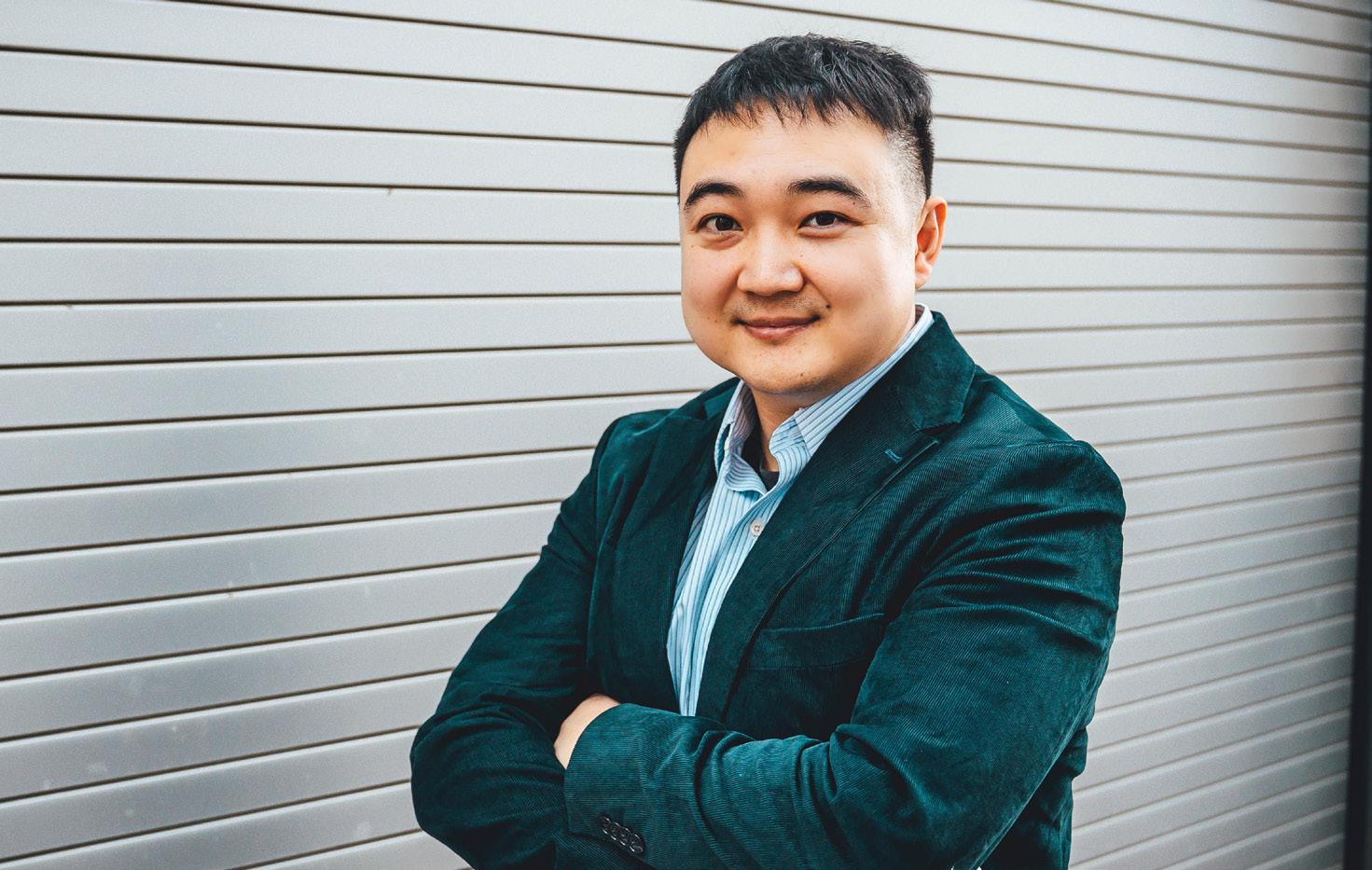
Ran An is an assistant professor in the Biomedical Engineering Department at the University of Houston Cullen College of Engineering, with a joint faculty appointment in the Department of Biomedical Sciences at the UH Tilman J. Fertitta Family College of Medicine, is the latest recipient of a Faculty Early (CAREER) Award from the National Science Foundation for his proposal, “Alternating Current Electrophoresis in Spatially Non-Uniform Electric Fields.”
An's research will examine a curiosity in recent research on electrolyte migration using alternating current (AC) electric fields.
According to his proposal, “Scientists have assumed that applying AC voltages to an electrolyte solution encourages the electrolytes to migrate in a way that does not affect the overall bulk solution properties. However, recent research studies revealed that electrolyte bulk solution properties change when a spatially non-uniform AC electric field is applied. Effects such as flow reversal, pH shifts, solution osmotic pressure change, and the generation of ion concentration gradients were observed.”
This project's objective is to understand how electrolytes and other charged particles respond to spatially non-uniform AC electric fields in bulk solutions over extended periods. This fundamental knowledge can be applied to develop novel technologies for molecular biosensing, water desalination, and high-throughput drug screening assays.
JIAN SHIJian Shi, an assistant professor at the University of Houston Cullen College of Engineering with a dual appointment to the Engineering Technology and Electrical & Computer Engineering departments at the University of Houston Cullen College of Engineering, has received a Faculty Early Career Development (CAREER) Award from the National Science Foundation for $500,861 to facilitate the transition to renewable energy, by reducing the shortterm and long-term social costs of decarbonization.
Shi said his goal is “developing new carbon-driven mechanisms, methodologies and algorithms into the existing power grid operation conventions to accommodate and accelerate the process of decarbonization, while maintaining its desired operational characteristics and societal responsibilities.”
Besides research, another key aspect of his CAREER proposal is to train the next-generation energy workforce and prepare them to understand, engage in and ultimately lead the energy transition in the decades to come. As a Hispanic-serving institution with a diverse student body, UH has provided excellent opportunities to engage and train students from all backgrounds, especially Hispanic and Asian American students, to foster a more diversified and vibrant workforce in the future energy industry.
 Ran An
Ran An
 BY MARISA RAMIREZ
BY MARISA RAMIREZ

The University of Houston celebrated in October the groundbreaking of a new $65 million academic building in ceremonies at the UH at Sugar Land instructional site. Before faculty, staff, students and community leaders, UH officials turned the dirt for what will become the Technology Building-Sugar Land Academic Building 2 (SAB2).
"We are grateful for the collaboration of supporters in the region and state whose investment in UH will result in a new generation of engineering and technology professionals," said Renu Khator, president of the University of Houston. "The growth of our Technology Division and our Sugar Land instructional site supports our vision of building a top 50 public university that provides a top tier educational experience and creates impactful research.”
The three-floor, approximately 75,000 square foot building will be home for faculty, staff and students of the UH Cullen College of Engineering-Technology Division.
In 2021, the Texas Legislature approved funds for a second academic building in Sugar Land. The allocation was part of a larger funding package for UH System facility construction and renovations. The new construction will allow the Technology Division to complete its transition to Sugar Land.
“We are excited to usher in this next chapter of growth and impact for the University and for our Fort Bend County region,” said Jay Neal, associate vice president, academic affairs and chief operating officer for UH at Sugar Land. “The addition of this new building will allow us to accommodate all Technology Division classes and programs that have been transitioning from the main campus to Sugar Land for the last several months.”
In 2022, a transition task force was seated to begin moving all programs and classes to the Sugar Land instructional site. By 2025 all programs from the Technology Division will be at UH at Sugar Land.
The new Technology Building will feature:
• Wet and dry labs
• Traditional and active learning classrooms
• Computer labs
• Student lounge areas
• Conference spaces
• Student advising spaces
The new building will sit adjacent to the current Technology Building, which opened in 2019. The architect for the new Technology Building is SmithGroup. The builder is Vaughn Construction. The grand opening is planned for 2025.

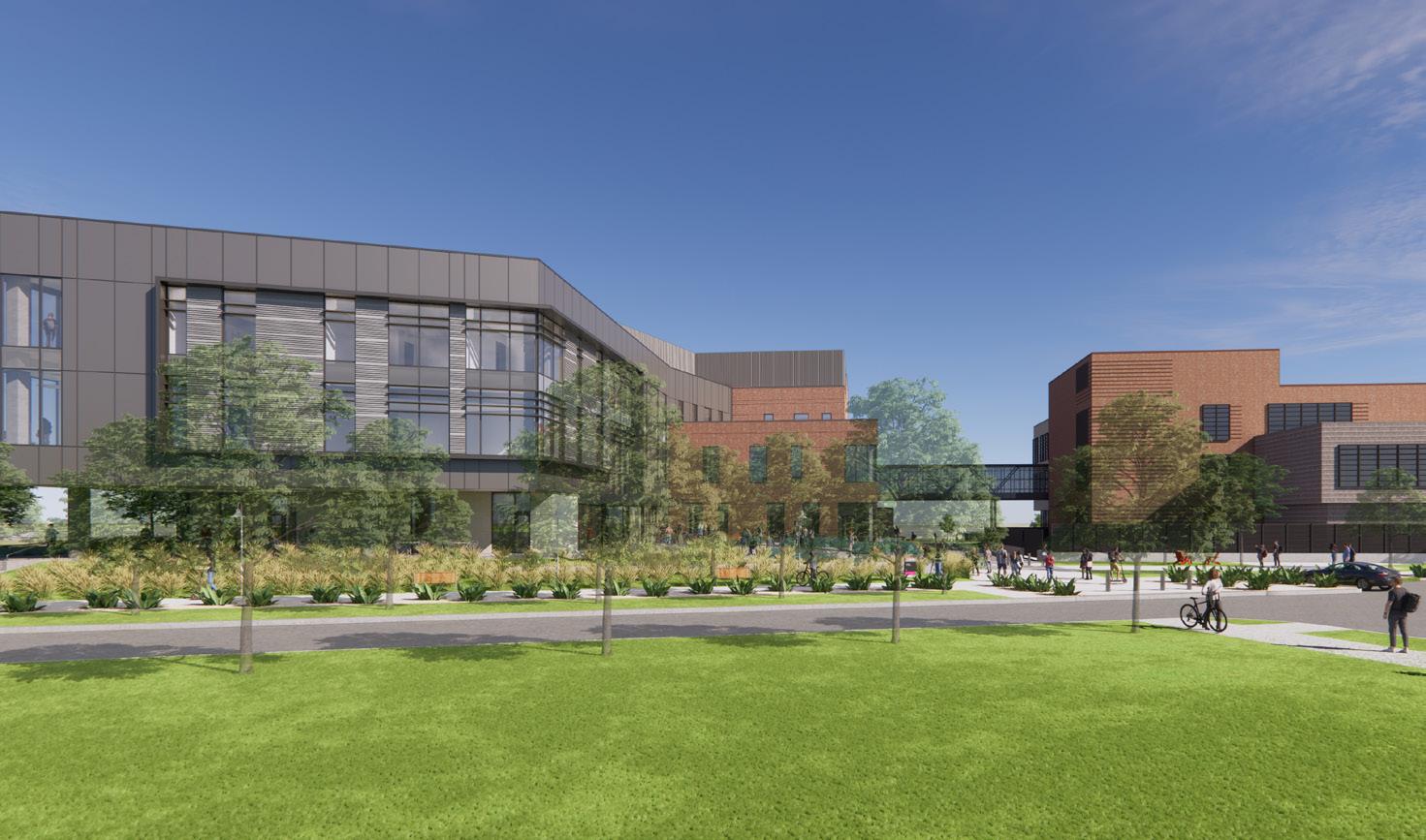 UH marching band kick off the groundbreaking celebration at UH Sugar Land.
UH marching band kick off the groundbreaking celebration at UH Sugar Land.
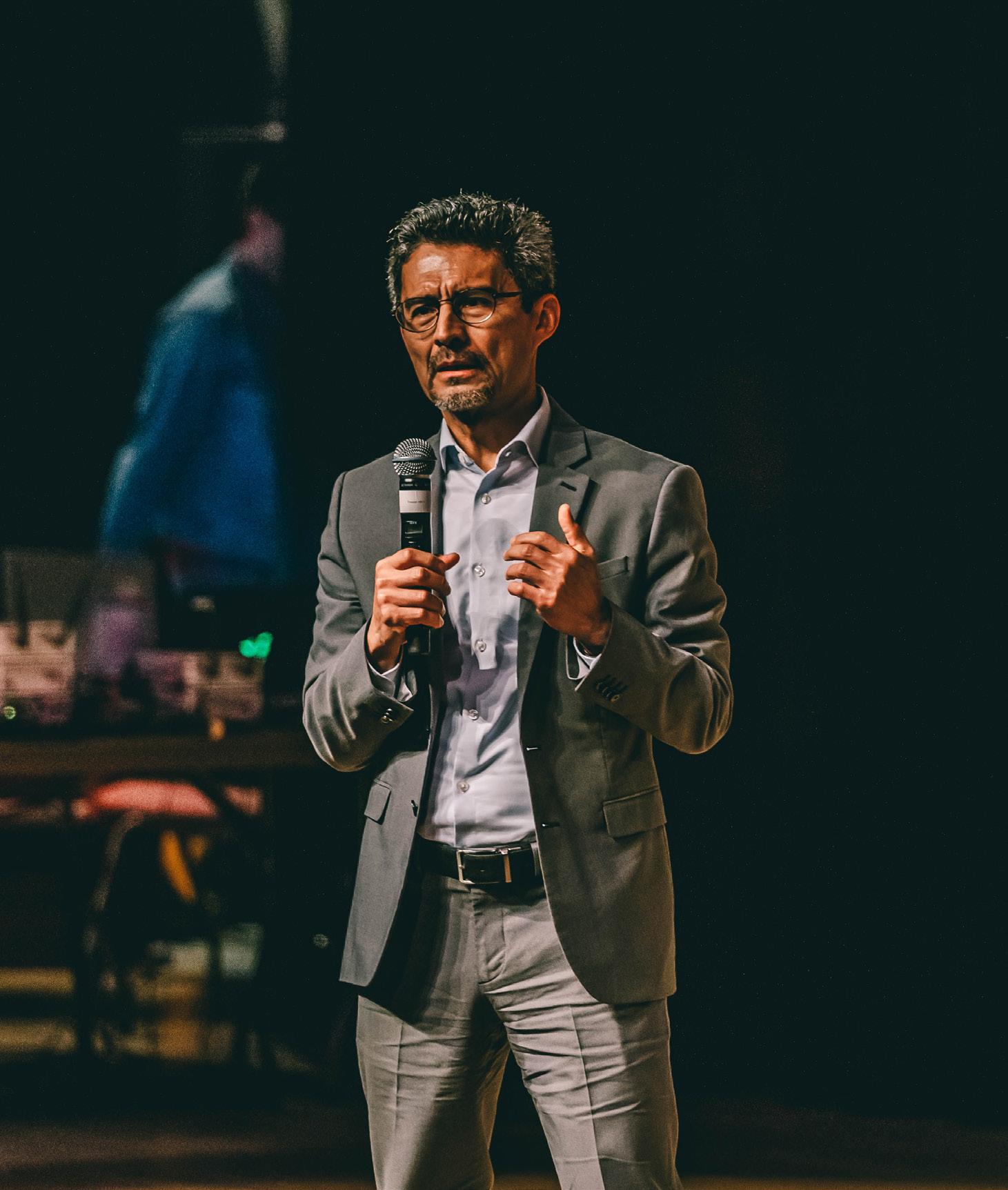
Two more universities, West Virginia University (WVU) and the Georgia Institute of Technology, have been funded by the National Science Foundation and are set to join the Industry-University Cooperative Research Center for Building Reliable Advances and Innovations in Neurotechnology (IUCRC BRAIN), housed at the University of Houston. It is home base for scientists developing and testing the efficacy, safety and long-term reliability of patient-centered neurotechnology.
“Having WVU and Georgia Tech in BRAIN is a major milestone as they are top universities in the biomedical field. GT is No. 1 according to U.S. News & World Report. WVU is doing human subjects testing of implanted electrode arrays for brain-computer interfaces,” said Jose Luis Contreras-Vidal, the center director and Hugh Roy and Lillie Cranz Cullen Distinguished Professor of electrical and computer engineering.
Millions of adults live with neurological disorders, brain injury, mental illness, limb loss or paralysis, informing the dire need for accessible technologies that can more effectively address the care and rehabilitation needs of patients.
Enter the BRAIN Center, a collaboration between the University of Houston and Arizona State University, supported by
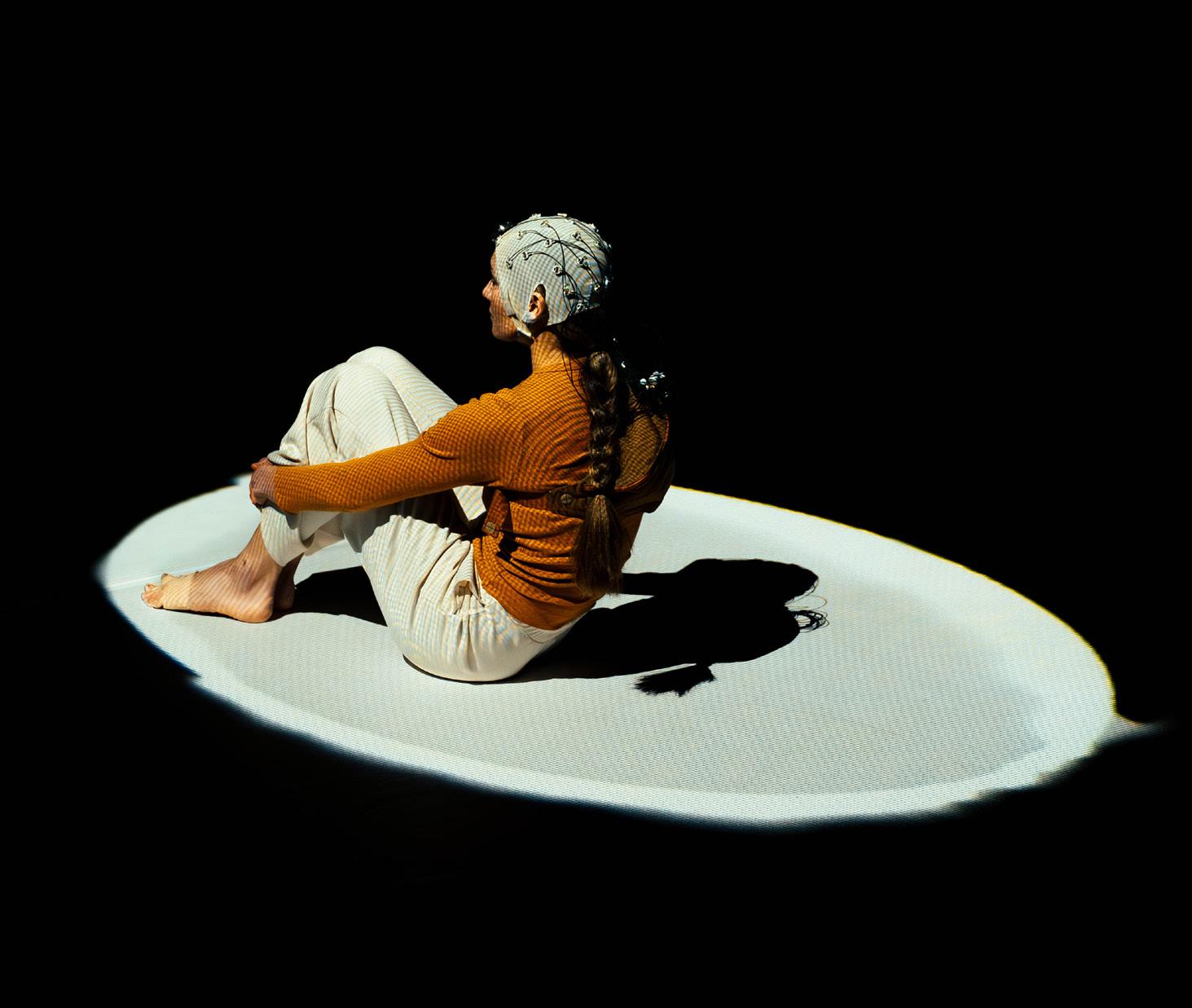
the National Science Foundation. The center allows research that would not be possible within the traditional silos of academic, industry, regulatory and clinical communities.
And, sometimes, in the most creative way.
When you enter the center, you may see dancers or artists busy with pirouettes or paintbrushes while wearing brain caps to measure their neural activity.
“The NSF IUCRC BRAIN program is a terrific deal for young startup companies who wish to do proof-of-concept studies with an outstanding team of neural engineers and clinicians,” said Peter Konrad, MD, West Virginia University. “You can’t beat the cost of entry into an academic partnership with leading institutions in this space. There is a commitment to providing high value and significant reduction in overhead expenses.”
Since Phase 1 was initially funded by the NSF in 2017, international partners have joined as has the U.S. Food and Drug Administration, and the center has emerged as an international hub for developing
neurotechnologies. The buzz continues to draw new members.
“Georgia Tech is very excited to join the BRAIN IUCRC with other leading neuroengineering institutions, all passionate about bringing faculty and students together with industry to collaborate on cutting-edge neurotechnology development,” said Michelle C. LaPlaca, Georgia Institute of Technology. “The Center partnerships are an excellent opportunity for small and large companies to invest in pre-translational research that both meets industry needs and harnesses academic expertise in order to ultimately improve patients’ lives.”
The multi-site IUCRC BRAIN Phase 2 is funded by a $1.8 million award from the National Science Foundation through Summer 2027 and an estimated $800,000 to $1 million per year in industry funds (not counting in-kind sup port) for the center.
Discoveries at the BRAIN Center include:
• Revolutionizing the way scientists and engineers approach the design of complex human-machine systems using data.
• Interpreting brain function from the molecular to the network levels.
• Harnessing neuroplasticity and emergent properties at multiple time scales to enhance the engagement and efficacy of human-machine interfaces.
• Enabling innovative devices that support accessible health care and empower individuals to control their own health, wellness, and fitness.
• Redefining the human-technology frontier.
“The BRAIN Center is a shining example of the NSF IUCRC program. Industry innovators, academic researchers and government agencies are collaborating to address challenging problems in neurotechnology. The BRAIN Center will be a source of transformative research work that has the potential to impact people with physical and neurological impairments,” said program director Mohan Kumar of the NSF.
According to the World Health Organization, every year around the world, between 250,000 and 500,000 people suffer a spinal cord injury and 15 million people suffer a stroke. Of these, 5 million die and another 5 million are left permanently disabled, placing a burden on family and community.



A new federally funded program at the University of Houston is meeting the growing need for well-trained professionals in the retailing and consumer science industry within the field of human sciences. The goal is to widen the pipeline so that more curious, creative students of various backgrounds will be well prepared to become the industry’s leaders of the future.
The term human sciences may not ring a bell for many ears, even though the profession guides many basic aspects of commerce and everyday life. Behind the scenes, human sciences professionals wield key influence in the making of public policies and corporate decisions.
“Our human sciences profession is involved in improving quality of life for individuals, families and communities. The field covers consumer science, food and nutrition, family studies, child development and housing. The profession’s body of knowledge is vast. Here at UH we specialize in retail and consumer science. My own specialty is consumer behavior,” said Barbara Stewart, chair of the Department of Human Development and Consumer Science in the Cullen College of Engineering’s Technology Division, and principal investigator of UH’s NEXTGENeration program.
The UH project is part of a larger consortium – its full title is NEXTGENeration Inclusion Consortium for Building the Food, Agriculture, Natural Resources and Human Sciences Pipeline – being guided at the Tennessee State University College of Agriculture. A $18 million USDA grant will fund the consortium for the next five years.
Taking the overall view: The NEXTGENeration consortium is one of 33 program partners (covering 44 states) that compose the USDA’s new five-year $262 million Learning to Leading: Cultivating the Next Generation of Diverse Food and Agriculture Professionals Program. The USDA initiative, formally announced June 21 by the USDA, is funded by the Inflation Reduction Act, signed in August 2022 by President Biden as the core pillar of his Investing in America agenda.
The Learning to Lending programs help address the new law’s four main goals: Lowering costs for American households, open-
ing markets to producers from all backgrounds and communities, building a clean energy economy, and strengthening U.S. supply chains.
Among the NEXTGENeration consortium, the institution partners share the core goal of building and sustaining the next generation of the country’s food, agriculture, natural resources and human sciences workforce. They also seek to advance knowledge in its areas of interest, erase obstacles so qualified students can choose to major in these fields, and provide students with the training that best prepares them for success in their future careers.
“Here at the University of Houston, our program reaches out to high school and college students, then supports participants with stipends through graduation with a bachelor of science degree in retailing and consumer science, or a master of science degree in global retailing. Our ultimate goal is to graduate the next generation of immediately employable professionals from a variety of backgrounds who will bring fresh viewpoints to the industry,” said Olivia Johnson, assistant professor of retailing and consumer science and co-principal investigator in this project.
This grant supports student success throughout the educational pipeline by providing scholarships (undergraduate and graduate), the ResearchYOU! undergraduate research mentorship program and UniversityYOU! Bootcamp that guides graduate students in applying to and succeeding in the global retailing graduate program.
Undergraduate retailing and consumer science students jump directly into scholarships, degrees and research programs. For grad students, UniversityYOU! Bootcamp explains benefits of a graduate degree, advises how to apply for NEXTGENeration scholarships, and shares tips on financing the program and succeeding throughout the process.
“For many, Bootcamp is where they decide whether the UH program for global retailing is right for them. For 10 ambitious grad students willing to work hard, NextGENeration stipends will help them explore new opportunities without putting household finances at much risk. Another 10 stipends will be awarded to undergrads,” Stewart said.

The University of Houston ranks 60th on the National Academy of Inventors’ (NAI) list of the Top 100 Universities in the U.S. Granted Utility Patents. This new list was created to celebrate American innovation and to highlight the universities that play a large role in advancing the innovation ecosystem within the U.S. and beyond.
Utility patents are among the most valuable assets in the world because they give inventors exclusive commercial rights to producing and utilizing their technologies. UH had 32 patents granted last year, and more than 200 granted since 2015. The University is also home to the nation’s top-ranked undergraduate entrepreneurship program and is one of the top 25 royalty-earning universities in the country.
UH joins the University of Texas (3rd), Texas A&M (37th), Texas Tech (T-75th) and Baylor (T-75th) as the only Texas institutions ranked.
“This recognition further underscores our commitment to innovation and the impactful research taking place at UH,” said Ramanan Krishnamoorti, vice president of energy and innovation at UH, and a professor in the Petroleum Engineering, and the Chemical and Biomolecular Engineering departments. “It is a testament to the dedication and ingenuity of our faculty, researchers and students who continue to push the boundaries of knowledge and drive positive change in our world through their hard work and inventive contributions.”
Since 2013, NAI has published a list of the top 100 patent-producing universities worldwide and UH has made that list seven of the past eight years. This new list is meant to provide a more focused view of the national innovation landscape and the contributions made by U.S. academic institutions.

“As a U.S. based national academy, it is important to us not only to showcase innovation happening on the broader world stage, but here at home as well,” said Jamie Renee, executive director of the NAI. “Invention has been part of the American experience since the country’s inception, with intellectual property being protected in the Constitution.”
NAI’s Top 100 lists are created using calendar year data provided by the United States Patent and Trademark Office. Top 100 placement includes all named assignees listed on the patent. “Innovation has always been at the heart of U.S. culture and the Top 100 U.S. Universities list allows us to recognize and celebrate the commitment these universities have to the American tradition of invention and protection of IP,” Renee added.
According to the NAI, there are 12 professors with UH affiliation at the time they attained NAI Fellow status, which is the highest professional distinction accorded solely to academic inventors. This includes 10 professors from the Cullen College of Engineering - Benton Baugh (2012, ME); Hao Huang (2022, ECE); Allan Jacobson (2014, ChBE); Dmitri Litvinov (2013, ECE); Dan Luss (2012, ChBE); Kaushik Rajashekara (2015, ECE); Venkat Selvamanickam (2013, ME); Mohamed Soliman (2014, PE); Ganesh Thakur (2021, PE); and Richard Willson III (2014, ChBE)

"THIS RECOGNITION FURTHER UNDERSCORES OUR COMMITMENT TO INNOVATION AND THE IMPACTFUL RESEARCH TAKING PLACE AT UH."- RAMANAN KRISHNAMOORTI
Two staffers at the Cullen College of Engineering have been recognized for their exemplary work as employees by the University of Houston at the 2023 President's Excellence Awards in October.
Jenna Greengold, Department Business Administrator in the Electrical & Computer Engineering Department received one of three Effective Leader awards. She has worked for the university since 2014, and also earned her B.A. in political science from UH.
Can Le, Instructional Lab Manager, Digital Media in the Technology Division was honored with an award in the category of Technical, Service and Craft. He has worked at UH for 17 years, and earned his B.S. in technology leadership and supervision from the university.
“I would like to extend a heartfelt thank you to Dr. Amaury Lendasse, Dr. Tony Liao and Dr. Jerry Waite,” he said. “Your invaluable support made this achievement possible, and I am truly grateful.”
The President's Excellence Awards recognizes a select group of employees from a qualifying group with service longevity of 10 years or more, every five years.

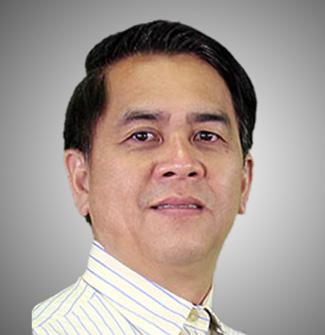
 Jenna Greengold Can Le
Jenna Greengold Can Le

Most people already know and appreciate the capabilities of smart phones, but the possibilities offered by smart spacesuits, uniforms and exercise clothes represent the next frontier. The future of wearable technology just got a big boost thanks to a team of University of Houston researchers who designed, developed and delivered a successful prototype of a fully stretchable fabric-based lithium-ion battery.
The idea for this cutting-edge evolution of the lithium-ion battery came from the mind of Haleh Ardebili, Kamel Salama Endowed Pro-
I WAS INTERESTED IN UNDERSTANDING THE FUNDAMENTAL SCIENCE AND MECHANISMS RELATED TO STRETCHING AN ELECTROCHEMICAL CELL AND ITS COMPONENTS.
- HALEH ARDEBILI
fessor of Mechanical Engineering at UH. “As a big science fiction fan, I could envision a ‘science-fiction-esque future’ where our clothes are smart, interactive and powered,” she said. “It seemed a natural next step to create and integrate stretchable batteries with stretchable devices and clothing. Imagine folding or bending or stretching your laptop or phone in your pocket. Or using interactive sensors embedded in our clothes that monitor our health.”
Some of these ideas are already becoming a reality. However, like all electronics, they need power, which is where the stretchable and flexible batteries come in. A major bottleneck in the development of the next generation of electronics or wearable technology embedded in fabrics is that conventional batteries are generally rigid, which limits functionality of the items, and they use a liquid electrolyte, which raises safety concerns. The traditional organic liquid electrolytes are flammable and can lead to the possibility of the batteries catching fire or even exploding under certain conditions.
The key to the UH research team’s breakthrough lies in the researchers using conductive silver fabric as a platform and current collector.
“The weaved silver fabric was ideal for this since it mechanically deforms or stretches and still provides electrical conduction pathways necessary for the battery electrode to function well. The battery electrode must allow movement of both electrons and ions,” said Ardebili, who is the corresponding author of a paper detailing this research in the Extreme Mechanics Letters. The first author of the paper is Bahar Moradi Ghadi, a former doctoral student who based her dissertation on this research.
By transforming rigid lithium-ion battery electrodes into wearable, fabric-based, flexible, and stretchable electrodes, this technology opens up exciting possibilities by offering stable performance and safer properties for wearable devices and implantable biosensors.
The idea for stretchable batteries occurred to Ardebili several years ago.
“I was interested in understanding the fundamental science and mechanisms related to stretching an electrochemical cell and its components,” she said. “This was an unexplored field in science and engineering and a great area to investigate.”
The science of coupling effects of mechanical deformation and electrochemical performance is an important field and stretchable batteries provide a great vehicle for exploring the fundamental mechanisms.
Ardebili developed her ideas into grant proposals and won several key awards to support her work, including a five-year National Science Foundation CAREER Award in 2013, a New Investigator Award from the NASA Texas Space Center Grant Consortium in 2014 and an award from the US Army Research Lab (ARL) in 2017.
“Although we have created a prototype, we are still working on optimizing the battery design, materials and fabrication,” said Ardebili.
Ardebili is optimistic that the prototype for a stretchable fabric-based battery will pave the way for many types of applications such as smart space suits, consumer electronics embedded in garments that monitor people’s health and devices that interact with humans at various levels. There are many possible designs and applications for safe, light, flexible and stretchable batteries, but there is still some work to be done before they are available on the market.
“Commercial viability depends on many factors such as scaling up the manufacturability of the product, cost and other factors,” she said. “We are working toward those considerations and goals as we optimize and enhance our stretchable battery.” Whether the stretchy batteries end up powering spacesuits or workout clothes or some other innovative application, Ardebili wants them to be reliable and safe. “My goal is to make sure the batteries are as safe as possible,” she said.
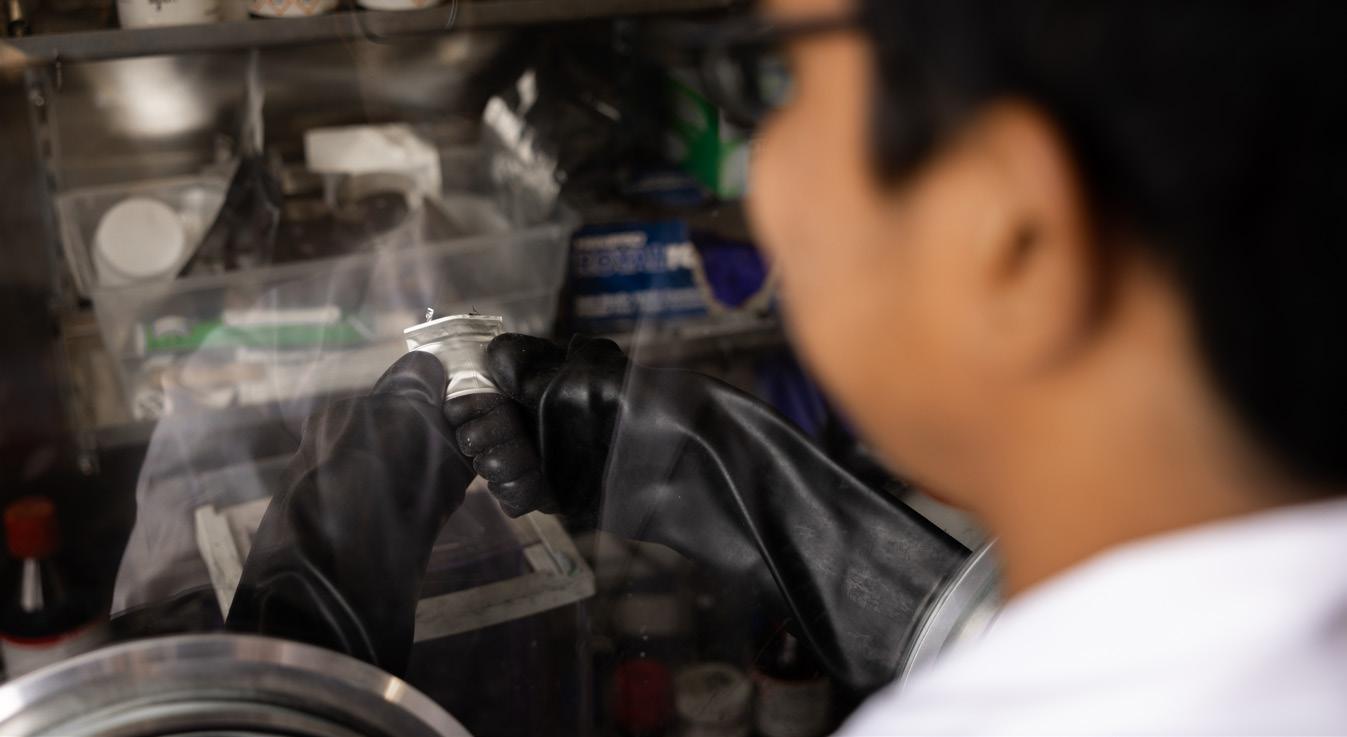
My goal is to make sure the batteries are as safe as possible.
- HALEH ARDEBILI
 Fabric-based battery
Fabric-based battery
In the ongoing quest to unearth the world’s hidden mysteries, University of Houston researchers and archaeology partners have discovered a lost Maya city deep in the jungles of Campeche, on the Yucatan Peninsula, in Mexico.
Notable among the findings were several 50-foot-tall structures, resembling pyramids, and pottery that dates the city to the Late Classic period, between the years 600 and 800.
Though undeniably rare and incredibly fascinating, finding the city, now dubbed Ocomtún, or stone column in Maya, is all in a day’s work for the experts at the National Center for Airborne Laser Mapping (NCALM) at UH.
In other words, it’s what they do.
Their track record includes finding ruins in 2012 in an area of Eastern Honduras where centuries-old legends talk of a “lost white city”; the 2016 mapping of more than 80,000 Maya structures including many previously unknown Maya settlements; and agricultural and defensive structures in the Guatemalan Peten jungle.
In terms of exploration, NCALM researchers get the first bite at the apple. Flying high above sites of interest, their plane armed with airborne light detection and ranging (lidar) equipment, they scan the vast array of landforms.
Lidar allows unprecedented data collection in areas that are extremely difficult to enter on foot, like deep within jungles and rainforests.
“You can compare us to ultrasound technicians. We are the first to see the baby, but the doctor will tell you all about it and confirm the findings,” said Juan Carlos Fernandez-Diaz, co-principal investigator of NCALM, housed in the Cullen College of Engineering, where he is also a research assistant professor of civil and environmental engineering.
Using lidar technology, Fernandez-Diaz and his team shoots hundreds of thousands of laser bursts per second at the ground and measures how quickly those pulses hit the ground and bounce
For Mexico and Central America, we are the premier research center that has been able to do this quickly and affordably. We have over 10 years of these kinds of these discoveries.
- JUAN CARLOS FERNANDEZ-DIAZ

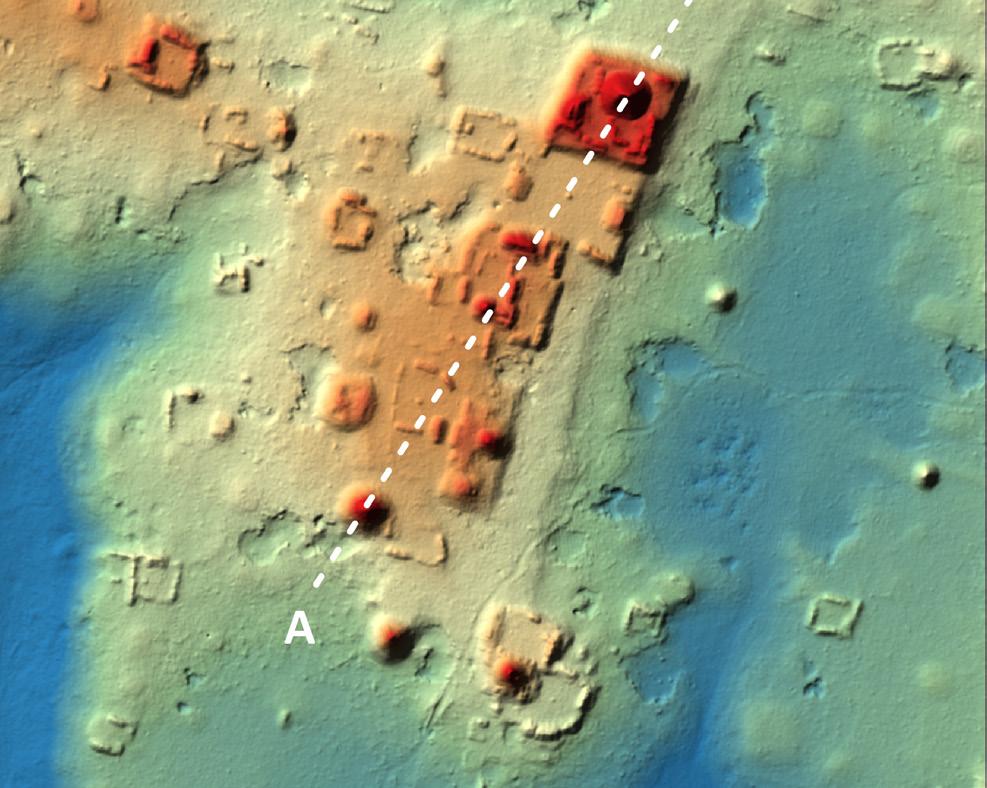
back to their source. Those calculations reveal the exact distance between the plane and the ground. By repeating that process several billion times, the explorers create a three-dimensional map, complete with topographical markings noting rising structures and other hidden gems.
Then the NCALM staff hands over the findings to the archeologists for interpretation. In this project, the lead archeologist was Ivan Sprajc of the Slovenian Academy of Sciences and Arts under the auspices of Mexico's National Institute for Anthropology and History (INAH).
Sprajc confirmed the finding of three plazas complete with large buildings and a ball game field. The team was most surprised that the terrain was elevated and surrounded by wetlands. That’s where they found the pyramid-shaped buildings.
“The site served as an important center at the regional level,” Sprajc said in a statement released by INAH.
The Maya civilization is widely recognized as one of the magnificent societies in the Western Hemisphere. They gained renown for their awe-inspiring pyramid temples and impressive stone structures, which were located in what is now known as southern Mexico, Guatemala, Belize, Honduras and El Salvador.
To deliver the findings, the UH team took only three flights over the region, four hours each. Stunning findings for 12 hours of work, and though modest, Fernandez-Diaz admits NCALM has earned its reputation.
“For Mexico and Central America, we are the premier research center that has been able to do this quickly and affordably. We have over 10 years of these kinds of these discoveries,” Fernandez-Diaz said.
NCALM has been based at UH since 2010, operated jointly with the University of California at Berkeley. Researchers use laser
mapping, satellite data analysis and other technologies to produce high-quality scientific data in a variety of fields, including archaeology, homeland security, environmental studies and natural disaster surveillance.
For Fernandez-Diaz, nothing beats opening a window and peering into another world, century or civilization.
"When we see it on the computer we think, ‘Wow!’ We are seeing these things for the first time in 1,000 years. It’s like time travel to see under the vegetation, to the roads, canals and ponds as they were that long ago,” he said.
 Juan Carlos Fernandez-Diaz
Van Sprajc of the Slovenian Academy of Sciences and Arts under the auspices of Mexico's National Institute for Anthropology and History (INAH) confirmed the finding of three plazas complete with large buildings and a ball game field.
Juan Carlos Fernandez-Diaz
Van Sprajc of the Slovenian Academy of Sciences and Arts under the auspices of Mexico's National Institute for Anthropology and History (INAH) confirmed the finding of three plazas complete with large buildings and a ball game field.
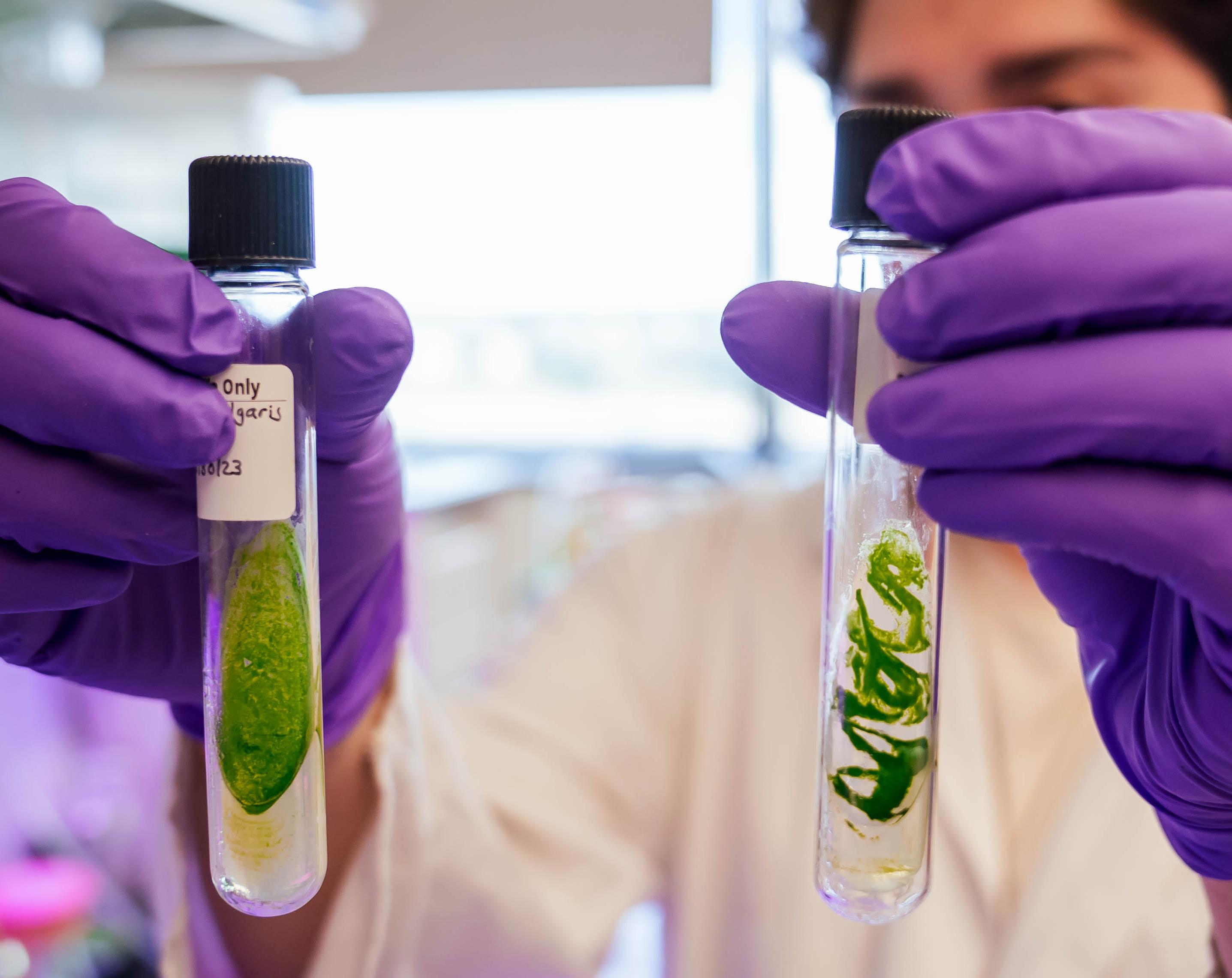
Scientists may be on the verge of taking a big step closer to the net-zero carbon emissions goal, thanks to University of Houston research into algae. Hidden potential is being revealed in the major algae studies at the microbial products lab, located at UH at Sugar Land.
Venkatesh Balan, associate professor of engineering technology in UH’s Cullen College of Engineering’s Division of Technology, is exploring surprising traits among small fresh- and salt-water phototropic (light-sensitive) organisms referred to as microalgae.
Microalgae can sequester carbon dioxide (CO2) from the atmosphere. But it is its
ability, through a series of processes, to convert its captured CO2 into mass-produced proteins, lipids and carbohydrates that most interests Balan and his team of researchers.
“This green process goes beyond climate issues. For example, it may even transform the way we produce our food,” Balan said.
He has been studying algae for seven years. His research evaluates the potential of using microalgae to treat wastewater and use algal biomass to produce food, fertilizers, fuels and chemicals. Algae grown in freshwater treatments, such as spirulina, is being used in health supplements
We are coming up with the alternate approach of using algae to fix the CO2 then using the carbon to make bioproducts that are useful to mankind.- VENKATESH BALAN
and cosmetics. In the future, microalgae could be used as sustainable feed stock for producing biofuels and biochemicals that could lessen dependency on fossil fuels.
Microalgae’s most immediate superpower, however, is its potential to play a key role in the answer to the worldwide global warming.
“We are experiencing climate change. This summer’s 100-degree heat that lasted three months here in Texas, and in several other parts of the world, had never been seen before. That is a testament to climate change. No one can deny it,” Balan said.
The greenhouse effect – in which certain gases are blanketing Earth’s atmosphere, trapping heat closer to the planet – speeds up the warming. Greenhouse gases can comprise any gas that absorbs infrared radiation. In Earth’s atmosphere, CO2 and chlorofluorocarbon are the main factors.
“There is much interest among lawmakers and policymakers, even among companies that emit greenhouse gases, to find alternatives, especially for those emitted from industry,” Balan said.
But industry cannot be blamed for all the pollution problems that haunt us, he said. “On your table or in your pantry, you see food products. What’s harder to visualize are the greenhouse gasses emitted by the orchard that grows the fruit, the factory that makes the breakfast cereal, the transportation that brings the cookies to your neighborhood, even your own commute to buy the food. It adds up, but the problem is easy to ignore because we can’t see it. Yet all consumers contribute, in our own way, to the greenhouse effect.”
So, if CO2 and other chemicals are damaging our climate, how do we deal with the excess CO2 in our atmosphere? Until now, most of the scientific world has discussed capturing CO2 and burying it, possibly under an ocean or other large body of water, which is an expensive, energy intensive proposition.

“We are coming up with the alternate approach of using algae to fix the CO2 then using the carbon to make bioproducts that are useful to mankind,” Balan explained.
With research assistant Masha Alian, he recently discovered algae can be used as substrate to produce fungus, another useful tool in achieving net zero carbon footprint. The symbiotic relationship between algae and fungi can be found in lichen, which is a composite organism – part algae, part fungi. A common site in rural Texas and elsewhere, lichen (sometimes misnamed tree moss) is a preferred food of deer and other animals that nibble it from the trunks of trees where it grows in the wild.
In Balan’s lab, researchers are trying to mimic how lichen grows in nature. “The algae produce oxygen, and the fungi stabilizes CO2 and produces oxygen,” Balan explained. As a bonus, much of the food bed comprised of algae and fungus could be converted into healthy food products. Balan is lead author of the article “Potential of Using Microalgae to Sequester CO2 and Processing to Bioproducts.” He is joined by coauthors: UH researchers James Pierson and Hasan Husain; Sandeep Kimar, Old Dominion University, Virginia; Christopher Saffron, Michigan State University; and Vinod Kumar, Cranfield University, U.K.
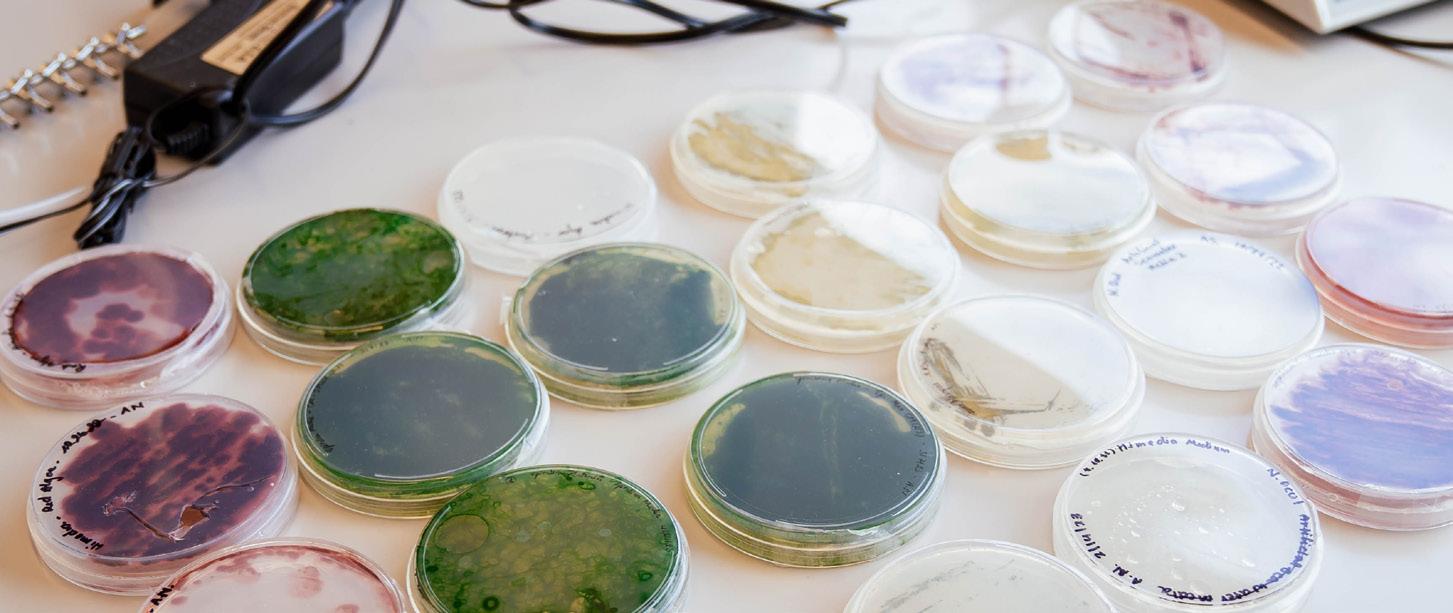
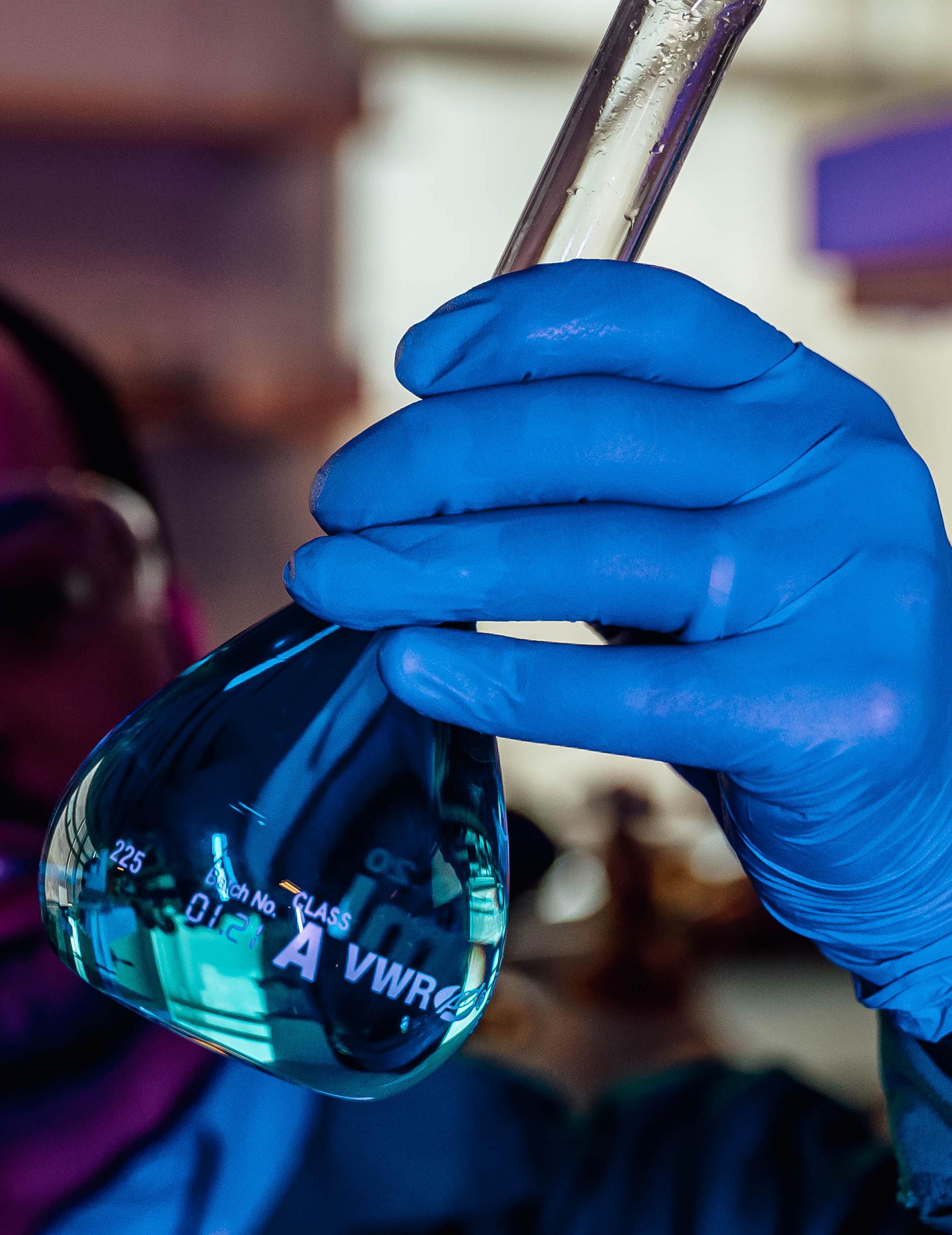
As researchers around the world race against time to develop new strategies and technologies to fight climate change, a team of scientists at the University of Houston is exploring one possible way to directly reduce the amount of carbon dioxide in the environment: Negative emissions technologies (NETs).
Mim Rahimi, assistant professor of environmental engineering at the Cullen College of Engineering is leading the development of an emerging NET called electrochemical direct ocean capture (eDOC), which helps the ocean cleanse itself of harmful carbon dioxide. The concept is detailed in a paper published in the journal Energy and Environmental Science
“Electrochemical direct ocean capture amplifies the ocean’s ability to absorb carbon, sidestepping the expensive sorption process typical in many current strategies,” Rahimi said. “The promise of eDOC is undeniable, but scaling it, optimizing costs and achieving peak efficiency remain challenges we’re actively addressing.”
Earth’s carbon dioxide is stored in the atmosphere and the terrestrial biosphere, but the vast majority is found in our oceans. According to World Ocean Review, the planet’s five oceans contain 38,000 gigatons of CO2. Furthermore, United Nations climate experts say oceans absorb 25 percent of all carbon dioxide emissions and capture 90 percent of the excess heat generated by those emissions, making it a vital buffer against climate change.
Funded by a $250,000 grant from the U.S. Department of Energy, Rahimi and his team are working to create electrochemical tubes to remove dissolved inorganic carbon from synthetic seawater. Preliminary research on the project was sponsored by UH’s Center for Carbon Management in Energy.
Current efforts to remove carbon dioxide from the ocean mainly involve complex processes like electrolysis, which attempt to either turn dissolved inorganic carbon into gas or convert it into magnesium or calcium carbonates. However, these techniques are energy-intensive and costly due to the use of rare and expensive materials, such as platinum and specialized membranes that easily clog, degrading their performance.
The researchers’ alternative strategy eliminates the need for those costly membranes. Instead, it relies on a process that adjusts the acidity of seawater using affordable and environmentally friendly electrode materials. The system not only promises to be more cost effective, but also significantly reduces the environmental impact of traditional carbon removal efforts.

“While membrane-based systems showed promise, they come with challenges,” said Prince Aleta, a doctoral student in Rahimi’s lab. “We’re using electricity instead of thermal-based methods, and our current trajectory emphasizes systems without membranes for heightened efficiency.”
One of the key advantages of this innovation is its versatility and scalability. The system can easily be integrated into existing on-shore infrastructure, such as desalination plants, as well as off-shore locations like oil rigs.
“While eDOC won’t single-handedly turn the tide on climate change, it enriches our mitigation toolkit,” added Rahimi. “In this global challenge, every innovative approach becomes invaluable.”


 Rahimi and his team are working to create electrochemical tubes to remove dissolved inorganic carbon from synthetic seawater.
Rahimi and his team are working to create electrochemical tubes to remove dissolved inorganic carbon from synthetic seawater.

Chandra Mohan, Hugh Roy and Lillie Cranz Cullen Endowed Professor of biomedical engineering, is reporting the first use of the powerful imaging mass cytometry (IMC) to examine the kidneys of patients with lupus (systemic lupus erythematosus), an autoimmune disease that can affect multiple organs and become fatal, and to diagnose lupus nephritis (LN) in those patients.
LN is a severe inflammation of the kidneys and a major cause of death in lupus patients. Up to 60 percent of SLE patients will develop renal symptoms with 5 to 20 percent of those patients progressing to end stage kidney disease within 10 years.
IMC can showcase the presence of as many as 37 different proteins in human tissue simultaneously and marks a significant leap beyond the limitations of the traditional approach, which allowed the examination of only one to three distinct proteins within a specific tissue. Often in combination with machine learning algorithms, IMC has been used to characterize the cellular makeup of the human kidney, distinguish between cell types and identify novel markers for disease.
“Due to unique advantages that allow high-dimensional tissue profiling, we postulated imaging mass cytometry may shed nov-
el insights on the molecular makeup of proliferative lupus nephritis,” reports Mohan in the journal Clinical Immunology. “This study interrogates the expression profiles of 50 target proteins in lupus nephritis and control kidneys.”
Currently, the standard for LN diagnosis is a painful renal biopsy and study of the tissues that are taken out to determine disease outcome and treatment response.
“However, there is low inter-pathologist concordance when determining classes and pathology indices which can lead to misclassification of LN, improper disease treatment, and sub-optimal patient outcomes,” said Mohan. “Renal biopsies also provide a limited amount of tissue, restricting the type and extent of analysis that can be performed on a sample.”
THIS STUDY INTERROGATES THE EXPRESSION PROFILES OF 50 TARGET PROTEINS IN LUPUS NEPHRITIS AND CONTROL KIDNEY.
- CHANDRA MOHAN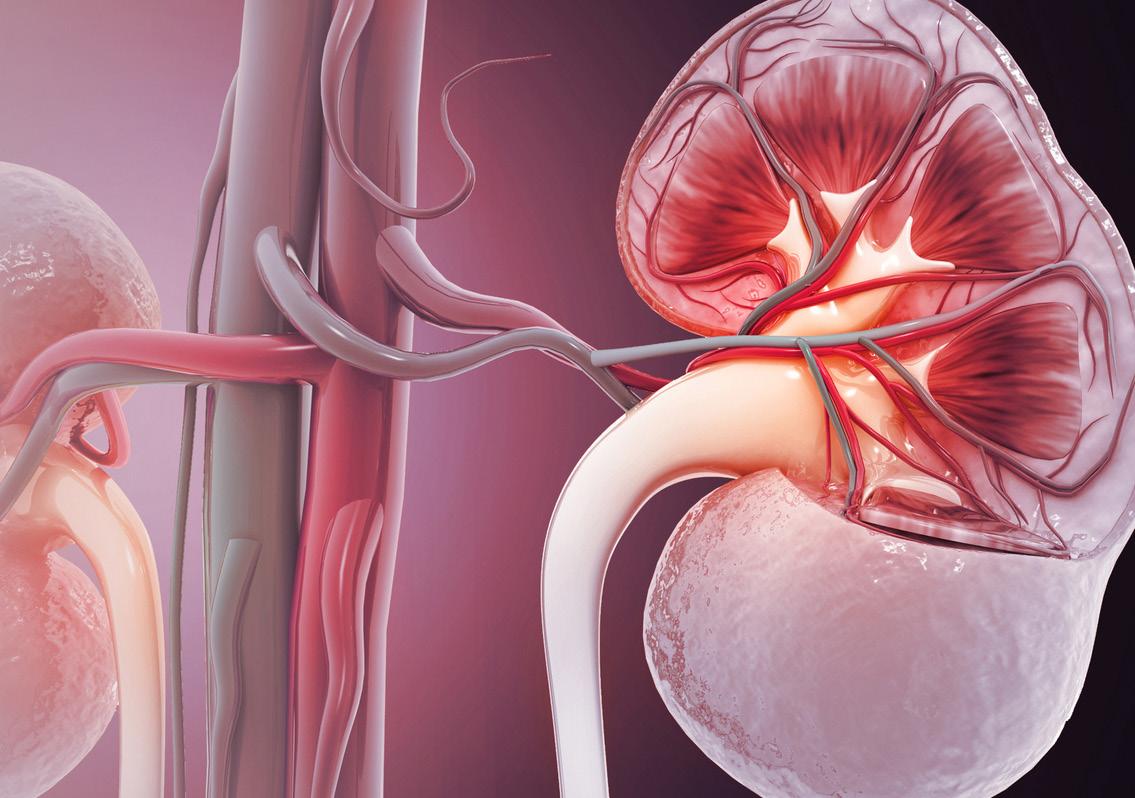

There are several major advantages to IMC including its ability to pinpoint locations of tissues for further study. During the IMC research and examination of 21 patients, Mohan found both decreased and increased disease markers that point to renal disease and that a subset of glomeruli, (the tiny network of blood vessels that work as cleaners of the kidney) may be enlarged in some LN patients.
“Decreased expression of epithelial markers along with an increased expression of mesenchymal markers, also termed epithelial to mesenchymal plasticity (EMP) have been reported in kidney biopsies from patients with renal diseases, including LN,” said Mohan. “It is very likely that the parietal epithelial cells encircling the glomeruli may be an additional site of EMP in proliferative LN, though this needs to be verified using additional markers. EMP could certainly affect additional cells in LN kidneys, but this needs to be systematically investigated.”
The studies were carried out by postdoctoral fellow Crosslee Titus, together with Mohan’s team at UH. Also involved in the research are teams led by Shu-Hsia Chen, Houston Methodist Research Institute; Minghui Zhao, Peking University First Hospital, Beijing, PR China; and Anthony Chang, The University of Chicago.
Imagine owning a wearable sensor that can monitor your health at every moment in real-time and potentially detect certain cancers in your body before they start affecting you. Through a HEALTH-RCMI Pilot Program Award, University of Houston’s Zhengwei Li will develop a wearable biosensor that promises to detect colorectal cancer and provide real-time health monitoring through your smartphone.
“I hope to make some wearable electronic device to detect cancer which will then connect to our smartphones,” Li said. “We can make this device to help all under-represented communities, so they can have access. Ultimately, we can reduce the health disparities. I hope that this device will be accessible to every family.”
Through support from HEALTH-RCMI, Li has spearheaded a new study, "Develop-
ment of Ultrasensitve Smart Bioelectronic Sensors for Colorectal Cancer Prevention and Health Disparities Reducing among Black Americans." This initiative was funded $50,000 by NIMHD and HEALTH-RCMI [PI: Dr. Ezemenari Obasi].
Li is an assistant professor and Presidential Frontier Faculty Fellow in the Department of Biomedical Engineering at the Cullen College of Engineering. His innova-
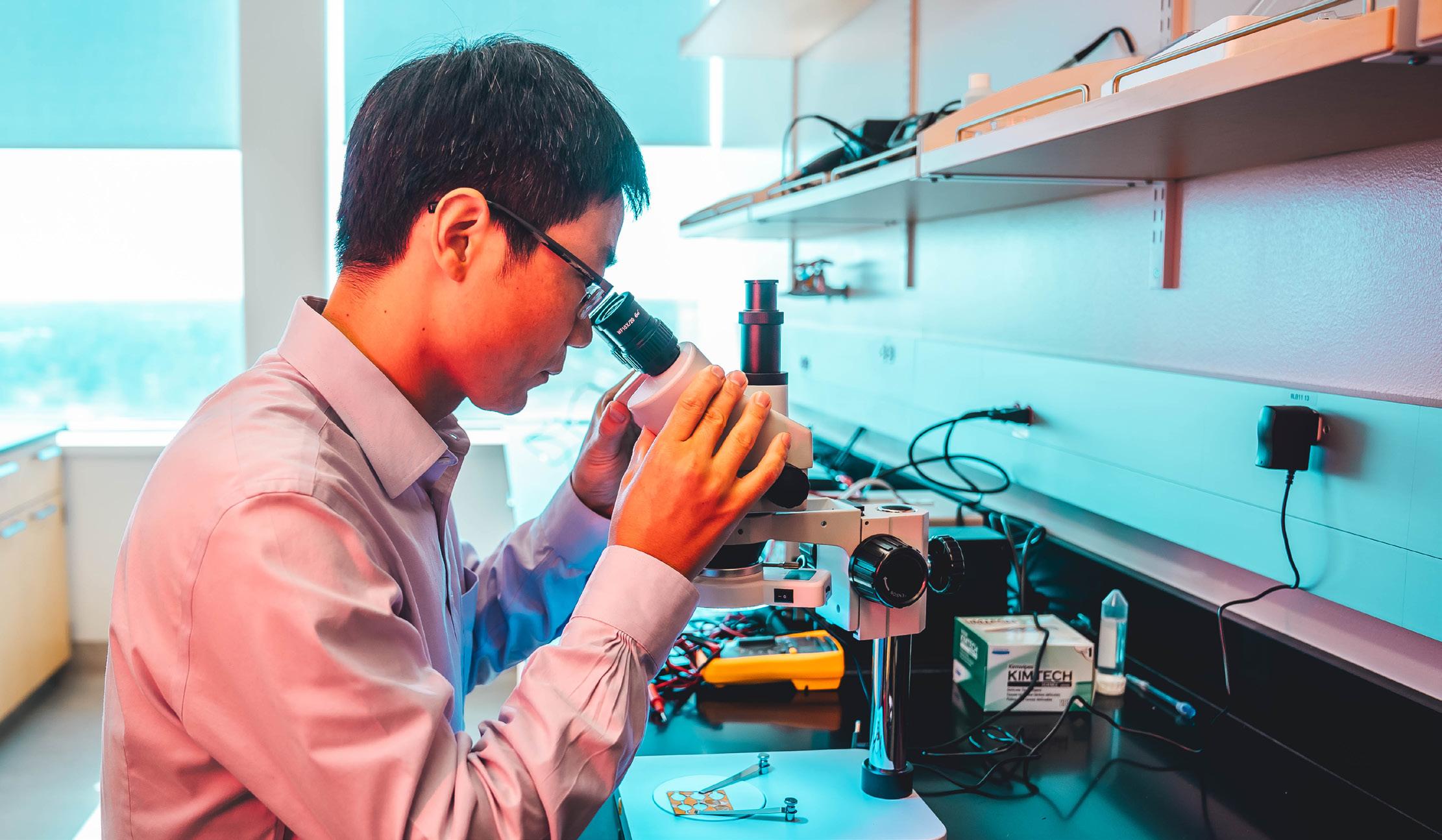

tive research is supported through a joint appointment at the Tilman J. Fertitta Family College of Medicine at the University of Houston.
What deeply resonates with Li is the opportunity to use his biomedical expertise to improve oncology outcomes in marginalized communities. According to the American Cancer Society, colorectal cancer disproportionately impacts the African American community. African Americans are 20 percent more likely to get colorectal cancer and about 40 percent more likely to die from it than other groups.
“Colorectal cancer is the third cause of cancer related deaths in the U.S., according to the American Cancer Society,” Li said. “They estimate more than 150,000 cases this year in the U.S. Black Americans and minorities are more likely to be impacted by colorectal cancer.”
Li’s vision about a cancer-free world is an ambitious one. He is determined to reduce cancer disparities by creating devices that can remotely sense the biophysical signals of certain cancers.
“There are physical biomarkers about colorectal cancer, such as tissue stiffness,” Li explained. “With colorectal cancer, the tumor tissue has higher stiffness than normal tissues, so it is important to get biophysical signaling, such as tissue stiffness.

My expertise focuses on creating devices so that gives me an opportunity to use this tool to gather biophysical signaling so to study this important research topic. We can use this tool for the diagnosis, and this sensor can be used to detect this biomarker signaling.”
Notably experienced in the development of new mobile sensors, Li has previously achieved a few milestones in the sphere of cancer detection. Through the crucial support of two department chairs, Li credits the insight and guidance of John S. Dunn Endowed Chairman Metin Akay from Biomedical Engineering Department in the Cullen College of Engineering, and professor and chairman Kevin Rowland from Biomedical Sciences Department in College of Medicine.
“In the previous project, we used a skin type sensor that we put on the skin to quantitatively get a hydration level of the skin by using the smartphone to read the hydration level,” Li said. “I’m inspired by this work, so I want to make wearable electronic devices for cancer detection.”
Li plans to broaden the scope of his research to include the early detection of other cancers.
"Colorectal cancer is such a deadly cancer,” Li said. “My research in this area may provide some solutions for early detection. I hope to make some wearable devices--not only for colorectal cancer but also for the other types of cancer, like breast cancer and other types of cancer. I hope it will be accessible to every family—to reduce the health disparities among the minority populations.”
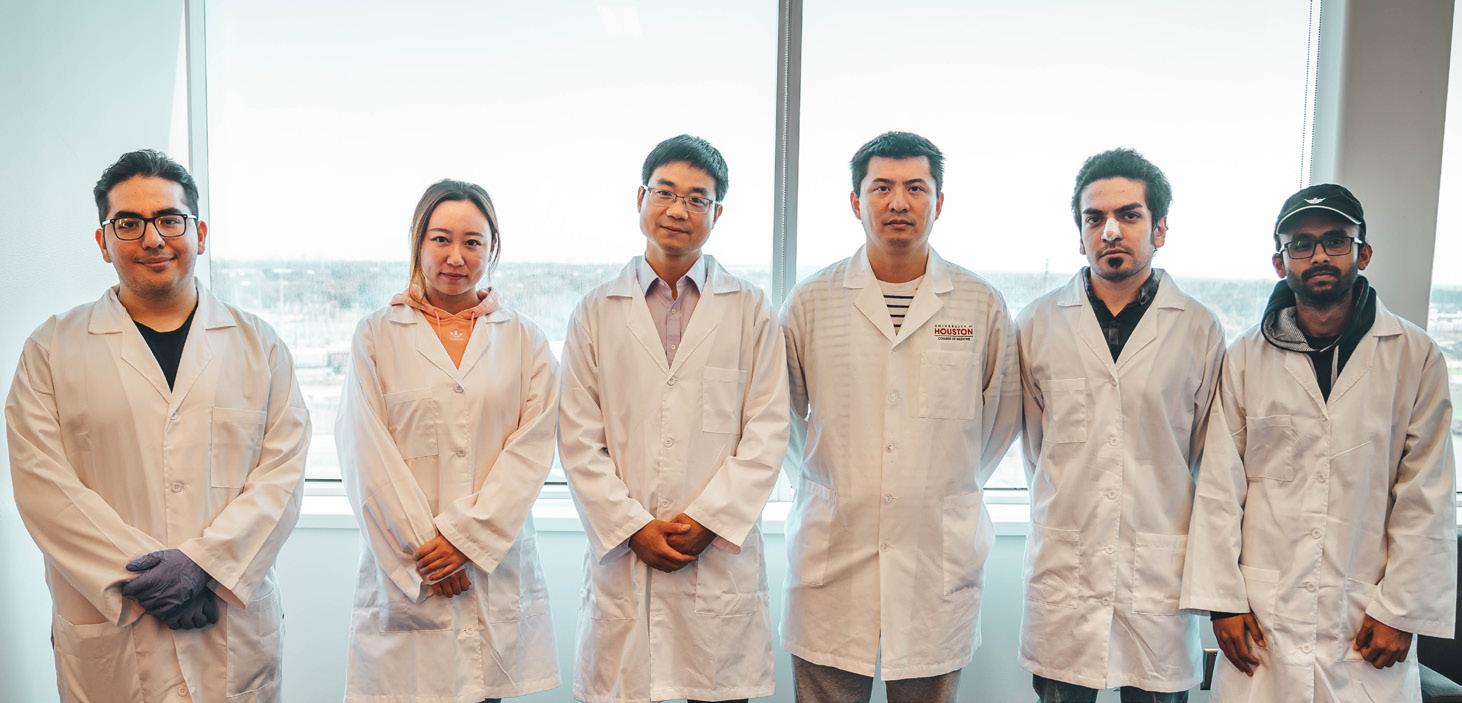 Research students working in Li's laboratory.
Research students working in Li's laboratory.
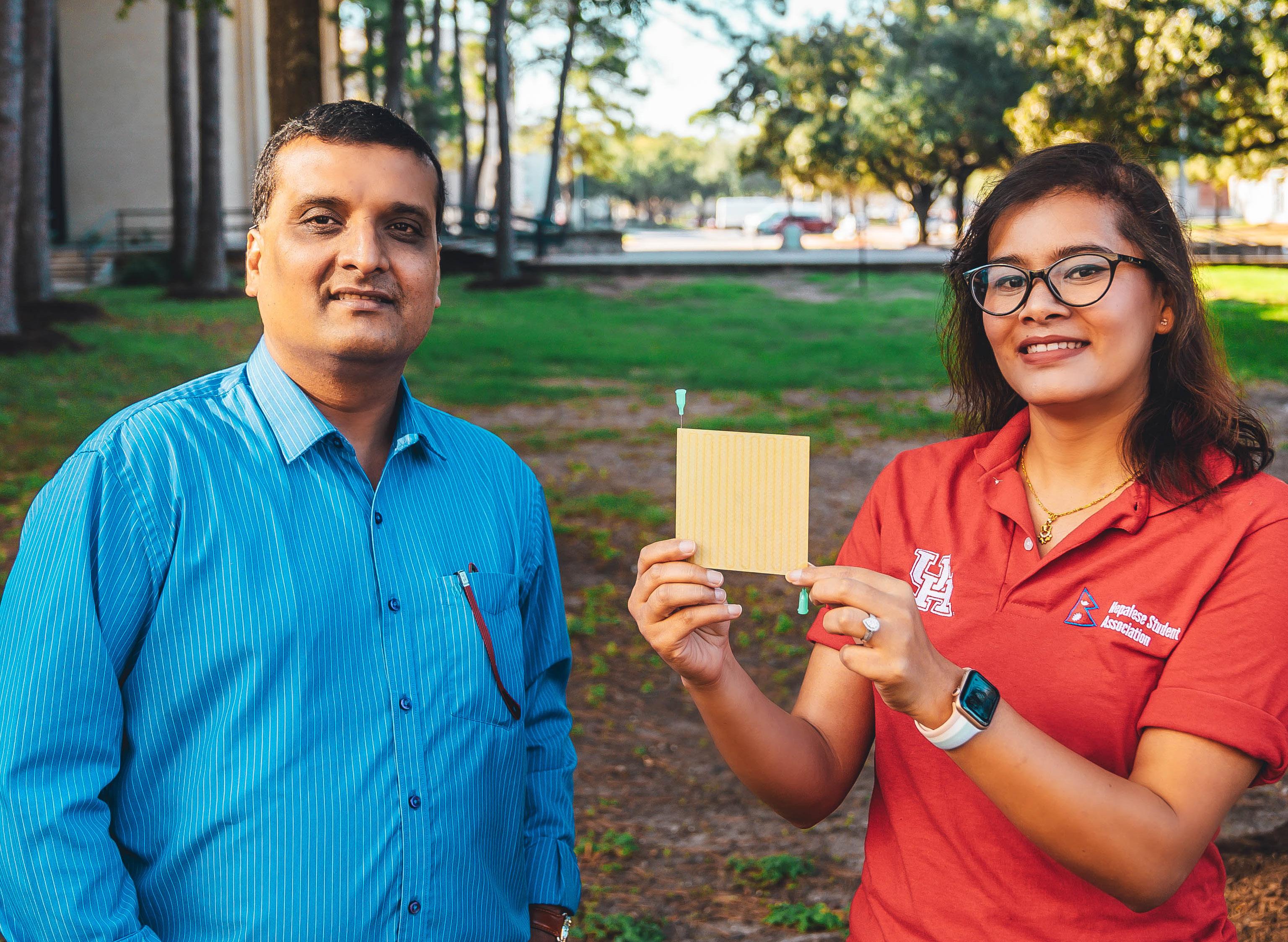

In an attempt to better regulate temperature in a variety of synthetic structures and gain a deeper understanding of biological systems, a newly published paper by researchers from the Cullen College of Engineering’s Civil and Environmental Engineering Department finds some surprising conclusions about using fluids to control temperature.
“Configuration-independent thermal invariants under flow reversal in thin vascular systems” was published recently in PNAS Nexus. Its lead author is Kalyana Nakshatrala, associate professor and associate chairman of the Civil and Environmental Engineering Department. Additional authors include Kripa Adhikari, a doctoral student of Nakshatrala at UH; Jason Patrick, an assistant professor in the Department of Civil, Construction, and Environmental Engineering at North Carolina State University; and Sandeep Rajendra Kumar, a student of Patrick.
Describing the initial stages of their research as curiosity-based, Nakshatrala said it was inspired by how living organisms control their internal temperature.
“Much like how mammals and birds regulate their body temperature through the circulation of blood in their vascular systems, we aim to mimic a similar mechanism in the synthetic world,” he said. “We want to modulate temperature by flowing a fluid through a network of vesicles embedded within the body. Surprisingly, we found several symmetries or invariances – Swapping the locations of the fluid’s inlet and outlet does not alter thermal efficiency.”
“What is remarkable is that the whole work started from mathematical scribbles on a yellow pad. Initially, we could not believe the 'surprising invariants' that the mathematical derivations revealed,” he said. “This is partly because the results are counterintuitive. Second, a minor mistake in the derivation, say a sign mistake, could give rise to a completely different outcome.”
Worried there could be an alternative but a simpler explanation to the surprising results, like a silly sign mistake in the derivation,
What is remarkable is that the whole work started from mathematical scribbles on a yellow pad. Initially, we could not believe the 'surprising invariants' that the mathematical derivations revealed
- KALYANA NAKSHATRALA
Nakshatrala shared his findings with Gemunu Gunaratne, Moores Professor and the former chairman of the University of Houston's Department of Physics.
Gunaratne, who works on symmetries and invariances, also acknowledged the results were counterintuitive. He encouraged publishing the results and suggested the phrase “configuration-independent invariants,” which the authors used in the paper’s title.

“Whether ‘configuration-independent’ features have a function is a question that is not often addressed,” Gunaratne said. “In an impressive study, Professor Nakshatrala’s group demonstrates that in the case of thermal regulation, they do. This observation may have far-reaching consequences and may be useful in the optimal design of cooling in computers, robotics, and implantable devices, all of which critically need transport of heat away from a central device.”
Nakshatrala’s initial uneasiness disappeared eventually.
He added, “After multiple derivations, numerical simulations, and finally experimental evidence made us comfortable with the result.” He also noted that the work is synoptic, multi-disciplinary and inter-institutional. While the team at UH developed those “mathematical scribbles” and “computer games,” the researchers at N.C. State ran the experiments to validate the results.
Adhikari was glad to be able to contribute to the research with Nakshatrala.
“I am deeply privileged and fortunate to have had the chance to contribute to this pioneering study,” she said. “Throughout the process of creating the paper, I had a great opportunity to acquire a wealth of knowledge, not just in terms of the research itself, but also with regard to the art of scientific writing, thanks to my advisor, Dr. Nakshatrala. The insights and expertise I have gained from this experience will undoubtedly prove invaluable in my current and future research endeavors.”
Nakshatrala and Adhikari said, “Several related research initiatives are currently underway utilizing and extending the findings presented in the paper. These endeavors span mathematical analysis, design optimization, and additive manufacturing with an overarching goal of mimicking nature and bringing various thermal regulation and active-cooling strategies to the synthetic world. Stay cool!”

The U.S. Department of Energy recently announced a $10 million investment in three projects to develop novel technologies to manufacture high-performance superconducting tapes in the United States. Two of the projects are built on the foundations of cutting-edge research from the University of Houston.
The DOE values superconductivity because it means zero wasted electricity. Superconductivity, found only in certain materials, allows direct electric current
to be conducted with zero resistance and without energy loss. Widely available low cost, high-temperature superconducting (HTS) tapes are used for a broad range of clean energy applications that move the country closer to a net-zero future, including in transmission cables, the grid, electric-based motors and generators, nuclear fusion reactors, electric aviation and more. However, demand for HTS tapes is outstripping supply, the cost is high, and the bulk of the manufacturing is occurring outside the U.S.
The funding, through the DOE’s Advanced Research Projects Agency-Energy’s (ARPA-E) Novel Superconducting Technologies for Conductors Exploratory Topic, will help boost different types of superconductive technologies.
UH’s Selva Research Group received $2 million for a three-year project, titled “Low-Cost, High-Rate Fabrication of High-Performance, Uniform, Long REBCO Conductors.” Their work focuses on scaling up the manufacture of the team’s

THESE AWARDS RECOGNIZE THE RELEVANCE AND QUALITY OF THE RESEARCH AT UH AND OUR COMMITMENT TO MAKING A MEANINGFUL IMPACT BY ADDRESSING SOCIETY’S NEEDS AND CHALLENGES BY TRANSITIONING INNOVATINS OUT OF RESEARCH LABS AND INTO THE REAL WORLD.
holds in Albany, N.Y., and now is used by more than 200 institutions worldwide.
The Selva Group has demonstrated its HTS tape’s electric current-carrying-performance is three times better than the tapes available on the market. His research group works with many partners to use its HTS tape to make small-scale prototypes of magnets, coils and cables to incorporate in several applications. Now, the team is focusing its attention to make the manufacturing process for its tape more efficient and consistent.
“Even though our superconducting tape is three times better than today’s industry products, for us to be able to take it to full-scale commercialization, we need to produce it faster and at a lower cost while maintaining its high quality,” Selvamanickam said. “This funding is to address this challenge and it’s an important step forward towards commercialization of our technology.”
UH Vice President for Energy and Innovation Ramanan Krishnamoorti is proud of the work happening at UH, a Carnegie-designated Tier One Research University.
- RAMANAN KRISHNAMOORTIhigh-temperature superconductor tape to implement the technology for clean energy applications. The project will scale up the advanced metal organic chemical vapor deposition (MOCVD) process developed by the team and address key metrics such as speed and cost of production, and uniformity of tape performance.
Venkat Selvamanickam, M.D. Anderson Chair Professor of Mechanical Engineering and director of the Advanced Manufacturing Institute, is recognized globally for his research to develop better manufacturing technologies for thin film superconductor tape. His team was the first to manufacture the thin film superconductor tape, which was used in 2008 to power 25,000 house -
“These awards recognize the relevance and quality of the research at UH and our commitment to making a meaningful impact by addressing society’s needs and challenges by transitioning innovations out of research labs and into the real world,” Krishnamoorti said.
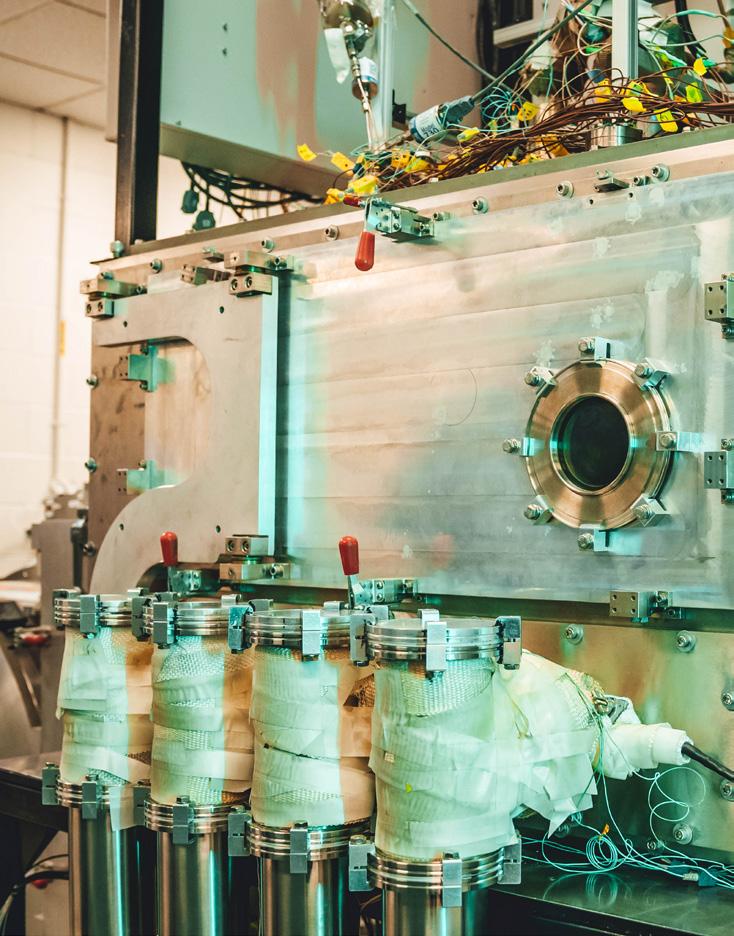
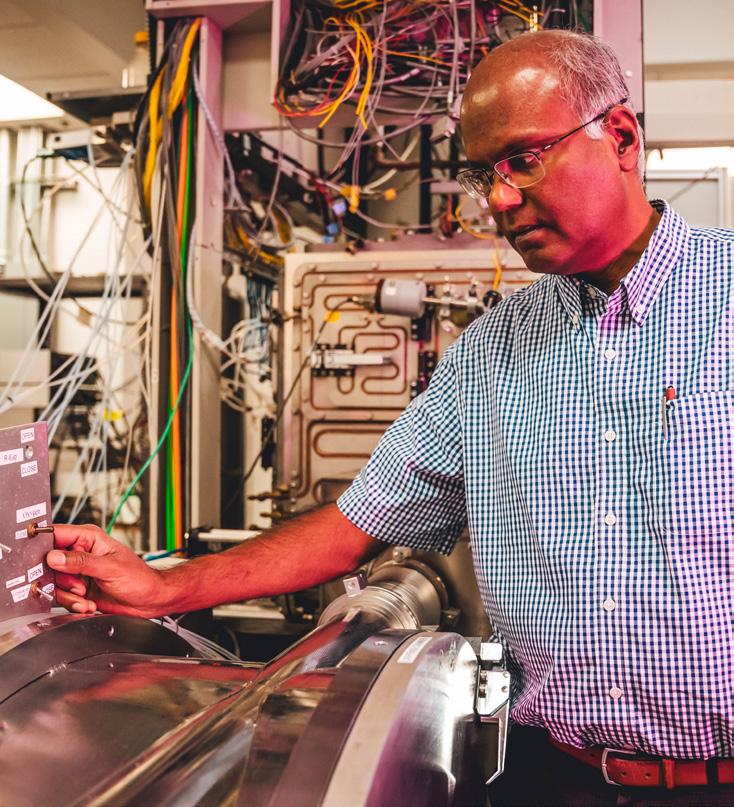
 Venkat Selvamanickam
Conductivity-enhanced wires can lower costs and improve grid performance — including resilience against extreme weather events.
High-performance superconductor tapes can maximize next-generation energy storage technologies and support electrification for energy-intensive sectors leading to a clean energy economy.
Venkat Selvamanickam
Conductivity-enhanced wires can lower costs and improve grid performance — including resilience against extreme weather events.
High-performance superconductor tapes can maximize next-generation energy storage technologies and support electrification for energy-intensive sectors leading to a clean energy economy.

BY SALLY STRONG

A new research center led by the University of Houston is helping prevent potential cyberattacks that could threaten to impede the safe and efficient movement of people and goods in the United States and throughout the world.
CYBER-CARE – the Transportation Cybersecurity Center for Advanced Research and Education – is a U.S. Department of Transportation (USDOT) University Transportation Center (UTC), Tier 1. The center is supported by a $2 million USDOT grant for its first year with anticipated total federal funding of $10 million over five years.
“We all use transportation. Therefore, maintaining our transportation system’s cybersecurity is a crucial goal. Any security breaches or failures could have significant consequences for this country and its cyber-physical systems, even our quality of life,” said Yunpeng “Jack” Zhang, associate professor in the Department of Information and Logistics Technology at the UH Cullen College of Engineering and the center’s director.
“Our goal to make our intelligent transportation system (ITS) safer for all road users. That aligns well with the USDOT’s strategic goal of improving safety,” Zhang explained. “We also will promote interdisciplinary research and education across the transportation and cybersecurity domains.”
Joining UH in the consortium are Embry-Riddle Aeronautical University (ERAU); Rice University (RICE); Texas A&M University-Corpus Christi (TAMU-CC); University of Cincinnati (UC); and University of Hawai‘i at Manoa (UHM).
The teams will establish a fundamental knowledge base and explore advanced theories of how to best mitigate impacts of potential large-scale cyberattacks on transportation infrastructure.
CYBER-CARE will focus on four goals:
•Protecting vehicle control systems that perform safety-critical functions.

Once this tiny “smart car” is programmed with data, it can simulate several types of vehicles and point out weak points that could be susceptible to cyberattacks.
•Detecting and responding to potential cyber incidents involving U.S. traffic networks
•Building a framework that incorporates cyber-resilience and enables rapid recovery after cyber incidents.
•Disseminating information as a resource in the development of industry-wide best practices
In their studies, the researchers will consider various types of threats.
“In one example, in-vehicle networks can be vulnerable to failures or attacks on individual components, such as feeding an individual vehicle’s onboard computer incorrect commands in a way that compromises traffic safety,” Zhang explained.
Or a threat might have a larger, system-wide focus with a DoS (denial of service) or DDoS (distributed denial of service) attack.
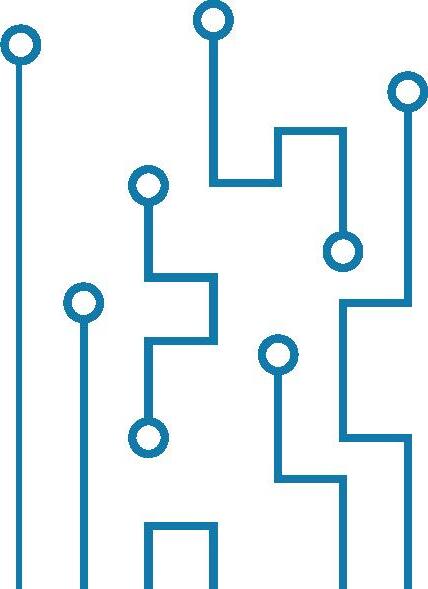
“In a DoS example, an attacker might repeatedly send useless data to distract a busy computer server in a city’s traffic control center from fulfilling the critical jobs it is needed to do. Or the attacker might escalate to a DDoS attack – a distributed denial of service – by coordinating many computers to send millions, maybe trillions of useless data requests to a city traffic center computer server, ef-
fectively locking it out of its required flow of work,” he said.
It is estimated that cybercrimes of all forms cost the global economy more than $1 trillion in 2020. Those costs are estimated to reach $10.5 trillion annually by 2025.
The U.S. Bureau of Labor Statistics estimates that cybersecurity jobs could grow by 31% over the next decade, a confirmation of the need for research and training.
“What we learn from the CYBER-CARE research projects will help inform policy decisions and allocation of public resources. We are in a position to accelerate industry collaboration, foster new technologies and provide industry professionals with the skills and career development to become leaders in their fields,” Zhang said.
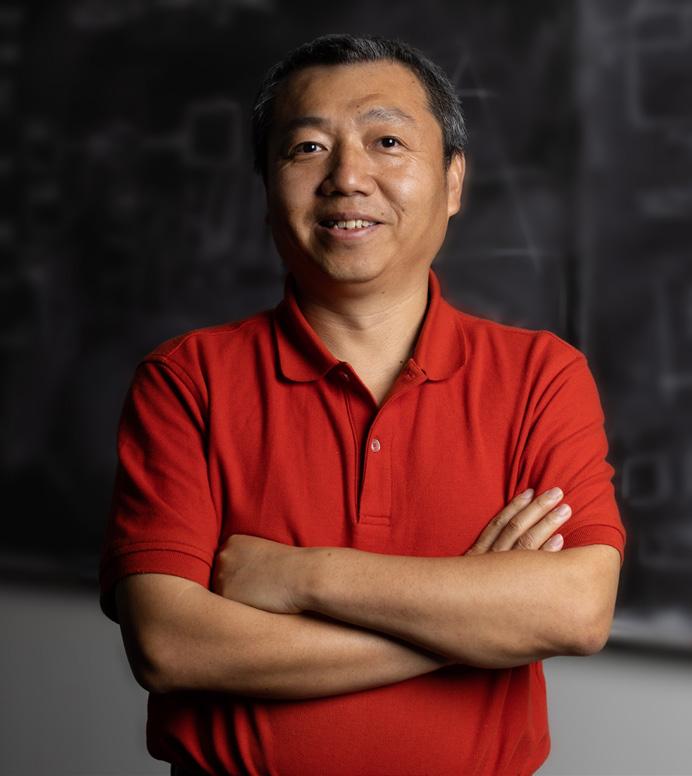



With an increasing number of severe accidents in the global oil and gas industry caused by damaged pipelines, University of Houston researchers are developing an autonomous robot to identify potential pipeline leaks and structural failures during subsea inspections. The transformative technology will make the inspection process far safer and more cost effective, while also protecting subsea environments from disaster.
Thousands of oil spills occur in U.S. waters each year for a variety of reasons. While most are small, spilled crude oil can still cause damage to sensitive areas such as beaches, mangroves and wetlands. When larger spills happen, pipelines are often the culprit. From 1964 through 2015, a total of 514 offshore pipeline–related oil spills were recorded, 20 of which incurred spill volumes of more than 1,000 barrels, according to the Bureau of Ocean Energy Management.
The timely inspection of subsea infrastructure, especially pipelines and offshore wells, is the key to preventing such disasters. However, current inspection techniques often require a well-trained human diver and substantial time and money. The challenges are exacerbated if the inspection target is deep underwater.
The SmartTouch technology now in development at UH consists of Remote Operated Vehicles (ROVs) equipped with multiple stress wave-based smart touch sensors, video cameras and scanning sonars that can swim along a subsea pipeline to inspect flange bolts – bolted connections have accelerated the rate of pipeline accidents that result in leakage, according to the Bureau of Safety and Environmental Enforcement (BSEE).
The BSEE is funding the project with a $960,493 grant to UH researchers Zheng Chen, Bill D. Cook Assistant Professor of Mechanical Engineering and Gangbing Song, John and Rebecca Moores Professor of Mechanical Engineering, who are working in collaboration with Oceaneering International and Chevron.
“By automating the inspection process with this state-of-the art robotic technology, we can dramatically reduce the cost and risk of these important subsea inspections which will lead to safer operations of offshore oil and gas pipelines as less intervention from human divers will be needed,” said Chen, noting that a prototype of the ROV has been tested in his lab and in Galveston Bay. The experiments demonstrated the feasibility of the proposed approach for inspecting the looseness of subsea bolted connections. Pre-
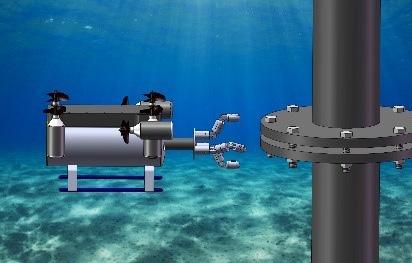
Rendering of the SmartTouch technology now in development.
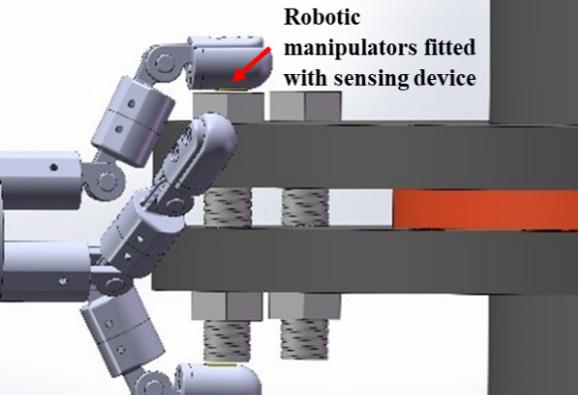
liminary studies were funded by UH’s Subsea Systems Institute.
Oil and gas pipelines fail for a variety of reasons including equipment malfunctions, corrosion, weather and other natural causes, or vessel-related accidents which account for most large leaks. Toxic and corrosive fluids leaked from a damaged pipe can lead to devastating environmental pollution.
“Corrosion is responsible for most small leaks, but the impacts can still be devastating to the environment. Therefore, our technolo-
gy will be highly accurate in monitoring corrosion and will also help mitigate the chances of pipeline failure from other factors,” said co-principal investigator Gangbing Song, who has conducted significant research in piezoelectric-based structural health monwitoring. His prior research efforts include numerous damage detection applications, such as crack detection, hydration monitoring, debonding and other structural anomalies.
The UH researchers are collaborating with Oceaneering International, an industrial leader in ROV development, non-destructive testing and inspections, engineering and project management, and surveying and mapping services. Additionally, Chevron, a major oil and gas operator, will evaluate the technology’s future commercialization.
The SmartTouch sensing solution will open the doors for inspection of other kinds of subsea structures, according to the researchers, by forming a design template for future robotic technologies.
“Ultimately, the project will push the boundaries of what can be accomplished by integrating robotics and structural health monitoring technologies. With proper implementation, the rate of subsea pipeline failure and related accidents will decrease, and subsea operations will be free to expand at faster rate than before,” added Chen.
Our technology will be highly accurate in monitoring corrosion and will also help mitigate the chances of pipeline failure from other factors.
 - GANGBING SONG
- GANGBING SONG
 BY ALEX KEIMIG
BY ALEX KEIMIG
Abdul Latif Khan, an assistant professor in the Cullen College of Engineering's Technology Division's Department of Engineering Technology, has received a research grant from the USDA to purchase instruments that will allow for the real-time monitoring of photosynthesis.
This grant will help monitor and record a given plant's photosynthetic processes in real-time, providing an inside look into the potential of plant health and growth.This is crucial in the fight against food insecurity and successes in agricultural productivity as climate change continues to impact their production.
Also contributing to the project are co-principal investigator associate professor of biology and biochemistry Kerri Crawford and associate professor of biotechnology Albert Flavier
A research grant of $71,300 given by the USDA to purchase instruments will allow for real-time monitoring of photosynthesis.
Photosynthesis – the process through which a plant uses sunlight, carbon dioxide, and water to generate energy or glucose – is essential to the growth, development and nutrient content of all plants. As plants photosynthesize, they remove carbon dioxide – a greenhouse gas – from the atmosphere. In return, they release oxygen back.
As global populations increase and industrialization continues to change the face of our climate landscape, plants are struggling to keep pace. Crops don't yield what they once did, and keeping both them and the atmosphere healthy and thriving can be a challenge.
"In a particular geographical region, a drought may be expected to come after 5 to 10 years of wet weather, but now we have seen some areas reduce that to almost an annual basis," Khan said. "At the same time, the expected length and severity of this particular stress has also increased. If we used to see drought conditions that lasted one or two weeks in areas growing food crops, we now see them lasting for a month or two or more. These changes are hurting our food crop production and have many global scientists thinking about ways we can better understand our food production system for the future."
These crop losses due to drought and other unfavorable conditions not only put food supplies at risk – they can be economically devastating to the farmers that grow them. That's why Khan and his team are working to find new ways to improve food crop resilience. They aren't just looking at leaves, though. The soil tells an important story, too.
"One of our projects is crop plant-microbe interaction. We test the different microorganisms that are associated with root region – the rhizosphere – in our crop plants,” Khan said. “As climates change, these microorganisms in the soils also change. Plants recruit specific microorganisms for specific purposes. If there is a drought stress go-

ing on, roots will recruit specific kinds of microorganisms that help the plant to defend itself from low moisture levels.”
These microorganisms play a large role in helping plants survive and thrive in stressful growing conditions, but they aren't a magic wand.
"If unfavorable conditions last for just three to five days, then these microorganisms can help improve the resistance of plants against the stress. But as that stretches to weeks, then the microorganisms – as well as the plant itself – cannot cope," Khan said.
Just as some humans may benefit from probiotic supplements, Khan's lab is working on the development of "synthetic microbiomes" – collections of microorganisms that can give struggling plants an extra boost from the ground up. The portable photosynthesis instruments will then allow observers to monitor the plant's photosynthetic response after being treated with these new microbes, with the goal being to increase growth and metabolism even when conditions seem unfavorable. It's another important step in the race against climate change, but it won't be the only one.
"We have to change ourselves to avoid climate change," Khan said. "We really have to think about the way we are living and producing food and consider going back to some of the more natural ways of our forebears. Future generations will still need these natural resources available to continue living healthy lives. The soil here on Earth is a precious commodity. No other planet has soil like this, and it took millions of years to get to this point. “We must use ecologically friendly farming practices to grow food crops. Using these instruments, we will monitor climate-change impacts on the photosynthesis process of economically important crop foods."
 Adbul Latif Khan
Adbul Latif Khan
of the University of Houston’s Cullen College of Engineering is to conduct high impact research that is recognized nationally and internationally. Craig Glennie, Jeffrey Rimer and Megan Robertson are examples of the research heights being reached at the College, as all three have earned significant financial support from outside organizations for their work. These upcoming projects will significantly expand their research footprints, as well as enhance the reputation of the College in the scientific community.



We are not looking at what happens once bullets start flying.We are looking at what happens during the competition and crisis phases.
– CRAIG GLENNIE

The University of Houston has been awarded a $63.5 million contract by the U.S. Department of Defense to help the Army make effective and timely decisions with a strong analytical foundation to gain dominance over adversaries today and into the future. It is the largest contract or grant ever awarded to the University of Houston, a Carnegie-designated Tier One research university located in the fourth largest city in the nation.

“We are immensely honored to have been awarded this important contract from the Department of Defense,” said Renu Khator, University of Houston president. “We understand the significance of this project in enhancing the Army’s decision-making capabilities, and we are proud to contribute to our nation’s security and strategic competitiveness. We look forward to the remarkable contributions that will emerge from this collaboration, strengthening the University of Houston’s commitment to driving innovation that matters.”
Craig Glennie, professor of civil and environmental engineering and director of engineering defense research initiatives at the UH Cullen College of Engineering, is leading the project team that includes the University of Massachusetts Amherst and New Mexico State University, among others.
The team will explore and innovate in the realm of analytical modeling and simulation to enhance the Army's decision making during long-term strategic competition or struggles among nations
WE LOOK FORWARD TO THE REMARKABLE CONTRIBUTIONS THAT WILL EMERGE FROM THIS COLLABORATION, STRENGTHENING THE UNIVERSITY OF HOUSTON’S COMMITMENT TO DRIVING INNOVATION THAT MATTERS
– RENU KHATOR, UNIVERSITY OF HOUSTON PRESIDENTPhoto credit: iStock
that occur when pursuing incompatible interests without necessarily being engaged in armed conflict.
“We are not looking at what happens once bullets start flying. We are looking at what happens during the competition and crisis phases, the buildup and the posturing and the projection of forces before you actually get to the point of armed conflict,” said Glennie. “The Army needs tools to understand how they can effectively position themselves and project their force towards the adversary in such a manner that they can avoid armed conflict, or if that is not possible, be prepared for the onset of armed conflict.”
Contemporary Army decision-making bears little resemblance to its historical counterparts. The Army is undergoing the most significant reorganization and technical innovation since the end of the Cold War — ensuring that adversaries cannot outrange or outpace America on traditional battlefields, or the new frontiers of space and cyberspace.
“We will work with the U.S. Army Combat Capabilities Development Command (DEVCOM) Analysis Center (known as DAC) to build realistic modeling, analysis and simulation tools for new technologies that the Army is responsible for integrating into the future battlefield,” said Glennie. “For


example, we will look at the electromagnetic spectrum, at owning the airspace, and projecting that we have the radio frequency technology that is capable of jamming a neighbor’s signals.”
If the brawn of the U.S. Army are its troops and military might, the brains are in DAC’s analytical foundation informing army modernization and readiness decisions by conducting thorough analyses.
DAC has identified several high priority research areas, including quantum technology, artificial intelligence and machine learning, and that’s just the beginning. In total, the program will focus on six broad categories with numerous objectives to provide valuable insights to commanders at all levels, to inform on the most critical decisions.
Recently the U.S. Joint Chiefs of Staff issued a major paper on U.S. strategy entitled “Joint Concept for Competing” in which they posit that “competition does not always mean hostility and does not preclude cooperation. Nor does the United States view strategic competition as an inevitable march to armed conflict. Done properly, there is much to gain from strategic competition, something U.S. adversaries have already realized.”


MECHANISMS AND STRUCTURE SELECTION THAT WILL BE ADDRESSED IN THIS CENTER.
– JEFFREY RIMERJeffrey Rimer, Abraham E. Dukler Professor of Chemical Engineering, known globally for his seminal breakthroughs that control crystals to help treat malaria and kidney stones, has been awarded an inaugural $5 million Catalyst for Discovery Program Grant from The Welch Foundation, to establish the Welch Center for Advanced Bioactive Materials Crystallization.



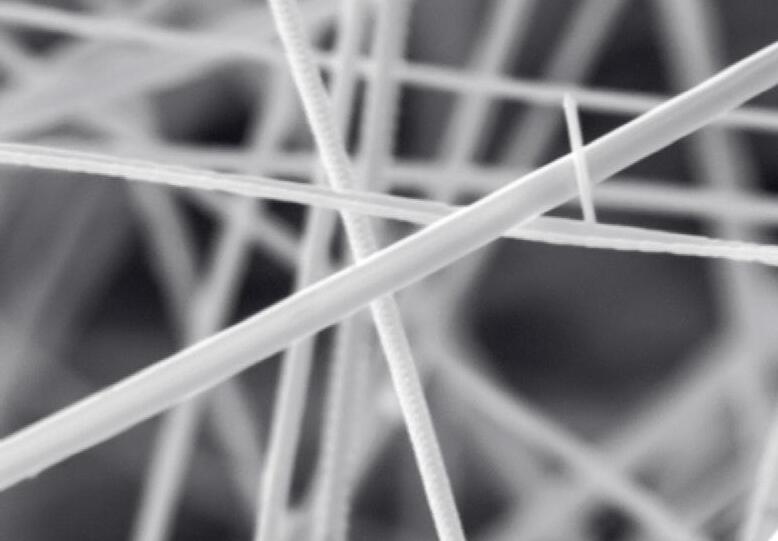
The new grant program, open to all Texas institutions, is meant to accelerate progress in fundamental chemical research. Grants are awarded to “highly meritorious proposals aimed at significant problems at the leading edge of chemistry.”
The Welch center at the University of Houston aims to improve understanding of the intricate crystallization processes, inventing fresh ways, both through experiments and computer simulations, to predict and manage how crystals form.
“Knowledge gaps in the nascent and rapidly developing field of nonclassical crystallization present a wide range of obstacles to design crystalline materials for applications that benefit humankind, spanning from medicine to energy and the environment,” said Rimer, the center’s director. “Success calls for a paradigm shift in the understanding of crystal nucleation mechanisms and structure selection that will be addressed in this center.”

THE WELCH CENTER AT THE UNIVERSITY OF HOUSTON AIMS TO IMPROVE UNDERSTANDING OF THE INTRICATE CRYSTALLIZATION PROCESSES, INVENTING FRESH WAYS, BOTH THROUGH EXPERIMENTS AND COMPUTER SIMULATIONS, TO PREDICT AND MANAGE HOW CRYSTALS FORM.

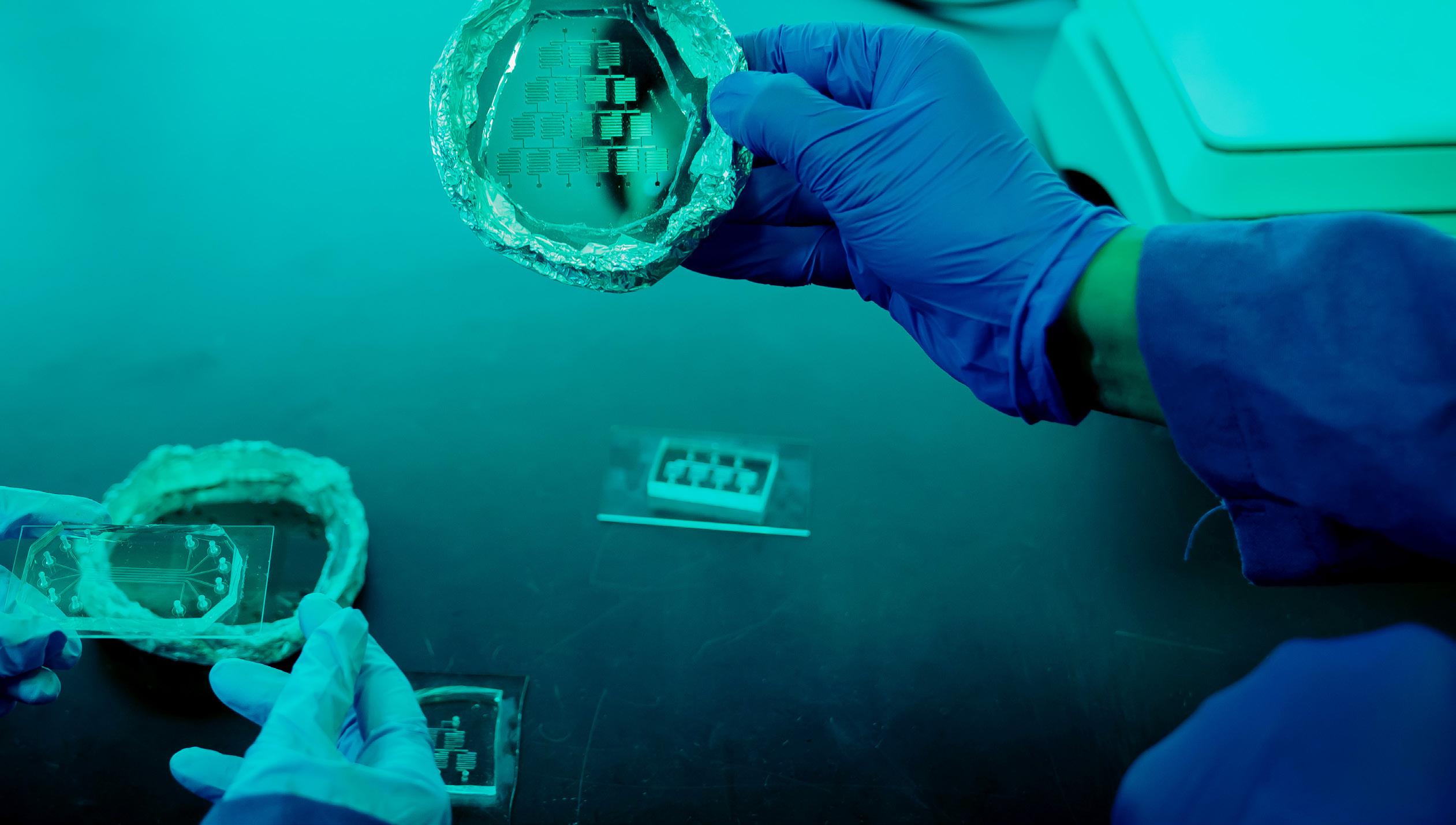
Nucleation is the process when atoms, ions or molecules come together to form an ordered material with the same structure as a crystal. For centuries it was believed that crystals nucleate through the assembly of molecules in solution. Within the last decade it has become more evident that the predominant pathway for nucleation is the initial formation of a precursor (liquid or solid) that densifies the molecules, which then nucleate.
“These nonclassical pathways present new challenges to understand the factors that drive precursor assembly, the origin of crystalline ordering within these phases and to develop novel methods to control nucleation,” said Rimer.
Controlling the early-stage processes of crystallization will come first and then the center will address several other grand challenges facing crystal materials synthesis including predicting the structure(s) of the emerging crystals, and selectively altering the transformations between crystals structures.
Researchers at the newly formed center were strategically selected with unique but highly complementary expertise in crystallization, materials synthesis, characterization and modeling. The team includes Peter Vekilov, Frank Worley Moores Professor, chemical and biomolecular engineering, Alamgir Karim, Dow Chair and Welch Foundation Professor, chemical and biomolecular engineering; T. Randall Lee, Cullen Distinguished University Chair, chemistry; Jeremy Palmer, Ernest J. and Barbara M. Henley Associate Professor, chemical and biomolecular engineering; Gül Zerze, chemical and biomolecular engineering; and Francisco Robles Hernandez, professor of engineering technology.
A common problem in crystallization is the formation of polymorphs, which are crystals with the same chemical formula, but a different arrangement of atoms, ions or molecules. Professor Vekilov will lead the team to solve two problems related to crystal polymorphism: predicting the possible crystal structures of compounds of interest and controlling the transformations between polymorphs.
“These studies are necessitated by a fundamental property of crystals – the fact that a compound can form multiple crystal structures. This issue becomes more complicated because many compounds tend to include solvent molecules in their crystal structure and create solvates,” said Vekilov.
Professor Lee's research team will create specially designed nanoparticles with specific surface properties and chemical characteristics. These nanoparticles will serve as templates for growing bioactive organic crystals on a large scale.
"Support from the Welch Foundation has led to important advances in the field of chemistry, not only within Texas, but also throughout the United States and the world as a whole,” said Lee. “These advances extend beyond scientific discoveries and into the realm of education, where support from the Welch Foundation has played a significant role in building the technological workforce needed to solve ongoing and emerging problems in energy and health care.”
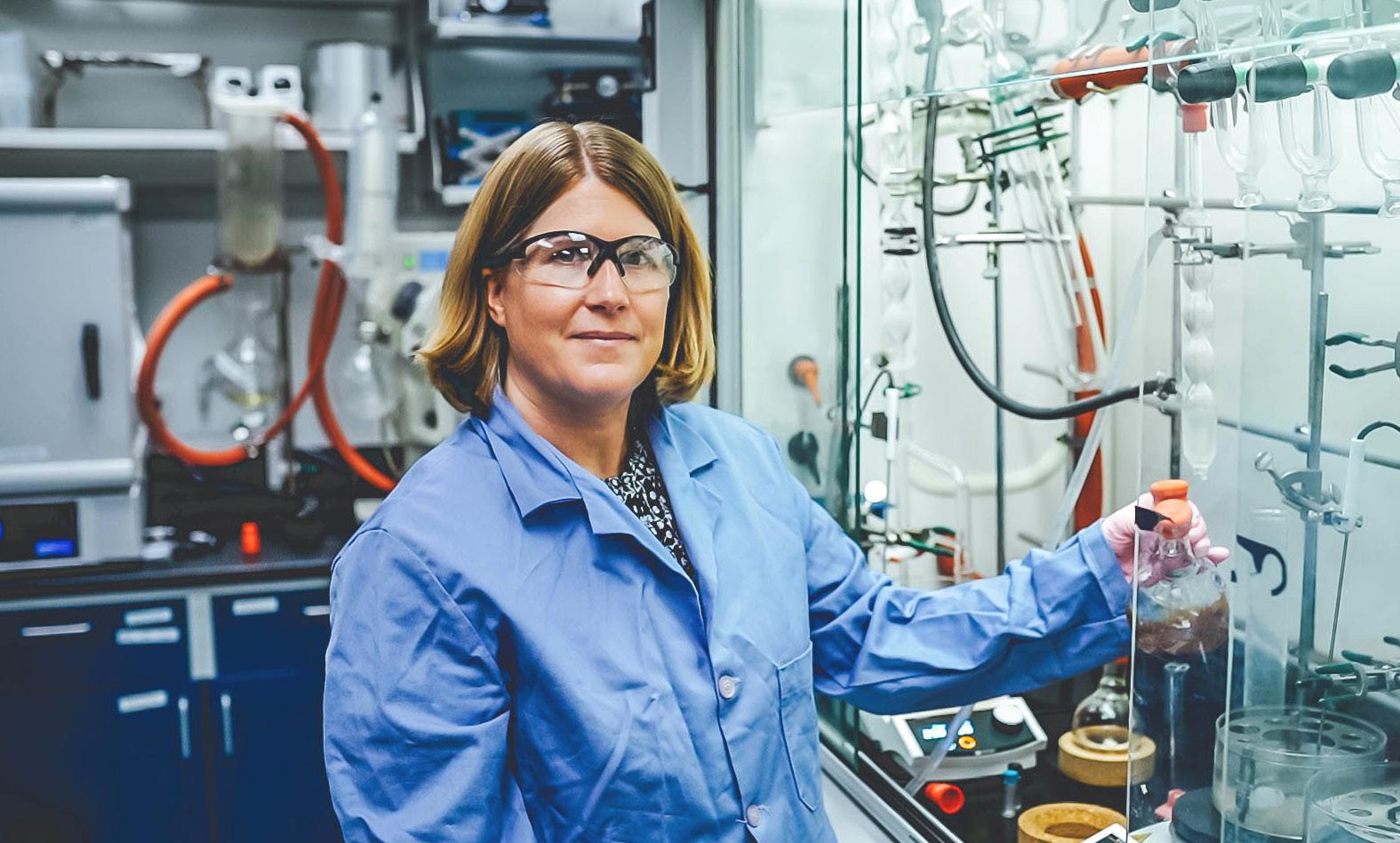
This is a big opportunity and, now that we have the resources, we are really excited to take these projects to the next level.
– MEGAN ROBERTSON
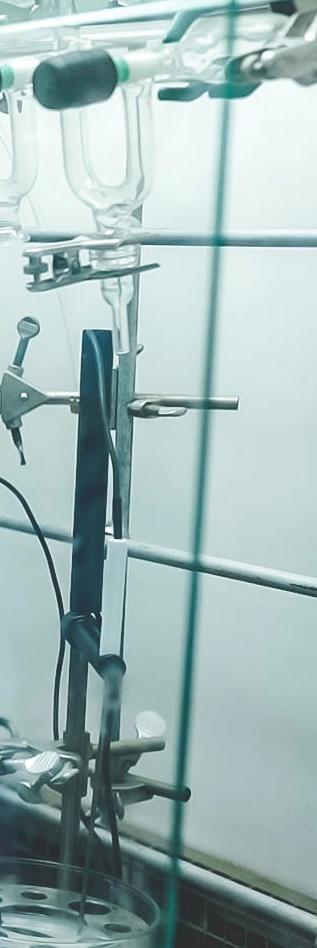
In today’s fast-paced world, convenience oftencomes packaged in plastic, from shopping bags to food containers, not to mention the seemingly endless supply of plastic water bottles. This useful, lightweight, low-cost material is an undeniable part of our daily lives, but it comes at a staggering cost to the environment.
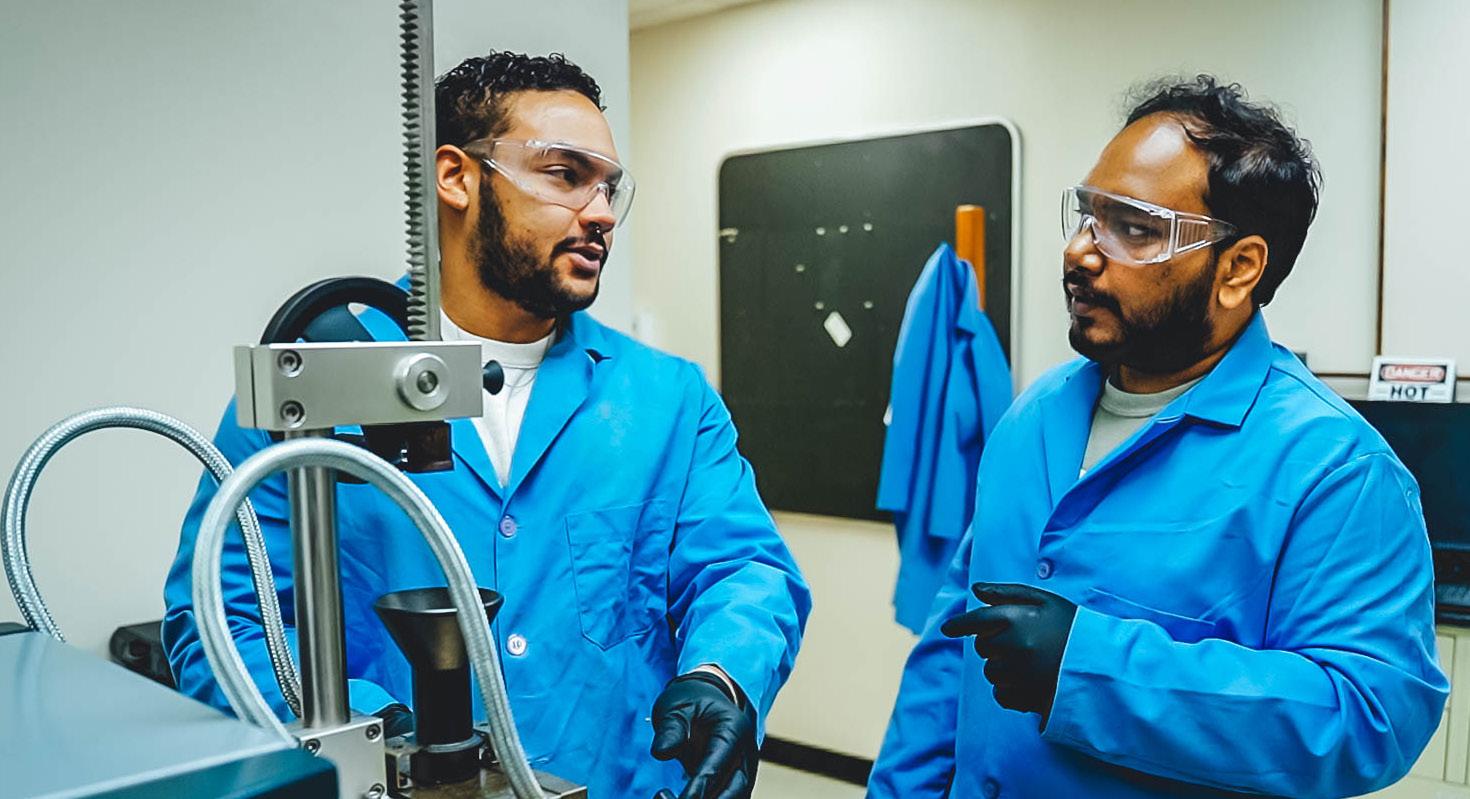
A new interdisciplinary research project underway at the University of Houston, funded by a $4 million grant from The Welch Foundation’s new Catalyst for Discovery Program, aims to develop innovative chemical processes to transform plastic waste into useful materials.
We are creating new ways to reuse and recycle that waste to make useful products and materials out of it.- MEGAN ROBERTSON
“More than 60% of plastics produced in the U.S. are polyolefins, such as polyethylene and polypropylene, which are extremely slow to biodegrade,” said Megan Robertson, project director and professor of chemical engineering at UH’s Cullen College of Engineering. “We are creating new ways to reuse and recycle that waste to make useful products and materials out of it.”
According to the World Economic Forum, the United States only recycled about 6% of the 40 million tons of plastic waste it generated in 2021. Around the world, about 400 million tons of plastic waste is produced each year. Much of it ends up in landfills, oceans and natural habitats, negatively impacting the environment, human health and wildlife.
“We’re tackling a complex problem that needs a diverse team with a wide range of expertise in polymer synthesis, polymer physics and materials science,” said Olafs Daugulis, the Robert A. Welch Chair of Chemistry at UH. “The chemists on the team will lead the development of unique polyolefins with new material properties and functions, while the chemical engineers will study their physical behavior and properties, such as strength and adhesion. This knowledge is crucial for creating new materials that can be recycled and reused more effectively.”
By bringing together this array of expertise, the team at the forefront of this effort is working to create lasting change. Joining Robertson and Daugulis on the research team are Ramanan Krishnamoorti and Alamgir Karim from the William A. Brookshire Department of Chemical and Biomolecular Engineering at the Cullen College of Engineering, and Maurice Brookhart and Brad Carrow from the Department of Chemistry at the College of Natural Sciences and Mathematics. This project will be conducted in collaboration with UH’s Energy Transition Institute, which is built on three core pillars – carbon management, hydrogen and circular plastics.
The team will tackle the challenges with polyolefins through a three-pronged approach: value-added recycling, upcycling plastics and enabling their circular reuse.
Recycling mixed plastics is a notoriously difficult and costly process. The researchers are developing a game-changing solution by creating modular "compatibilizers" - special polymers or molecules that can blend different types of plastic waste that otherwise do not want to mix. The compatibilizers can be designed to work with the diverse plastic waste streams that may enter a recycling facility and can change on a day-to-day basis. This innovation will streamline the recycling process, making it more efficient and economical.
2
The goal of traditional recycling is often to produce an item similar to the original, like turning a water bottle into another water bottle. However, diverting this plastic from landfills in the long run would involve recycling it not just once, but many times in succession. In this project, the researchers seek to upcycle polyolefin waste into durable thermoset materials. These polymers can be used in long-lasting applications, such as insulation, coatings, or automotive products, where they could be used for a decade or longer. Upcycling the waste in this manner thus could have a long-term impact on keeping the waste out of landfills and the environment. Ultimately, these thermosets could also be recycled and the team is investigating innovative ways to do this.
3
Polyolefins are notoriously stable polymers. While this is a favorable aspect for their use in products, they degrade in the environment at a slow rate. The team is bringing new functionality into the polymers through incorporating chemical groups that will accelerate their degradation. This will enable efficient deconstruction, separation, purification, and re-formation of the polymers from the degraded plastics. >>
“We're providing a multi-pronged approach to managing polyolefin waste, each enabled by catalytic strategies for bringing new chemical groups into the polymers,” said Robertson, who added that preliminary work has already been conducted on all three aspects of the project to demonstrate feasibility. “This is a big opportunity and, now that we have the resources, we are really excited to take these projects to the next level.”
Robertson, who is equally passionate about polymers and sustainability, was awarded two additional grants from the Welch Foundation this year. One focuses on sustainable elastomers made from bioresources, and a second project is aimed at chemically recycling polystyrene into value-added polymers and chemicals. Brookhart, Carrow, Daugulis, and Karim also have other ongoing projects supported by Welch Foundation.
The Houston-based Welch Foundation is one of the nation's largest sources of private funding for basic chemical research. Its new Catalyst for Discovery grant program supports fundamental chemical research “aimed at solving significant problems for the benefit of humankind.”
"Thanks to this game-changing support from the Welch Foundation, we will leverage all the resources of the University of Houston, a Carnegie-designated Tier One Research University, to address critical challenges facing our world,” said Ramanan Krishnamoorti, who also serves as UH’s vice president for energy and innovation.
“UH’s mission is to transform lives and communities through education, research, innovation, and service in a real-world setting. This is exactly what we are doing,” Krishnamoorti added. “We are honored by the Welch Foundation’s belief in us and the award of two Catalyst grants.”
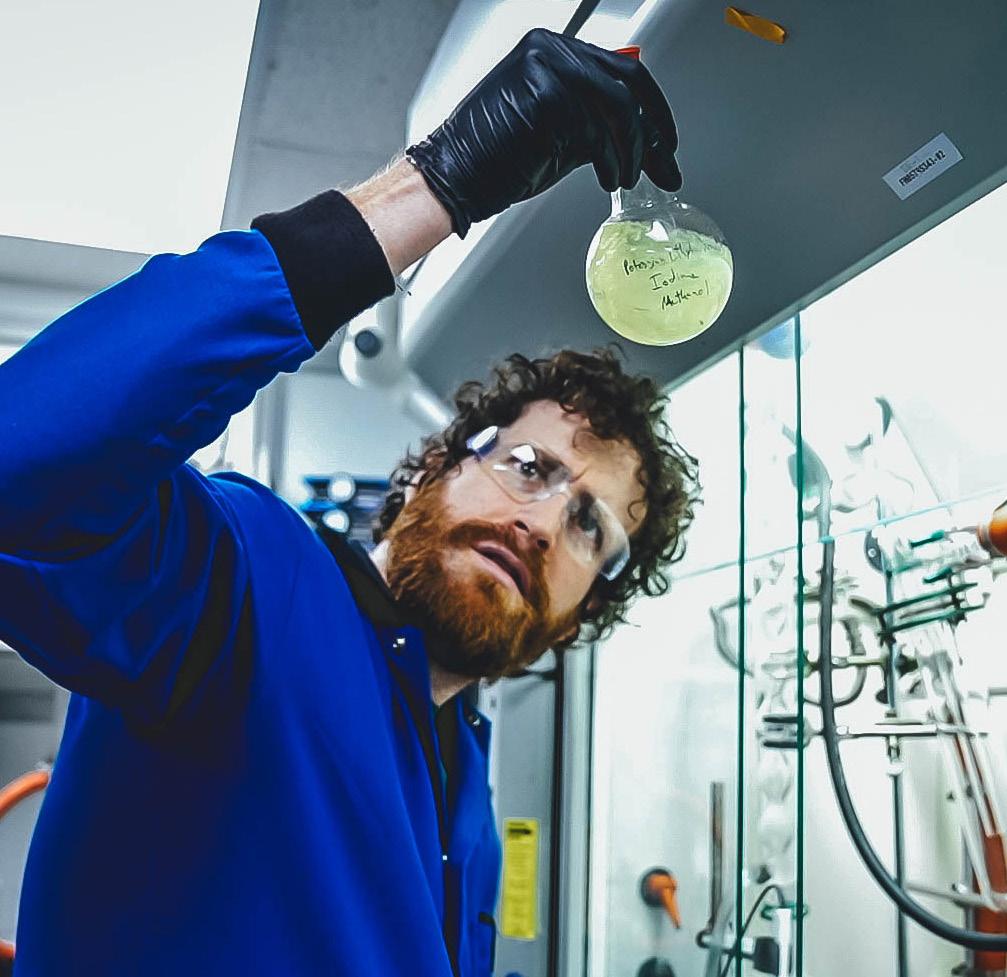
THE HOUSTON-BASED WELCH FOUNDATION IS ONE OF THE NATION'S LARGEST SOURCES OF PRIVATE FUNDING FOR BASIC CHEMICAL RESEARCH.
 Postdoctoral Research Assistant, Justin D. Smith
Postdoctoral Research Assistant, Justin D. Smith
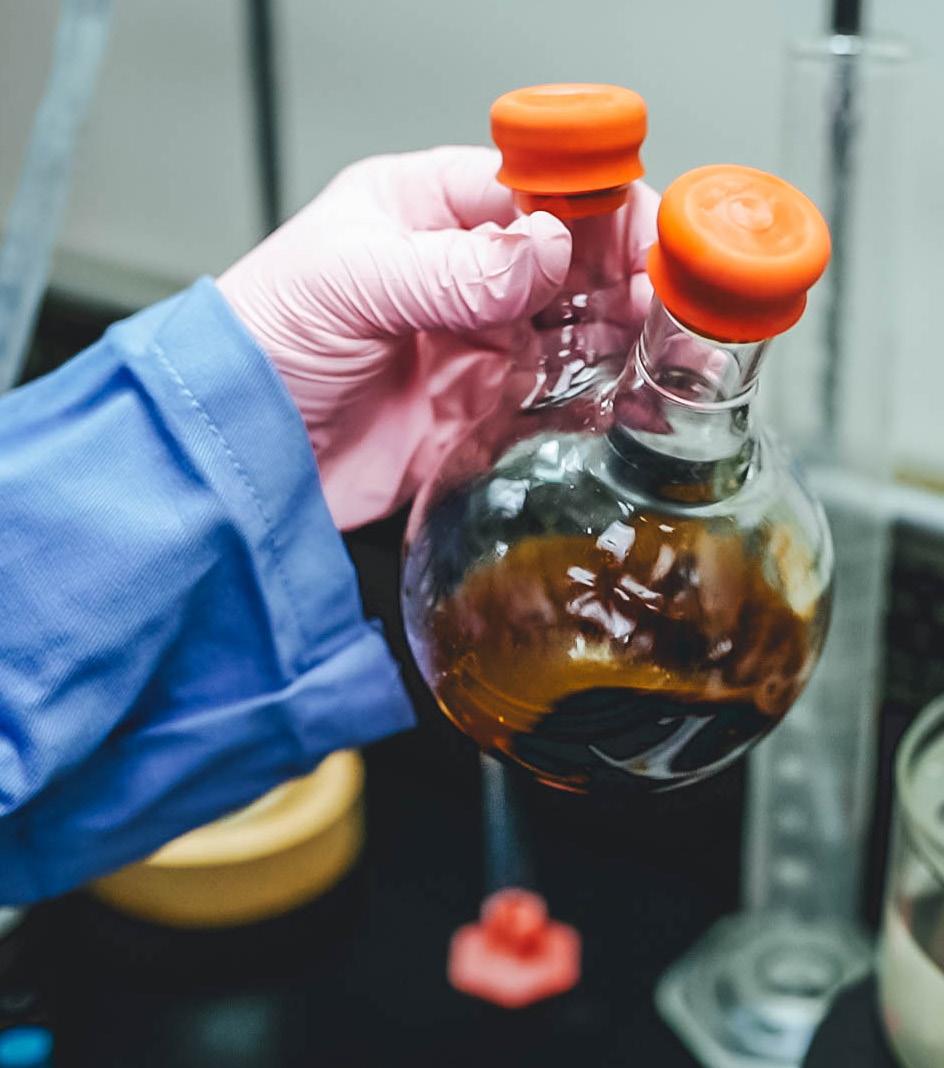 Megan Robertson's Plastics Laboratory.
Megan Robertson's Plastics Laboratory.
Two powerhouse engineers and inventors from the University of Houston Cullen College of Engineering have secured coveted positions as Fellows in the National Academy of Inventors (NAI).

The election as academy Fellows of Vincent Donnelly, Moores Professor of Chemical and Biomolecular Engineering, and Christine Ehlig-Economides, Hugh Roy and Lillie Cranz Cullen Distinguished University Chair of Petroleum Engineering, is the highest professional distinction awarded to academic inventors. The addition of the pair brings to 39 the number of professors from the University of Houston who are either Fellows or Senior Members of the NAI.
Considered one of the top researchers in the world in experimental plasma diagnostics and plasma-surface interactions, Donnelly was elevated to Fellow for his research which has contributed tremendously to understanding complex plasma systems used in the making of microchips.
He is considered a pioneer in plasma science with applications to microelectronics and nanotechnology and is continually expanding the frontiers of plasma science and engineering.
Donnelly has developed several new experimental techniques that are now considered the “standard” in both research labs and microchip fabrication lines.

A legend in her field, Ehlig-Economides was the first woman in the United States to earn a doctorate degree in petroleum engineering.
She was elevated to NAI fellow for her creative research leading to innovative solutions in the energy and industrial fields. She leverages her years of managing research in production and reservoir engineering in conventional and shale reservoirs for the energy transition.
Among her patents are innovative well testing methodologies designed to enable quantification of reservoir parameters layer-by-layer and well pattern design for enhancing hydrocarbon recovery that could enable doubling or tripling the very low recovery factor that currently occurs from wells in tight oil formations.

“The remarkable contributions of the two new NAI Fellows from the University of Houston have left a lasting imprint, earning them high esteem in their respective fields,” said Ramanan Krishnamoorti, vice president for research and technology at UH. “Their work stands as a testament to the extraordinary impact inventors can have, reflecting a standard of excellence that truly sets them apart.”
The 2023 class of Fellows is comprised of 162 distinguished academic inventors representing 35 U.S. states and 10 countries. The class includes two Nobel Laureates, three National Inventors Hall of Fame inductees, 22 members of the National Academies of Sciences, Engineering, and Medicine and individuals holding other honors and distinctions as well as senior leadership from universities and research institutions. Their work spans across disciplines and exemplifies their dedication and inspiration to translating research into commercial technologies that benefit society.
“This year’s class of NAI Fellows showcases the caliber of researchers that are found within the innovation ecosystem. Each of these individuals are making significant contributions to both science and society through their work,” said Dr. Paul R. Sanberg, president of the NAI. “This new class, in conjunction with our existing Fellows, are creating innovations that are driving crucial advancements across a variety of disciplines and are stimulating the global and national economy in immeasurable ways as they move these technologies from lab to marketplace.”
The 2023 class of Fellows will be honored and presented their medals by a senior official of the United States Patent and Trademark Office at the NAI 13th Annual Meeting on June 18, 2024 in Raleigh, North Carolina.

Mohamed Soliman, the William C. Miller Endowed Chairman of the Petroleum Engineering Department at the University of Houston's Cullen College of Engineering, has been recognized by another organization for a long career of distinction.
Soliman is one of the members of the inaugural class of Hart Energy’s Hall of Fame and Agents of Change in Energy (ACEs). The Hall of Fame was created as part of Hart's 50th anniversary celebration in 2023. A ceremony will be held on Dec. 5 in Houston.
This is the second such honor for Soliman this year. He was named a 2023 Legend of Hydraulic Fracturing at the Society of Petroleum Engineers' Hydraulic Fracturing Technology Conference and Exhibition. Only 10 other researchers have been recognized with that honor, which is one of the highest honors given by the SPE.
Soliman earned his doctorate from Stanford University in 1979. He has authored or co-authored more than 250 papers, and he holds 37 U.S. Patents.
Soliman joined the Cullen College of Engineering as the first Petroleum Engineering Department chairman in 2016, after holding a similar position at Texas Tech and a 32-year career at Halliburton Energy. His recent work at UH features his research team investigating test analysis of hydraulic fracturing and the area of plasma stimulation and fracturing as a method of waterless stimulation of reservoirs.
The honor from Hart specifically notes Soliman's work at Halliburton as a reason for his induction. At Halliburton, Soliman was involved with the first fractured horizontal well in the late 1980s, when he was the chief reservoir engineer for the company.
Since 1973, Hart Energy has been the global energy industry's comprehensive source for news, data, and analysis that inform business and technology decisions. For more information, visit its website.
His recent work at UH features his research team investigating test analysis of hydraulic fracturing and the area of plasma stimulation and fracturing as a method of waterless stimulation of reservoirs.

Gino J. Lim, professor and R. Larry and Gerlene (Gerri) R. Snider Endowed Chairman of the Industrial Engineering Department at the Cullen College of Engineering, has added another international award to his already impressive list of accomplishments.
Lim earned the 2023 Distinguished Educator Award in June at the 8th North American Industrial Engineering & Operations Management (IEOM) Conference. He also served as a keynote speaker for the event, which was held at the UH Hilton.
The award recognizes industrial engineering and operations management educators who have significantly contributed to the field through the publication of books and articles in peer-reviewed journals; drawn externally-funded research; employed creative teaching methods; and developed teaching aides, including software and other innovative methods.
The nominee is expected to have administrative experience in an academic institution of higher education. Nominees must be at least 40 years old, and a member of the IEOM Society for a minimum of five consecutive years with a minimum of 15 years of combined academic and administrative experience.
He has successfully supervised 32 Ph.D. dissertations, and numerous Master’s theses. Lim has been a principal or co-principal investigator to multiple projects with sponsored funding of more than $10 million from various sources of funding agencies, including the National Science Foundation (NSF) and Department of Homeland Security (DHS).
BY STEPHEN GREENWELLLIM IS WORKING AS A CO-PI ON A $3 MILLION NSF PROJECT, "PLATFORMS FOR EXCHANGE AND ALLOCATION OF RESOURCES (PEAR)."
Lim joined the University of Houston in 2004 and became the chairman of the Industrial Engineering Department in 2011. He completed his doctorate at the University of Wisconsin-Madison. He is a Fellow of the Institute of Industrial and Systems Engineers (IISE). His writing earned Best Paper Award in the Energy Systems Division at the IISE's Industrial and Systems Engineering Research Conference (ISERC) in 2017; and the Pierskalla Best Paper Award and multiple service awards by INFORMS since 2002 and multiple teaching awards at UH.
Lim is a board member of the IISE Board of Trustees and the senior vice president of IISE International Operations. His most recent grant is as a co-principal investigator for a $3 million National Science Foundation project, “Platforms for Exchange and Allocation of Resources (PEAR).” Northeastern University is the lead institution for the grant.
A professor in the Cullen College of Engineering's Petroleum Engineering Department and the William A. Brookshire Department of Chemical & Biomolecular Engineering has been recognized with the Society of Petroleum Engineering (SPE) Honorary Member Award.
Birol Dindoruk is the American Association of Drilling Engineers Endowed Professor of Petroleum Engineering & Chemical and Biomolecular Engineering, and the recipient of the award from the SPE.
According to the organization, “Honorary Membership is the highest honor SPE confers upon an individual. It is limited to 0.1 percent of SPE’s total membership and is conferred on individuals for outstanding service to SPE or in recognition of distinguished scientific or engineering achievement in fields encompassed in SPE’s technical scope.”
In a speech accepting his award, Dindoruk noted that he could not have become the scientist he is today without the support he received from his SPE membership, which began almost 40 years ago in 1985.
“I was a freshman at the age of 16,” he said. “If you had asked my 16-year-old self whether I could ever been on this stage accepting this award, I would have answered that you must have lost your mind.”
He added, “My passion for research and curiosity for learning were fueled by scientific publications and interactions in workshops and meetings enabled by SPE. In my current role as a Professor of Petroleum Engineering and as well as Chemical Engineering at the University of Houston, I am sharing my experiences and knowledge with the next generation of SPE’s student members and young professionals by volunteering, teaching and mentoring, and also advocating service work for SPE and the industry as a whole.”
 Dindoruk
Dindoruk
Dindoruk noted that while he had received lots of support from colleagues and friends at UH, Stanford and Shell over the years, there was one person that was instrumental above all others.
“I would like to thank my wife and better half Deniz, or perhaps I should say Dr. Sumnu-Dindoruk. She had to put up with my busy professional life, travels and voluntary work, and at the same raising three kids and developing a successful career for herself in our industry. I will repeat what I wrote in my thesis in 1992: 'Thank you Deniz, you never let me forget that there is more to life than a bunch of equations.'”
Dindoruk has been recognized several times in the past by the SPE and other organizations. He has earned the SPE's Lester C. Uren Award, the Cedric K. Ferguson Medal, and Distinguished Membership before this latest honor.
In 2017, he was elected to the National Academy of Engineering for his theoretical and practical contributions to enhanced oil recovery and CO2 sequestration. He was the SPE Data Science and Engineering Analytics Technical Director, SPE Reservoir Dynamics and Description Technical Discipline Advisory Committee member, and SPE Distinguished Lecturer.
He has also been active in various editorial positions under SPE and Elsevier and has been the only person who lead, as an editor in chief, the top three journals in the area of petroleum and gas science & engineering. He is currently the editor in chief for SPE’s peer-reviewed journals and previous editor in chief of Elsevier’s Journal of Natural Gas and Engineering.


Ying Lin, an associate professor in the Cullen College of Engineering's Industrial Engineering Department, has earned an international award for her work in the field of data analytics and as director of the Smart Health & Intelligent Engineering Systems (SHINES) Lab.
At the 8th North American International Conference on Industrial Engineering and Operations Management (IEOM), Lin received a Data Analytics Award from the organization. She called the distinction “a great honor” for her and her research group.
“This recognition means a lot to me and my group,” she said. “I want to express my heartfelt gratitude to my students for their efforts and gratitude to my department chair for his support." I am passionate about data analytics and its potential to drive meaningful insights and positive change, and I look forward to continuing my work in this field.”
Lin has been a member of the Cullen faculty since Fall 2017. She earned her doctorate from the University of Washington, and her master's degree from the University of South Florida. In 2020, she received a $435,000 grant to continue research on identifying underlying genetic contributors to some forms of psychiatric illness. That award is part of a larger $2.4 million project by the Lieber Institute for Brain Development in Baltimore.
Lin said her current research is focusing on analyzing data integrated from multiple sources.
“This type of data is usually associated with heterogeneous structures and the risk of privacy leakage,” she said. "To solve these issues, we have developed novel machine learning frameworks for multimodal data integration and privacy-preserving data sharing. Our recent works have been published in IISE Healthcare Systems Engineering and BMC Bioinformatics.”


Juan Carlos Fernandez-Diaz, a research assistant professor in the Civil and Environmental Engineering Department and a co-investigator for the National Center for Airborne Laser Mapping (NCALM), is part of the 2023-25 cohort for the American Geophysical Union (AGU) LANDInG Academy Fellows.
The LANDInG Academy is a two year program aimed at providing mid faculty with a network, tools and resources to achieve more balanced representation in geosciences.
With more than 62,000 members from 137 countries as of 2018, the AGU is the
premier international geophysics society. Fernandez-Diaz was chosen after a competitive application process. He will be part of the second cohort ever, after the union's first effort from 2021 to 2023. As part of the program, he will present at the AGU Fall Meeting 2025, which is currently scheduled for Washington D.C. from Dec. 15 to Dec. 19.
Fernandez-Diaz joined UH in 2010 as a senior researcher for the NCALM, after earning his doctorate in Geosensing Systems Engineering from the University of Florida. He became a research assistant professor in 2019.
He has been part of research teams at Cullen that have helped to uncover ancient cultures in the Honduran jungles, and an airborne mapping initiative that identified nearly 500 sites and patterns from early Mesoamerica. Most recently, the team helped mapped a previously unknown Maya city in the jungles of southern Campeche in Mexico.
The 2023-25 cohort will have 17 members, with the first summit for the group coming in Washington, D.C. on Sept. 14 and 15 of this year.

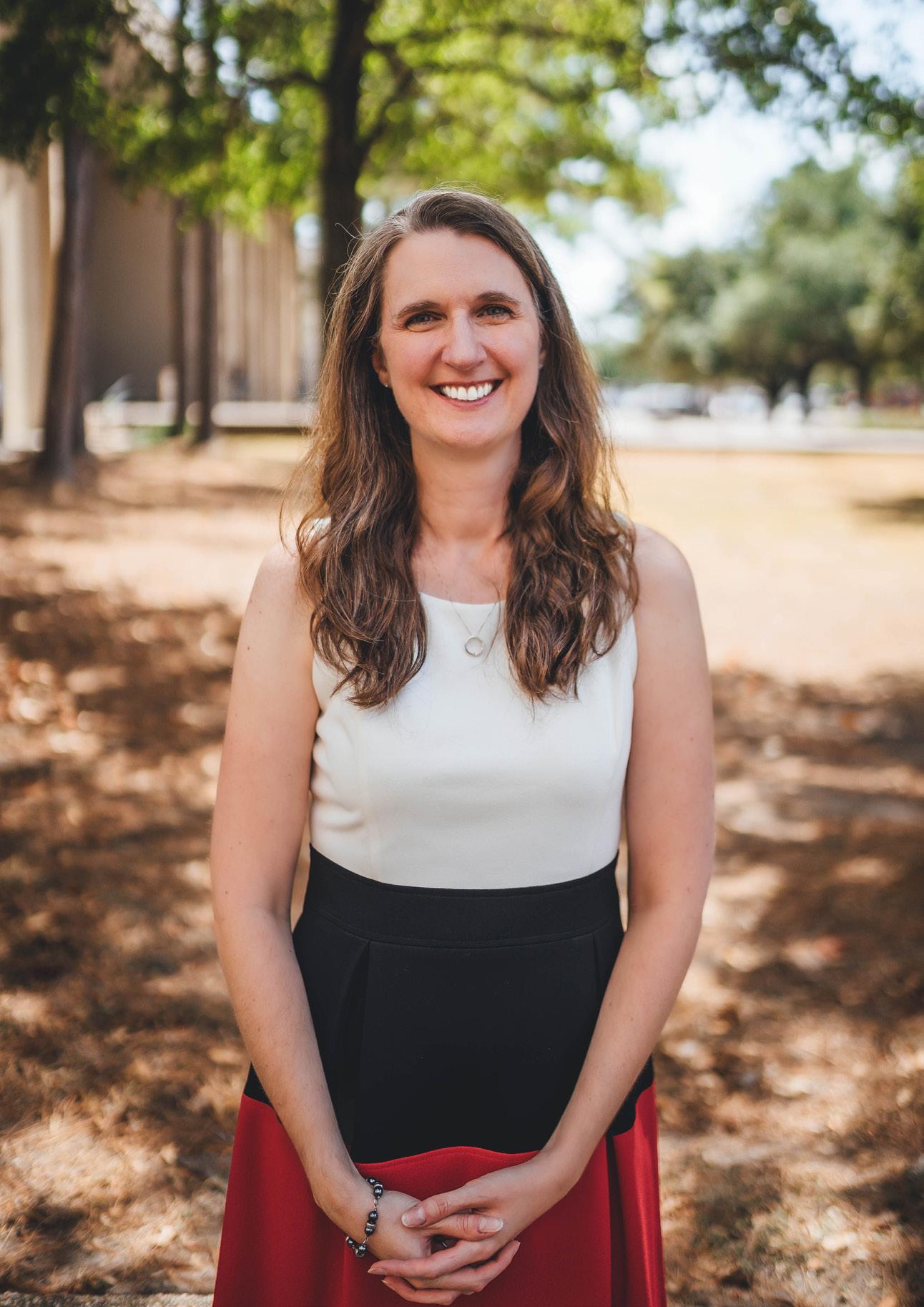
Jamison V. Kovach, the Associate Dean for Students Success and Undergraduate Support Services, is part of the Technology Division of the Cullen College of Engineering. She is the 2023 recipient of the Industrial Engineering and Operations Management (IEOM) Society International's Lean Six Sigma Award. With more than 20,000 members in 151 countries, IEOM strives to be the premier global organization dedicated to the advancement of industrial engineering and the operations management discipline.
The award recognizes outstanding best practices using Lean and Six Sigma. Lean Six Sigma is a business philosophy focusing on breakthrough improvement. It incorporates Lean philosophies with the Six Sigma methodology. A unique aspect of this program is its support of Industry-Academia partnerships, which helps organizations in our community solve pressing problems while providing meaningful learning opportunities for students.
“I’m honored to be recognized in this capacity by peers in my field,” Kovach said of the award.
Kovach joined the faculty of the Technology Division in 2006 as an assistant professor and the director of the Lean Six Sigma Professional Training Program, a position she remains in. She was promoted to associate professor in 2012, and to PMI Houston Endowed Professor in 2019. She earned her M.S. and Ph.D. in Industrial Engineering from Clemson University.
“I owe a lot to the professors I learned from during my undergraduate studies in the College of Textiles at North Carolina State University, where I earned my B.S. degree in Textile Engineering,” she said. “My professors were constantly conducting research projects with industry partners, and this model for applied research is what I continue to use in my work with both practitioners and students today.”
Kovach received the 2010 American Society for Quality Feigenbaum Medal and the 2019 ASQ Six Sigma Forum Award for the Advancement of Six Sigma. She is an Academician in the International Academy for Quality, an ASQ Fellow, and the Editor for Lean & Six Sigma Review, a quarterly ASQ publication.
BY STEPHEN GREENWELLShe was also a Faculty Fulbright Scholar for the 2020-21 academic year. As part of that program, she spent three months in Portugal from April to July 2022 conducting a research project, “Leveling Up: Enhancing Portugal’s Achievement of Industrial Performance Improvements.”
A professor at the Cullen College of Engineering has been honored by being elected as a Fellow of the Institute of Electrical and Electronics Engineers, one of the highest honors of distinction provided by the organization.
Ji Chen, Professor in the Electrical & Computer Engineering Department and the Houston site director of the NSF I/ UCRC Center for EMC Research, was elevated to Fellow as of Jan. 1, 2024. He was notified of the honor in November.
Chen was recognized as being one of the top researchers in the area of EM modeling and measurements for MRI device safety. Less than 0.1 percent of IEEE voting members are selected annually for the Fellow distinction. He is the only member of the faculty to earn this distinction this year.
Chen has been a long-time member of the IEEE, and he has served the organization with distinction. He earned Senior Member status in 2008, which was followed
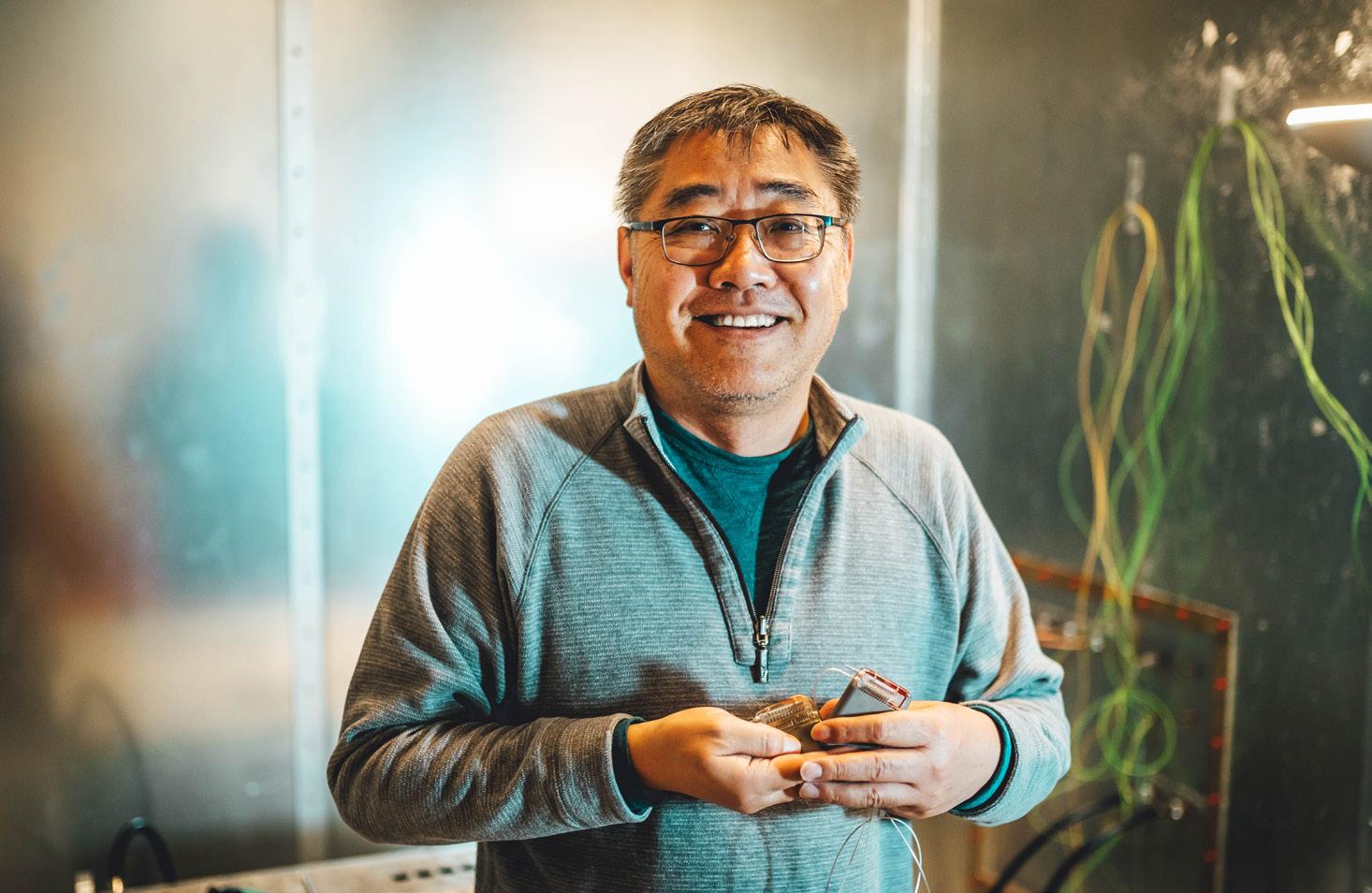
by the APMC 2008 Best Paper Award, EMC Society Distinguished Lecturer for 2009-10, and the EMC Society Technical Achievement Award in 2011. Since 2017, he has also served as an associate editor for IEEE Transactions on Electromagnetic Compatibility.

Chen joined the Cullen faculty in 2001, after working at Motorola as a staff engineer. His research interests include computational electromagnetics; coupled EM and neuro-modulation simulation; the safety of passive and active medical implantable devices under MR systems; multi-channel TMS devices; and the interactions of electromagnetic waves with the human body.
Chen earned his doctorate in Electrical Engineering from the University of Illinois, Urbana-Champaign. He completed his graduate work at McMaster University in Ontario, and his undergraduate degree at the Huazhong University of Science and Technology in China.
Chen is the top researcher in the area of EM modeling and measurements for MRI device safety.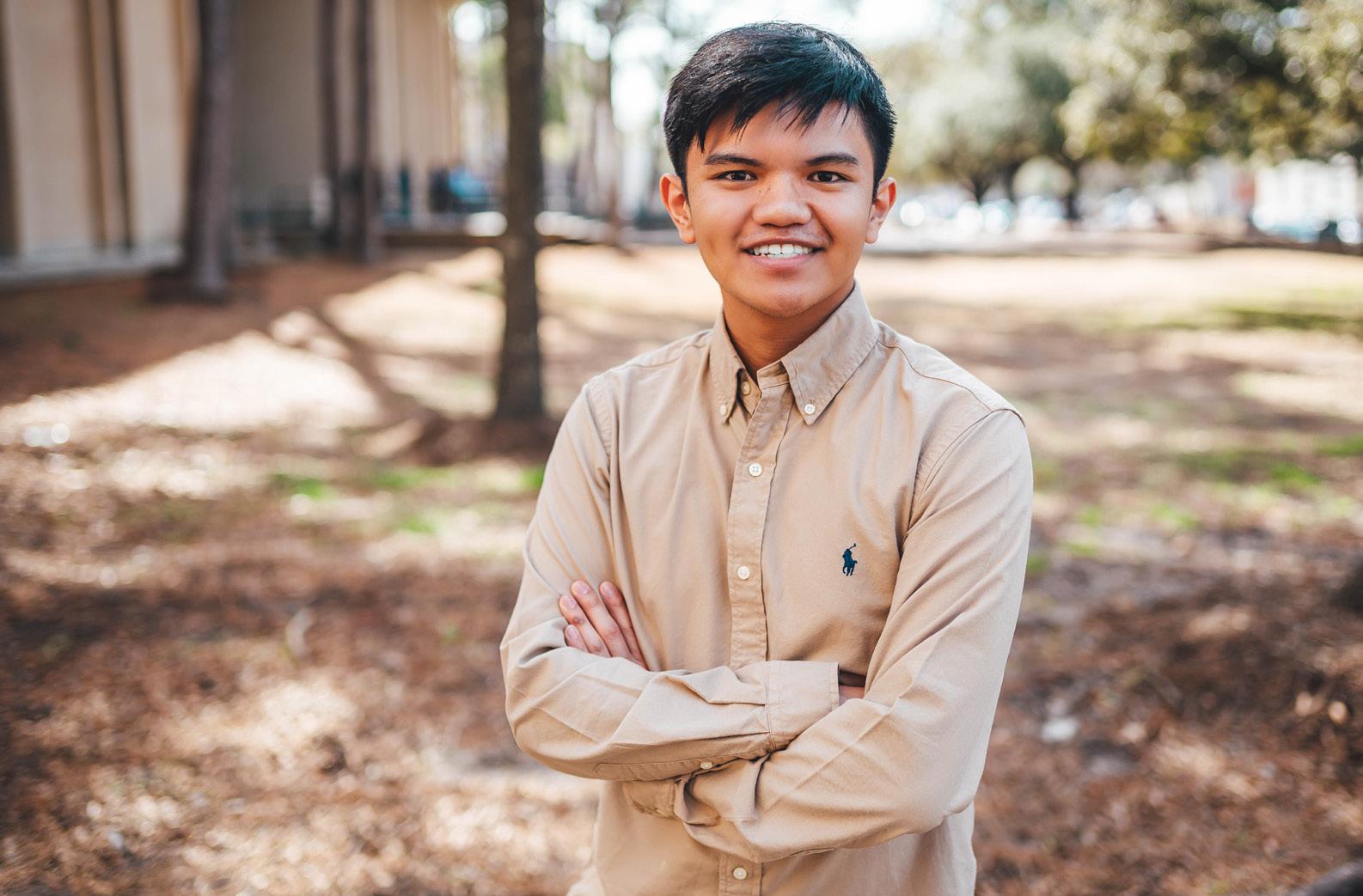
It was the combination of motivated high school teachers and the affordability of the University of Houston's Cullen College of Engineering that first got Leonard Aruj interested in engineering, and the junior Mechanical Engineering student is now flourishing, earning the the Outstanding Junior award for the 2023-24 academic year.
Aruj graduated from Alvin ISD's Shadow Creek High School in Pearland. While he was a student there, he identified two teachers that inspired him and encouraged him in his studies.
“I loved physics in high school, and my first introduction to that was AP Physics I in my junior year with Chad Bishop,” Aruj said. “It was my first class of the day and my homeroom period, so it was also the longest class of my day, which I liked. He made
it really fun. He didn't just give us notes. There were live demonstrations and we did labs as well.”
Aruj also enjoyed his AP Physics C course with Fernando Hinojosa, who is now the director of PreCollege Programs and Parent Outreach for the Society of Hispanic Professional Engineers.
“His class was basically like AP Physics I but calculus based,” Aruj said. “This was during the pandemic, so it it was online. I never was in his class face-to-face, but even then, I was very engaged in his class and like Mr. Bishop, he just made physics fun. Because of those two teachers I have always associated physics with fun.”
Given his proximity to UH, Aruj said it had always been on his radar. He grew up in the
area with his father Leon, his mother Emelie, and his siblings Nicole and David.
A combination of the college being close to home, offering a good package of aid and scholarships, and the college climbing in the national rankings made him enroll.
“The biggest point for me was that the University of Houston was really close to home,” he said. “I actually commute here because it's only half an hour away. It's also very affordable and I got some scholarships coming in. I applied my senior year and I graduated 2021, and around that time, I saw that U of H was like jumping in rankings. I saw that as like the start of an upward trend, so it was just a no-brainer to me.”
Aruj started as a chemical engineering major, but changed to mechanical engineering after a semester.
“I switched into mechanical engineering, because I realized that after one semester that the problems I liked solving the most were like the mechanical engineering problems,” he said. “I've always liked solving problems. I was good at math in high school and I loved physics, so I was naturally just drawn to engineering.”
Aruj doesn't have the typical engineering origin story of tinkering with and tearing devices apart to figure out how they work – he was in the opposite camp. He enjoyed playing with Legos, and putting things together. In the future, he'd like to be involved with the aerospace engineering industry, before potentially going back for another degree.
“I find space as a whole just fascinating,” he said. “I think engineering is a good way to get into that because it's the final frontier. Space travel has so many interesting problems and puzzles I want to solve.”
At UH, Aruj identified two mechanical engineering professors –Karolos Grigoriadis and Matthew Franchek – as having a positive academic influence on him.
“Dr. Franchek taught dynamics, and the way he taught it reminded me of how high school physics was like. I was pretty engaged with every lecture he gave, and he's a very good lecturer overall.”
Aruj also took dynamics courses with Grigoriadis.
“He also just taught it very well,” Aruj said. “I thought it was going to be like the most complex and difficult course I've taken so far, but he made it seem so simple.”
Aruj expects to graduate in May 2025, and this summer, he will be looking for an internship in the aerospace industry. While he completed and enjoyed a structural engineering internship between his sophomore and junior years, he wants that hands-on experience with aerospace now.
“I want to see how aerospace will be, so that's the main industry I'm gunning for and I think it'll be my first job out of college,” he said.

Overall Outstanding
Senior – Hedda Grelz
Junior – Leonard Aruj
Biomedical Engineering
Senior – Thomas Henry Padgett
Junior – Swetha Saravanan
Chemical Engineering
Senior – Nhi Hoang
Junior – John Martinez
Civil Engineering
Senior - Zachariah Kader
Junior – Chetan WGadapa
Computer Engineering
Senior – Frank Zequeira
Junior - William Lau
Systems Engineering
Junior – Jordyn Sibert
Electrical Engineering
Senior – Frank Salgado
Junior - Karina Montero
Industrial Engineering
Senior - Sharon Moonsammy
Junior – Mona Almufti
Mechanical Engineering
Senior – Hedda Grelz
Junior – Leonard Aruj
Petroleum Engineering
Senior – Claudia Garcia
Junior – Alexandra Montana
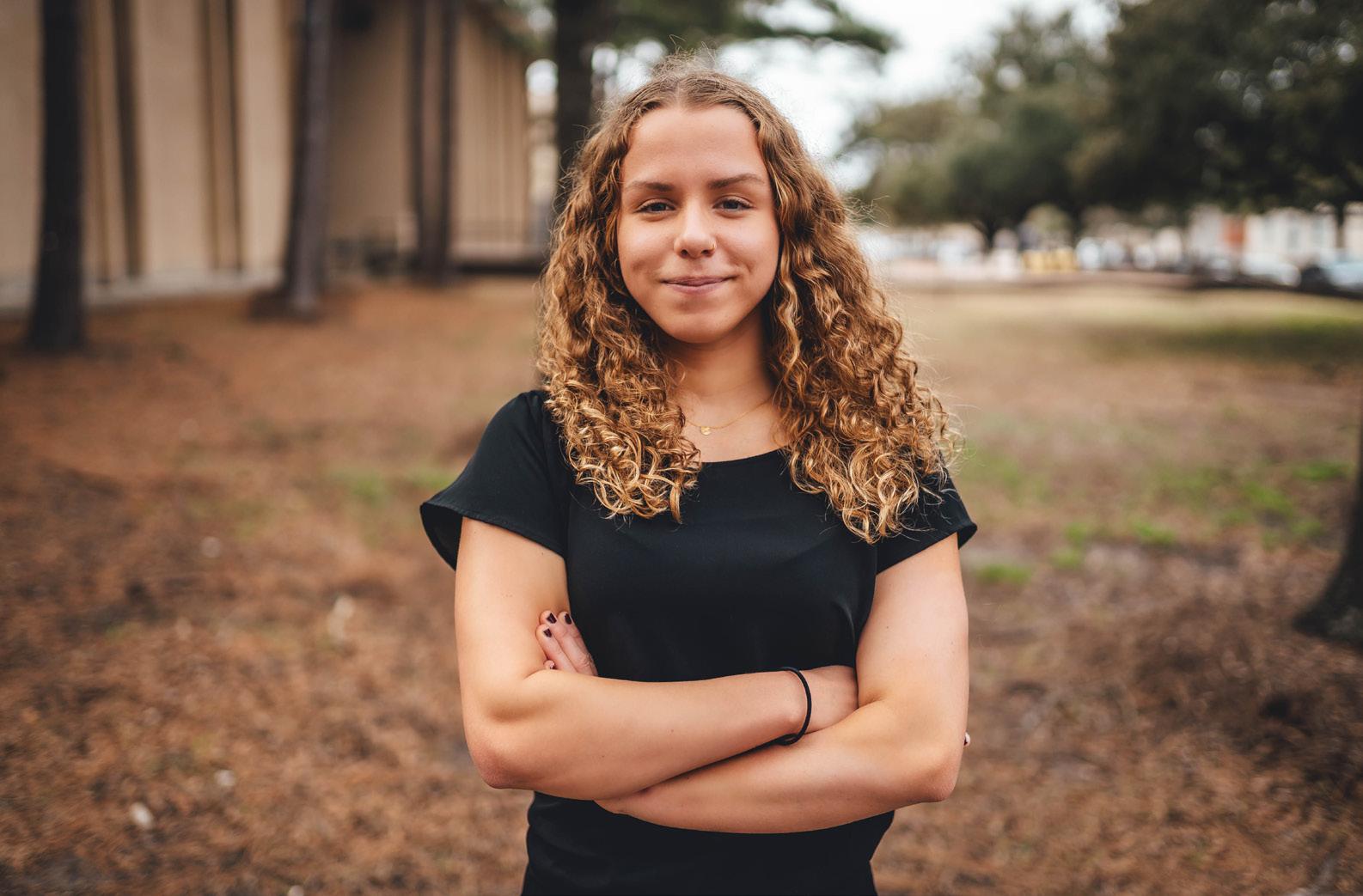
When Hedda Grelz was first touring colleges in the United States to continue her high level diving career, the native of Sweden said athletics wasn't the only thing she was concerned about. She also wanted a learning environment that would allow her to pursue her interest in engineering and physics.
Grelz found that and more as she's thrived in her four years at the University of Houston, both as a member of the swimming and diving team and as this year's recipient of the Outstanding Senior award.
Grelz said that she wasn't aware of UH until she was contacted by Bob Gunter, the diving coach for the Cougars.
“I did some research, and I saw that the engineering program was great, and the women's diving program was great too,” she said. “I came on a trip and it just felt like home right away. I loved the team, I loved the coaches, and I got to interact with some of the faculty from the engineering school and the Honors College, and I had very good conversations with everyone. It felt like it was a school where I could get the perfect mix of high level academics and also be on a really good team.”
There was an adjustment period for Grelz, as she got used to her new school and an entirely new country. She grew up in Lund, which she described as a city of about 100,000, mostly known for the university of the same name.
“There was a little bit of a cultural shock in many ways,” she said. “The city is huge and there's so many things to do. Sweden has great opportunities, but being in Houston, there's so much of everything. Not just in engineering, but in terms of food, culture, everything. It's definitely been a big difference but I like both city types.”
Grelz's parents, Marit and Henrik, are both doctors, so she grew up thinking she might pursue that as well. However, it was in high school that her mindset shifted, thanks to one of her professors, Per Brantmark.
“In high school, I found a passion for math and physics. I had a great physics professor that made me really interested in physics in general and mechanics more specifically,” she said, adding that she started out in civil and environmental engineering, before switching to mechanical after taking statics and dynamics courses at UH.
“I really, really liked those. I also realized how much more broad mechanical engineering was. I've really enjoyed most of the classes I've taken and so it ended up being a good choice.”
When it came to her engineering academic influences, Grelz said she's received great support from her peers and her professors.
“Dr. Fritz Claydon has been a great mentor for me since I've been here,” she said. “He recruited me to be the president of Tau Beta Pi [the engineering honor society] and has been a great resource as I have explored different career options.”
In her department, Tian “Tim” Chen – Kamel Salama Endowed Assistant Professor of Mechanical Engineering – allowed Grelz to get some of her first experience as an author and with writing an academic article.
“I wrote an article with him this summer and he's also been mentoring me and talking about careers and the future,” she said. “He's been a very, very good influence.”
Beyond engineering, Grelz has studied with Kevin Bassler, Moores Professor of Physics and Mathematics and Department Chair of Physics. His colleague, Royce Zia, also helped with her first research opportunity.
“I worked in statistical mechanics, so it was very much model-based, a lot of coding and nothing experimental, more physics than engineering, but it was still a very good first introduction to research,” she said. “I worked with them for about a year and did a poster presentation.”
Grelz said that Gunter and her teammates have been instrumental in her success, both in the pool and outside of it. She specifically brought up Elizabeth Richardson, a friend and a 2023 graduate who was also an Outstanding Senior.

The swimming and diving team has been incredibly successful during Grelz's time at UH, as she was part of three of the seven straight American Athletic Conference winning teams. The Cougars have been competitive this year as well, their first in the Big 12.
When it comes to her future, Grelz is applying for a master's program at UH. She also hopes to continue on the diving team, thanks to an extra year of eligibility granted to all athletes effected by the pandemic. Beyond that, she's keeping her options open for now, when it comes to her possible career and location. “I want to take this next year to really deep dive into research and having my own project, and then after that decide if I want to go for a doctorate degree or not,” she said. “If I don't do that, then I've been thinking about working in a startup company. I think that kind of environment I would really enjoy working in. There's a lot of things that I find interesting, like renewable energy, robotics and biomedical. I also am not sure if I want to be in the U.S. or back home.”
As she finishes her senior year, Grelz said she is more focused on building strong connections with her fellow graduates.
“I just want to say 'thank you' to all the professors, my team and my coaches that supported me along the way. The four years here have been some of the best years of my life, and to get this award was like the cherry on top. There are people that haven't been mentioned by name, because there's just so many professors and people that I've met that have influenced my life and my academic career in such meaningful ways. I feel so honored to have received this award and I just get very nostalgic thinking about all my time at UH.”

Reflecting on the beginning of my journey at UH in 2020, I can honestly admit that the period between the end of my senior year in high school and the start of my freshman year in college is mostly hazy.
With the start of the Pandemic and lockdown, time, for many and most of us, went by fast and slow at the same time. I had just graduated high school and was patiently awaiting the start of my freshman year. Having nothing really to do, I picked up reading, baking, and making Tiktok videos, just as many others in my position had been.
As I look back to those days, I am reminded of the saying, “The days are long but the years are short,” which was shared with me by a classmate who I met during that time. Somewhat bored by the repetitive days, I was excited for August and to start my time at UH.
I knew that our incoming class' experience would not be standard, given the conditions at the time. I recall signing up for an online orientation, virtually meeting my professors and classmates, and initially feeling disconnected. It was difficult to make a friend when all you see is a name on a computer screen.
Noticing our discomfort, I remember my professors at the time reminiscing about what class was like back in person. I listened to them intently, hoping that I could one day experience that too. Apart from the initial feelings of disconnect, learning engineering topics as a fresh-
man proved to be quite challenging. It was difficult for professors and students alike to navigate an online environment of learning.
With time, I found that as we collectively faced these struggles, students, professors, and staff alike grew closer together. Having firsthand experience with complete online learning, I saw many classmates being friendly and engaging with one another.
When we transitioned to full in-person classes, we did not take it for granted and worked hard, eager to give back in
Although our experience was far from standard, I also think that the class of 2024 is far from standard. We are an exceptional class who faced unprecedented challenges. Not only did we face those challenges, but we learned from them and used them to fuel our drive for the future.
THE DAYS ARE LONG BUT THE YEARS ARE SHORT- NUSAYBA EL-ALI
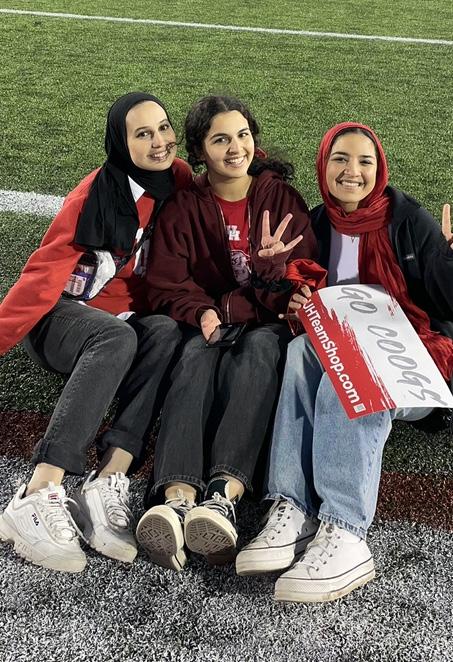
our own ways. Now, I look at my classmates and am so inspired from what they all have accomplished and contributed to the school and their peers.
Nusayba El-Ali is a student columnist for Parameters. She is currently studying biomedical engineering at the Cullen College of Engineering, with an expected graduation date of Spring 2024. She is also a teaching assistant and a member of Tau Beta Pi, as well as a co-host of the STEMinist podcast.

Uncertainty is difficult to handle. Once again it is graduation season, and for the students that have yet to reach that milestone, it may seem like it is still far out of reach. Some need an extra push to get them through that last semester, others may be thinking of whether their major is something they want to pursue. Many are struggling financially, and others academically. Many students experience burnout and struggle with anxiety…
At least I know I do, and I know I am not alone. There have been countless times when I have stayed up late studying, completing reports, and juggling a seemingly impossible work and study situation. Whatever the reason you may be stressing about, remember that everyone’s path is different, such as mine.
I studied industrial engineering in Mexico and graduated weeks before the COVID-19 lockdown went into effect. I never thought the pandemic would set off a string of events that would lead me to graduate with my second bachelor's degree in strategic communication and a minor in supply chain and logistics. My path was permanently altered by a situation out of my control. I panicked and then plotted a new course for myself.
Although my time at UH was short, I can wholeheartedly say that it has been filled with opportunities and support from amazing people every step of the way. These past two years have changed my life and given me goals to work towards.
The University of Houston has opened doors for me that I could not have imagined, such as interning at Aramco Americas, a place I appreciate because of how I was embraced and encouraged to maximize my potential.
I studied abroad! I am so proud to say that I studied in the Netherlands because there were multiple times when I questioned whether it was going to happen. I am glad I did not give up, as it was such a rewarding experience.
I participated in the Breakbulk Americas Student Research Poster Competition, where the poster I worked on received an honorable mention.
I became a student columnist for the Cullen College of Engineering. I was elated when I realized that writing for Parameters created a special niche where engineering and communications co-exist.
I joined the Society of Petroleum Engineers (SPE), and I had so much fun participating in events they made me feel like I belonged.
And of course, most recently I got accepted into a supply chain master’s program at Vrije University in the Netherlands.
So, my advice to any student who may be doubting their choice, abilities or resolve is to stick with what you are certain of. What you know you are good at and what makes you feel happy.
I wrote this article before the start of the spring semester. I don’t know what my future self is going through now, but I do know that I am excited about what this semester will bring and the opportunities available for me to take part.
Did I intern? Did I participate in another student research project? Did I graduate?! Did I pursue my master's or start working instead?
Who knows. All I know right now is that I am putting effort into things that I am certain I enjoy, and for the future, well, it remains to be seen. >>


1. Take deep breaths. Everything is okay.
2. Be certain of your choice of study and do not be afraid to deviate from your current path. Things are never set in stone. Not even after you graduate.
3. Get involved. Do not wait for opportunities to present themselves. Create your own.
4. Build connections. You will be surprised by how many kind-hearted individuals are willing to help you.
5. Do not be afraid to make mistakes. But also, don’t be afraid of saying I do not know to avoid making them.
6. You don’t need perfect grades. You don’t. Do not let it consume you.
7. Do not be afraid to start over. Maybe just like me, you find your way a bit later in life and that’s perfectly okay too.
8. Apply for internships. Even if you think you don’t qualify.
9. Trust yourself.
10. Make good friends. They make all the difference in the world. I would not be where I am today without them.
Ashley Velazquez is a student columnist for Parameters. She is studying strategic communications with a minor in supply chain and logistics, and she is also a member of the UH Society of Petroleum Engineers.
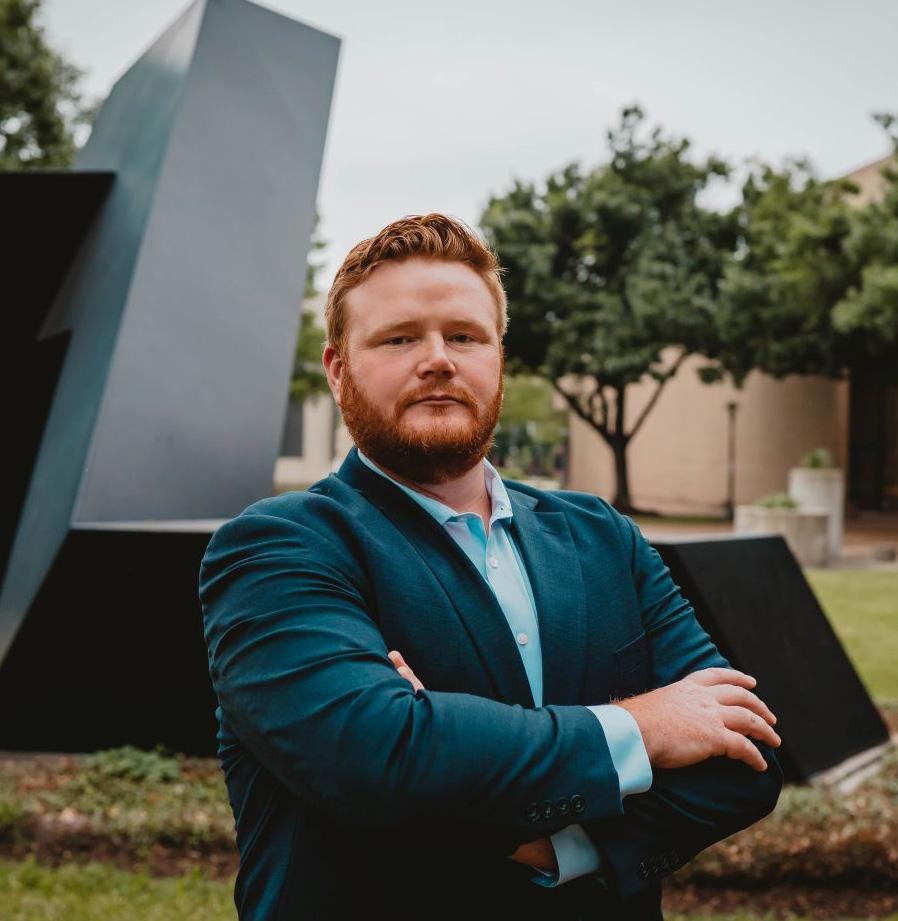
When Clayton Kohn was experiencing one of economic downturns that hit the energy industry and Houston metro area in 2008, he realized that he needed to expand his skills and knowledge. He was working industrial construction at the time, as a pipefitter, and beyond the on-off nature of the work, he was also often hundreds of miles away from his home for months at a time.
However, he chose a route that many others wouldn't in their 20s – he enlisted with the Navy, on a technical track as a fire controlman.
“I had considered the military in the past, because my family has a background in it,” he said. “The economic downturn kind of gave me that extra shove to go ahead and enlist.”
Kohn wasn't working as a firefighter, a common misconception based on the job title. Instead, he was handling IT and networking for the weapons direction and fire control systems onboard the USS Mobile Bay (CG-53), a guided missile cruiser. He served for six years, making lifelong friends and solidifying his work ethic in the process.
“Overall, I do miss being in the Navy. it was a very proud time, and I miss being able to wear the uniform. They always say you meet some of the best friends in the navy, and that's definitely true. I had some of the best times of my life,” he said. “As far as skills, just being in the military in general, it instills a very good work ethic in you. I didn't have a bad one going into the military, but I think it enhanced it.”
That work ethic has now carried over to his studies. Kohn is the 2023 Outstanding Senior for the Petroleum Engineering Department at the Cullen College of Engineering. His decision to further his education was one that had been brewing for a while.
“From the time I got out in February, until I started school in August,” he said. “I felt like I should be using my brain more, and that's what drove me toward engineering.”
Kohn grew up in Texas, and graduated from Louise High School – a small district of about 450 students, with graduating classes typically in the range of 40 students. It's about 90 minutes to the southwest of Houston, past Richmond, Wharton and El Campo. UH's location was a factor in Kohn's college selection.
“Essentially, what really made me choose UH specifically was its proximity to my family. Between working in construction, a good portion of the jobs were out of state, and then six years in the Navy, I was really gone for 10 or 11 years,” he said. “I missed a lot of things. Funerals, weddings, baby showers. The time I was gone was when things were really happening. That's kind of what really drove me to go to UH. At the end of the day, I could have gone anywhere with the GI bill and my military benefits. I looked at their engineering department and they had a whole Rolodex of programs I could choose from.”
It was a decision he made in consultation with his wife, Monique, who he met while
he was in the Navy. She served more than eight years in the Navy as a SONAR technician.
“She's from Albuquerque, New Mexico. When we started dating, I told her from the get go that I was going back to Texas,” he said, laughing.
Kohn attributes his academic success to Monique, as well as his uncle and aunt, Mike and Christie Byrne. While Kohn has been earning his degree at UH, Monique was on an educational journey of her own. She earned her degree in sonography from the Pima Medical Institute, and now works as a traveling ultrasound technologist in that specialty.
“When oil dropped into the negative, and I'm going to school for petroleum engineering, I'm thinking, what have I done?” Kohn said, laughing. “[Mike's] older, so he's like, hey, I've been through this, this is how the oil field works. It's going to go down, it's going to go up, but you're getting into the right industry.”
Kohn said Monique and Mike have been “the two pillars” he's needed while he's earned his degree.
“She has probably suffered just as much as me, during my progression through school, because I am such an OCD overachiever,” he said. “I stress myself and give myself anxiety through the roof, and when I'm stressed out she's supportive and always tries to see the brighter side of things. I honestly couldn't have done things without Monique or Mike.”
THE PETROLEUM ENGINEERING DEPARTMENT HAS SOME OF THE BEST EDUCATORS THAT I'VE GOTTEN TO WITNESS
- CLAYTON KOHN
Kohn said that his uncle has also served as a sounding board for him, when he's struggled with academic challenges or worries about the petroleum industry.
“It was very nice to have that mentorship going through this,” he said. “I was older, going back to school, so learning calculus and chemistry was completely overwhelming for someone 30 years old. He was always there to help guide me and give me positive reinforcement to go through these things.”
He added that he's glad to have chosen to study Petroleum Engineering at Cullen.
“The Petroleum Engineering Department has some of the best educators that I've gotten to witness,” he said. “They're people who truly care about your well-being and answer your questions, and encourage you to come to office hours.”
Kohn graduates in May, and he has already lined up a job with bp.
“I did get hired full-time, and I'll start in late June. I got exactly what I wanted,” he said. “”I wanted to do drilling or production, and that's what I got into, offshore drilling. Mike was a driller for Hilcorp, so he had a lot of influence as to why I chose that path.”
“bp has a great in-house training program, so I can still progress in my career through them. Whatever I want to learn about, I can ask them, to make me better at my job and to make me more well-rounded. I'm excited to go work for them and to start working as an engineer, instead of just training as one.”

When Mayra Martinez was growing up in San Luis Potosi in Mexico, she described it as a very small place with limited opportunities for education. She only attended school until sixth grade, and when she came to the United States in 2014, she was told it was “too late” for her to attend high school.
“I started working in a fast food restaurant, as a custodian is a school district, as a cashier, because I didn’t speak any English,” she said. “I was not even able to order food.”
However, she worked hard to learn English, and earned her GED. She started at College of the Mainland (COM) in 2018, and earned her Associate of Science degree in May 2020.
“When I started community college, I was not able to take notes, because I didn’t know how to write and I had to translate everything,” she said.
Martinez has continued to work hard at the University of Houston, where she is a Petroleum Engineering student. Her effort has been recognized, as she is one of two recipients from UH of this year's Andy Ellis Memorial Scholarship Award from the American Association of Drilling Engineers (AADE).
Ellis, a resident of Katy, passed in 2020 and the first award was given in his honor in 2021. Ellis was a longtime member of the AADE, and served as the president of the Houston Chapter and president of the national association. He was honored with the title of President Emeritus of the national association.
Martinez is now the current president of the UH student chapter of the AADE.
“After pushing myself to be a better version everyday, I have the honor of receiving multiple scholarships this semester,” she said, noting that she graduates this year. “My educational journey has taught me that only the sky is the limit.”
Martinez noted that she wasn't expecting to receive this honor.
“I was surprised because this is one of the most competitive scholarships I have ever applied for,” she said. “I felt so happy to know that someone from our petroleum department was able to obtain the scholarship.”
Attending the University of Houston had always been a goal for Martinez, thanks to the advantages of the area for her.
“I had to choose a local university because I can’t afford to study out of town, but also back in 2014 when I came to this country, I saw the campus and I thought how much I would like to study there,” she said. “Since the first day I started studying at community college, I knew UH was the place where I wanted to transfer to complete my engineering degree.”
Since the first day I started studying at community college, I knew UH was the place where I wanted to transfer to complete my engineering degree.- MAYRA MARTINEZ
Because of her status as a first-generation student as well as her personal educational background, Martinez said she could not have gotten to where she is today without the support of various people.
“Being a first-generation college student has been very challenging when it comes to support or academic influenc-
es, but through my academic life I have met amazing people,” she said. “When I started my education at College of The Mainland, I met my English professor, Dalel Serda), who was also Latina and first generation. She become my motivation to believe I can do it. She helped me to succeed in every way, she motivated me and always believed in me.”
She added, “Also from COM, professor John Mohr has been such an inspiration in the oil & gas industry for me, mentor, role model and very supportive.”
When Martinez began studying at UH, she said she recently plenty of support, but one of her peers assisted her greatly.
“One of my best friends, Edgar Cardona, graduated from UH back in 2018. He motivated me to attend UH, and he brought me to campus to gave me a tour and showed me where my future classes will be. He was very supportive and helpful, and kept me motivated to continue working on my engineering degree.”
Martinez also identified several faculty members in the Petroleum Engineering Department as being major influences in her success.
“I have received such an amazing support from Dr. Lori Hathon. I am glad I had a professor like her who cares about students’ success,” she said. “Dr. George Wong, my petroleum production operations professor, is one of those professors who cares too much about our success.
Martinez graduates in May 2024. She completed an internship as a field engineer with Helmerich & Payne this year, and she also works for Oxy part-time in well servicing. She is exploring her opportunities in industry after graduation, ideally in drilling or production.
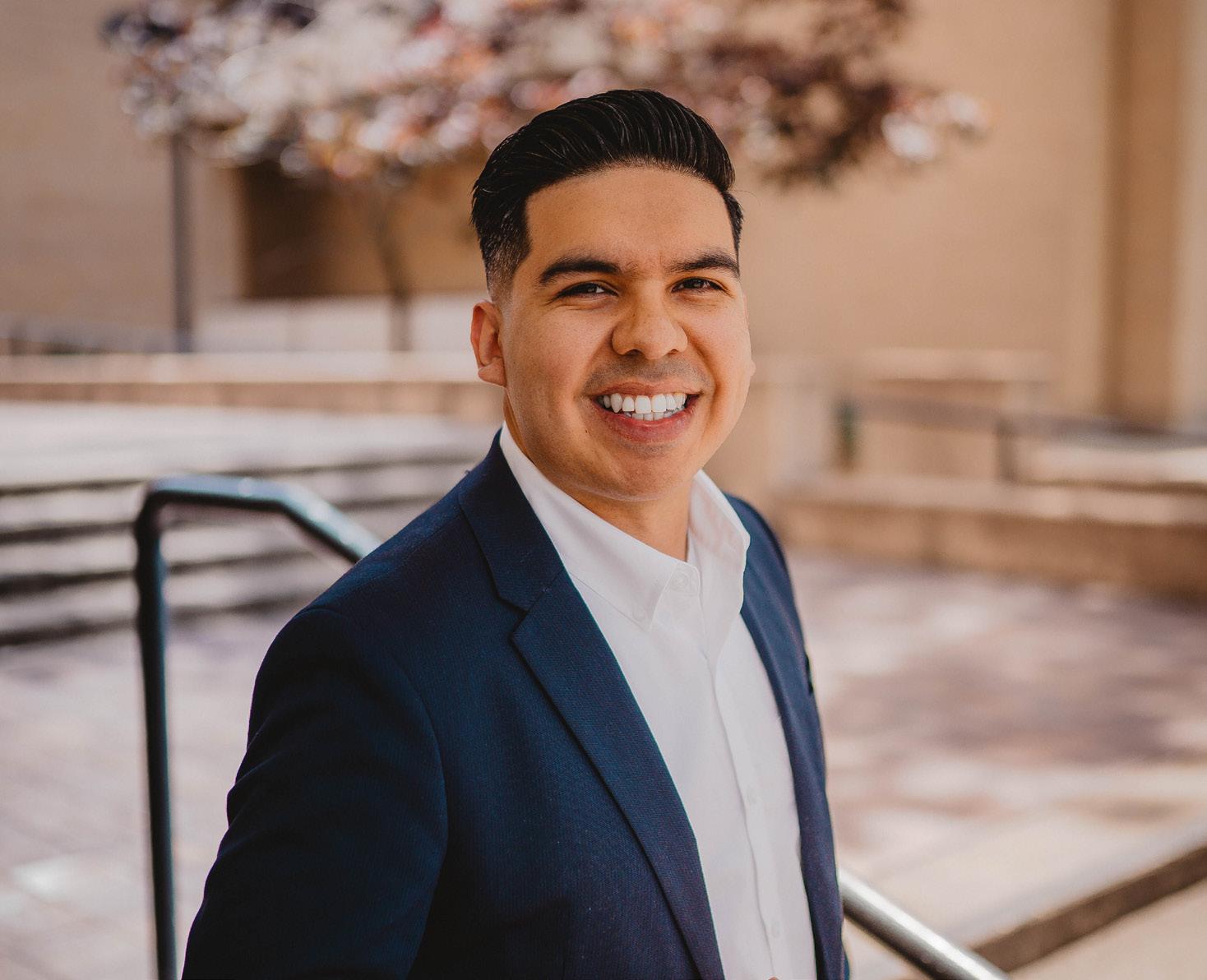
Before he leaves for class each day, Cullen College of Engineering junior Eden Torres has a tradition that he does to help him focus as he heads out the door.
“My family has a little routine before I leave for the day. We do a quick prayer,” he said. “As I walk out the door, my wife says, 'You got this,' and now my 3 year old daughter says, 'You've got this papi!”
Although he didn't take a direct path to get there, Torres always knew he wanted to earn his bachelor's degree in Petroleum Engineering, and he's not just succeeding in that effort – he's excelling.
Torres is the 2023 Outstanding Junior for the Petroleum Engineering Department, and one of the 16 students honored across the junior and senior classes of eight branches of engineering at Cullen. He's earned this distinction while also working part-time and being a father for two children – Eliana and Alexander – with his wife, Ana.
Torres said the economic situation of his family made it tough to consider four-year universities after graduating from Cypress Creek High School. However, his parents
always stressed the importance of education, and he enrolled at Lone Star College. He earned several associate's degrees there, got hired full-time in the Oil & Gas industry and married his wife.
“I got married, and I told my wife that I wasn't done,” he said. “I had a good job with the associate's degree, but my dream was to have my bachelor's. I told her it didn't matter if I was 60 or 70, I was going back to get it.”
Torres noted that it was having his children that gave him the final push he needed to enroll at UH.
“After having my daughter, and planning to have a second child, my son, that's when I decided it was time,” he said. “I was content with life and we lived comfortably, but I knew that was one of my life goals. Becoming a parent really opened my eyes to the importance of being a role model for them.”
Torres was born in the United States, but he lived in Mexico until he was 12. At that point, his parents moved back to the U.S., which Torres realizes was primarily for the benefit of him and his siblings.
“Now as an adult, I realize the sacrifice they made for me and my siblings, of leaving everything behind for a better education for us,” he said. “Obtaining my bachelor's degree I feel will be honoring that sacrifice.”
He identified John Skopak, a Lone Star College professor in the University Park Engineering Technology Department, as a positive academic influence. Torres said Skopak's experience in the oil and gas industry before becoming a professor allowed him to impart practical wisdom to his students.
“He was very passionate about petroleum engineering,” Torres said. “I knew I wanted to do petroleum engineering, but I wasn't 100 percent sure. His energy and his passion for the field, it guided me toward petroleum engineering for sure.”
Torres enrolled at UH in Spring 2021, and his academic success has already been recognized with opportunities outside of the classroom as well. He is completing a co-op with Oxy (Occidental Petroleum), which started in Spring 2022 and runs through the Spring 2023 semester. He also has an opportunity lined up for this summer already.
“I'll be doing a summer internship with BP (British Petroleum), and I'll be doing production engineering. I think at the end of the day, my career will be in production engineering or reservoir engineering. Those are two aspects I really enjoy about petroleum engineering.”
When asked about advice he would have for other students, Torres noted that he tries to be as organized as possible with his tasks and his schedule. In his home office, he has a large dry erase board that he uses to track his parenting responsibilities, work schedule and his academic tasks. He stressed the importance of finding people to provide support, whether that was family, peers, professors or other groups.
“I believe that anyone, it doesn't matter their circumstances, if they have a good support system they'll make things happen,” he said.
Farshad Safi Samghabadi, a doctoral student at the Cullen College of Engineering, has earned second place for his poster presentation at the 2023 Symposium for Frontiers in Soft Matter and Macromolecular Networks.
Safi is a member of the Conrad Research Group, which is led by Jacinta Conrad, Frank M. Tiller Professor in the Brookshire Department of Chemical and Biomolecular Engineering. Safi's presentation is “Diffusive Dynamics of Filamentous Viruses in Crowded DNA Solutions.”
He described his reaction to winning second place as equal parts excited and proud.
“Winning
academic awards has been always a reminder that perseverance and a passion for learning can lead to remarkable
opportunities,” he said. “Also, it is a testament to the support and mentorship I've received throughout my academic journey and it motivates me to continue pursuing excellence in my field.”
Noting that Conrad's group is focused on soft matter, Safi said his work deals with the dynamics – or the study of motion – in charged polymer systems.
“I try to understand how the presence of charges on the polymers alters polymer conformation, as well as solvent and particle transport for both polymers in solution and surface-grafted brushes,” he said. “We are using a variety of techniques such as confocal microscopy, rheology, and ellipsometry to study these systems. We are focusing on controlling and generating functionality in flexible, deformable materials.”
He added, “The results of our studies provide the fundamental insight needed to generate directional movement on soft surfaces and their applications ranging from drug delivery and gene therapy to the design of antifouling surfaces and biosensors.

Part of my studies are in collaboration with Dr. Rae Robertson Anderson at University of San Diego on DNA solutions and Dr. Amanda Marciel’s group at Rice University on polymer brushes. ”
Although it was an individual award, Safi was quick to mention that it would not have been possible without support from others.
“Reaching academic success is a team effort,” he said. “I'm truly fortunate to have had the privilege of working with Dr. Jacinta Conrad. She is such a dedicated and inspiring mentor.”
“Regarding my recent award, I specifically thank Dr. Robertson-Anderson and her group for their amazing contribution to our work. Also, I am lucky to have the greatest colleagues and friends and the most supporting family.”
Safi's anticipated graduation date is Spring 2025. While he finds academia and industry opportunities to both be appealing, for now he's focused on his research.
“While both have their unique attractions, my goal remains consistent – to continuously grow and to apply my skills to make a positive impact by pursuing a career that I can enjoy,” he said. “I am taking steps to make well-informed decisions about my future career by attending UH future faculty program, attending scientific conferences, and considering the possibility of doing an industry internship prior to Spring 2025. Whichever direction I choose, I am committed to embracing the challenges and opportunities it presents, and I look forward to the journey ahead!”
 BY ALEX KEIMIG
BY ALEX KEIMIG

Technology Project Management graduate student Ashutosh Kadukar recently earned the Project Management Institute's (PMI) prestigious Global Accreditation Center (GAC) scholarship award.
The $3,000 scholarship is intended to assist young project management professionals in bolstering their experiences, certifications and qualifications in the industry, and Kadukar is determined to make the most of its potential.
Having earned an undergraduate degree in production engineering in India, his experiences while working at a gearbox manufacturing company are what led him to pursue a master's degree in project management and begin exploring PMI's available resources.
Being part of the PMI Houston Student Venue has also allowed Kadukar to explore and connect with project management contacts around the area, giving him a chance to better understand their industry perspectives and the projects they currently have underway in addition to connecting with other students.
"Technology Project Management is a relatively small group of students, so a student chapter is a great way for everyone in the UH community who is interested in project management to connect, which is a fantastic idea. I didn't even know that PMI had scholarships,” he said. “Zara Rashidbayli has been great about sharing scholarship opportunities and upcoming volunteering and event dates with all of us. Her transparent communication is how I came to know that there even was a scholarship available, and because I received that award this year, the incoming students are really excited to network and explore all of the opportunities available to them out there," he said.
This is what I tell everybody: if you're skilled and interested in management, make sure that you leverage this beautiful flexibility – you can move into nearly any industry and still retain your immense value and impact as a project management professional.-ASHUTOSH KADUKAR
"I began as a design engineer and I slowly progressed into a project management role," he said. "While I was making this transition from engineering to project management, I was also exploring different professional organizations to support my growth. That's how I came across PMI. I thought it was just an organization to help with certifications, but I soon realized that PMI has much more to offer.”
“PMI has chapters and forums that allow individuals from the project management community to connect with each other, which has been great. There are a ton of resources available, like PMIstandards+, which allows me to go through different templates, resources, and standards that can apply to real-life situations. As a student, those resources have really helped with my studies across several courses."
The PMI-GAC scholarship has already allowed Kadukar to pay for his Project Management Professional (PMP®) Certification, and he's also looking forward to enhancing his project-product prowess by earning Professional Scrum Master (PSM™), Wicked Problem Solving (WPS™) Practitioner, and Lean Six Sigma Green Belt certifications.
"Earning these industry-standard certifications will help me stand out in the professional market when I graduate in May 2024. I'm looking forward to finding a role in product or program management, perhaps with a technology or engineering company," he added. "I worked as a Business Office intern at Volvo Group North America last summer. That was an amazing experience and a great starting point for my career in the US, because it enhanced the credibility of my resume and will be a foundation for many potential opportunities in the market."
The specific product, however, is far less pertinent than the need to ensure its production and supply runs smoothly.
"The commodity may change," Kadukar said. "Today, I may be managing oil and gas projects. Tomorrow, I could be handling software projects. Even though I'm growing and gaining valuable experience, my management skills remain consistent. This is what I tell everybody: if you're skilled and interested management, make sure that you leverage this beautiful flexibility –you can move into nearly any industry and still retain your immense value and impact as a project management professional.
Three student teams from the University of Houston recently took first, second, and third place at the inaugural Breakbulk Student Poster Competition at Breakbulk Americas in Houston, Texas – a successful sweep for the Technology Division's Supply Chain & Logistics students.
Breakbulk Americas is a yearly breakbulk cargo and project shipping conference held each fall in Houston. This conference is a key opportunity for industry professionals and students alike to find facetime with potential business partners, to bolster existing relationships and build new ones, and – as of this year – to compete for thousands of dollars in new scholarship awards at the Breakbulk Student Poster Competition.
Chaired by the Technology Division's Supply Chain & Logistics Technology Program Director Margaret Kidd and sponsored by Bechtel, 4D Supply Chain Consulting, UTC Overseas, DP World and the University of Houston, the event gave participating students the opportunity to present their research on the Breakbulk Main Stage at the George R. Brown Convention Center in September.
Due to the timing of the fall semester and the start of classes, most participating student teams had little more than a month to take their projects from early conception to presentation and judging at this first inaugural competition.
"What this showed us is that we challenged our students, and they were up to the challenge," Kidd said.
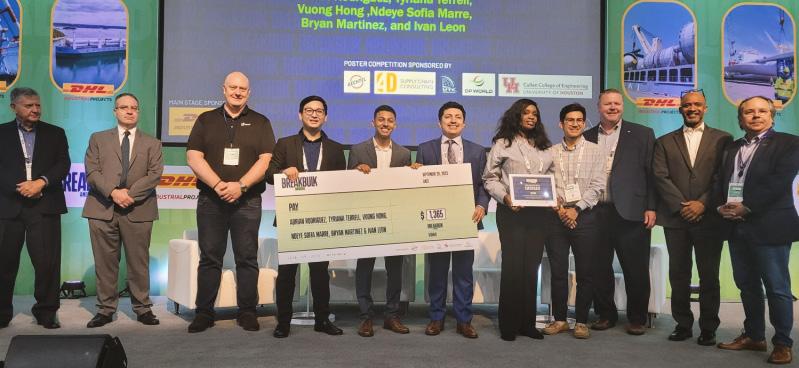
In total, 31 projects were submitted for consideration by teams from both the University of Houston and Texas A&M University at Galveston, and nine teams – first, second, and third place winners, plus six honorable mentions – were recognized onstage alongside their academic advisors and presented with several thousand dollars in total awards.
"It was very exciting to see the high level of engagement from the students. The fervor in wanting to learn from industry veterans and leaders was palpable," said Thomas D. Skellingsted, President, 4D Supply Chain Consulting."
The general focus of the competition was the digitization and continuing sustainability of maritime operations; topics ranged from the state of automation in container ports and risk assessment of cyberthreats to maritime infrastructure to implementing smart port technology and assessing the future of the Kra Canal.
"The Breakbulk poster contest challenges students with industry-intense requirements of thorough research with clear, concise presentation and the opportunity to engage with logistics leaders," said Marco Poisler COO, Global Capital Projects & Energy, UTC Overseas, calling the competition "a great way to build the future."
Steve Spoljaric, Bechtel Corporate Manager of Global Logistics, echoed the importance of affording students and young professionals opportunities to bolster their portfolios.
“Within the engineering, procurement and construction industry, many of our engineering colleagues write technical papers and perform research that creates a pathway to excel in their discipline starting in college. The transportation industry benefits significantly with programs such as this competition so that equivalent fellowships can be recognized for the technical aspects of our profession. It also further
challenges status quo with continuous improvement through new ideas, technology and innovation," Spoljaric said.
"Our team learned that ports of today have potential to evolve and overcome congestion," said SCLT senior John Nguyen on behalf of his first-place winning team. "With digitalization, communication and processes between each stakeholder can become more efficient. And with our research just barely scratching the surface, ports have the ability to easily transition into smart ports after implementing today’s technology."
The opportunities to network seemed to be just as valuable as the awards themselves, which was a sentiment echoed by fellow SCLT student William Day on behalf of the team he competed with.
"Participating in the Breakbulk poster competition was an amazing opportunity because it challenged my team to identify and narrow in on our focus topic, which was global water scarcity, and then collaboratively produce a poster analyzing an applicable solution to this problem. We won third place overall and were able to network with others in the Breakbulk industry, so it was extraordinary to be distin-
guished and grow ourselves professionally in the process," Day said.
As a collaborative effort between the University of Houston, Breakbulk Americas and industry sponsors, the nascent competition achieved its goal of bringing together students and professionals to benefit the local and global breakbulk and logistics sectors by allowing both parties a glimpse into their shared futures.
"DP World has always supported communities, including educational opportunities, where we operate. We hope to support growing the poster competition at future Breakbulk events and providing more scholarship funding opportunities for students for in-demand degrees.
"We see these students as part of the next generation of leadership for the logistics industry. We hope they consider our world-class company as an option when they graduate," said
Nick Geale, Vice President, DP World.
The success of the Technology Division's winning teams was the proverbial feather in the University's cap.
"I'm so proud of all of the students that participated along with the support from my colleague Dr. Al Henson," said Kidd. "They made a major investment of their time and effort, and you can really see the teamwork that went into each of these projects concerning key development goals for the industry. This is such a unique platform where industry and academia come together. We've got to take advantage of that to keep supporting students, building relationships, and growing the industry."

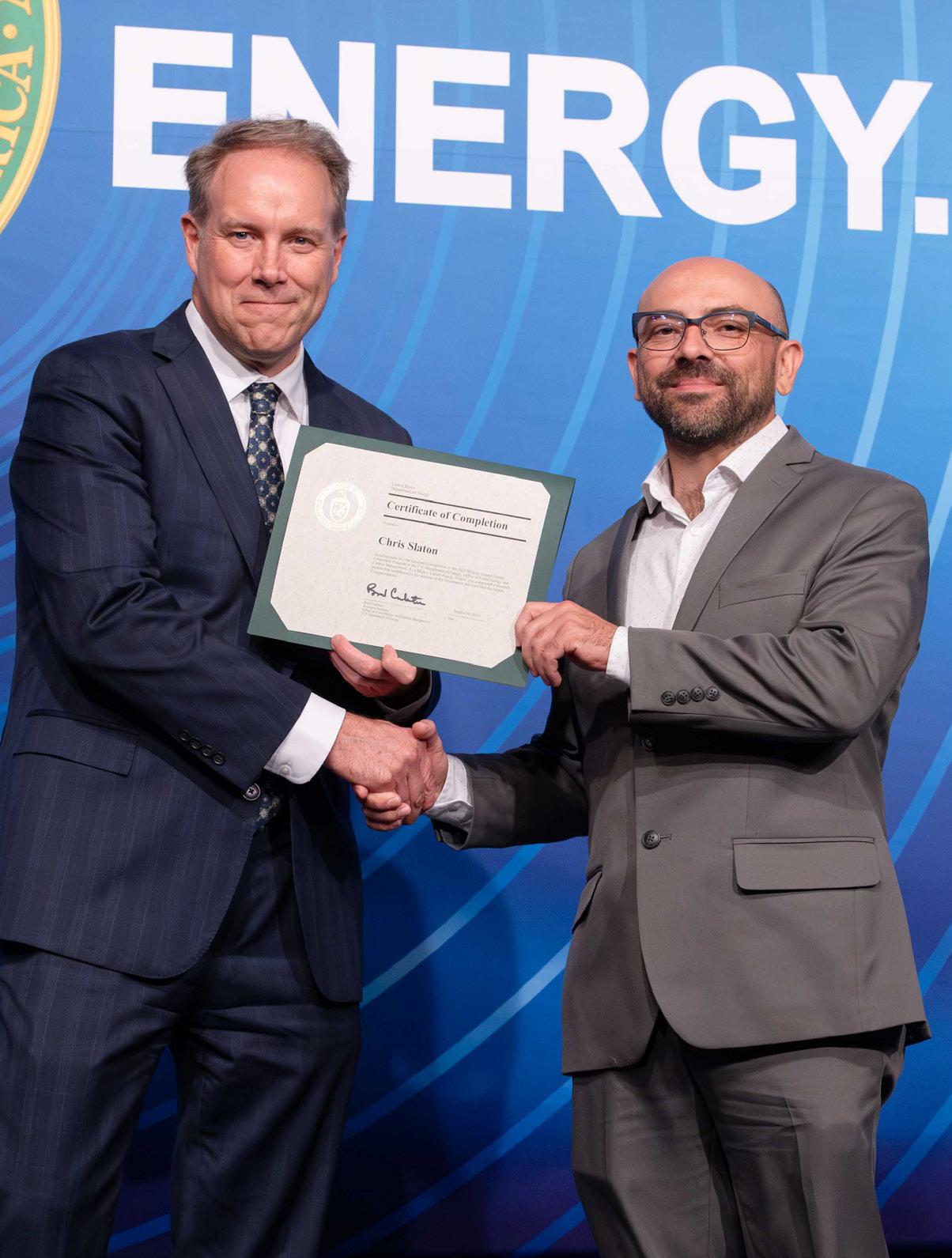
In 2021, the United States and 18 other global nations made the pledge to pursue a goal of net-zero carbon emissions by 2050 via launching the Net Zero Government Initiative. It's a lofty goal and that will require dedicated minds from countless areas of special study to become a reality.
Mechanical Engineering senior Chris Slaton's work with superalloys over the summer as a Mickey Leland Energy Program fellow with the U.S. Department of Energy (DOE) and Office of Fossil Energy and Carbon Management (FECM) was one piece of a larger puzzle that seeks to bring us one step closer to reducing our net carbon emissions to zero by the year 2050.
"I really want to get into the energy sector, so I thought this was a perfect opportunity to jump in and do some research with the DOE for the FECM," Slaton said.
Superalloys are complex, high-strength alloys – materials made by combining two or more metallic elements – with an impressive ability to resist both intense stress and extremely high temperatures.
One greener energy option currently under investigation in the United States is the use of hydrogen to generate electricity. Though it burns cleaner than traditional fossil fuels, it also burns much hotter. Existing systems would need to be upgraded with new nickel superalloy components to meet the challenge, and meeting this need is what makes identifying the ideal chemical composition of the right alloy so important.
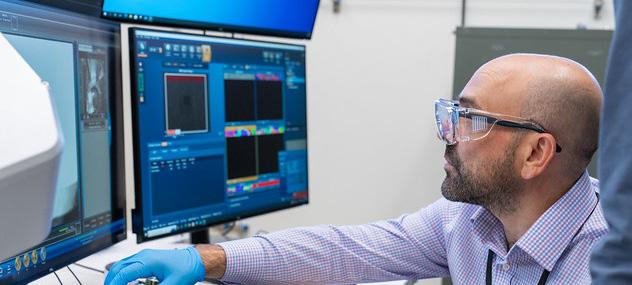
"In terms of the specific alloy I was investigating, we're really looking for a replacement for turbine rotors. With our current technology, systems often use steam, wind, water or gas to move rotors and thereby generate power,” Slaton said. “These alloys we're investigating are specifically intended for hydrogen turbines. To successfully handle burning hydrogen, they need to be able operate at much higher temperatures, so you need a stronger material to be able to reach and withstand those high temperatures for sustained operations.”
Grain structure – the physical microstructure that gives a superalloy its high-performance characteristics – is something of tiny scale but huge importance. Slaton spent the duration of the summer program using electron microscopy and electron backscatter diffraction to investigate three variations (each containing a slightly different amount of carbon) of Nimonic 105, which is an alloy of particular interest. These tools can provide important clues and additional context that help guide the process of material selection for specific industrial tasks.
Slaton's investigation, however, was only the tip of the iceberg.
"My roommate – the other participant that I stayed with in Oregon – was working on a related project, but more for the pipelines themselves,” Slaton said. “He was investigating coating technologies to help reduce the effects of hydrogen corrosion on the current pipelines, which would allow us to use the pipeline that's already in the ground to move hydrogen.”
Retrofitting existing structures and systems to the fullest extent possible not only further reduces waste and emissions but reduces additional labor and delays that could impede the United States' ability to meet the proposed 2050 deadline.

"I realized that we have all of these projects over at the DOE all focused on achieving one goal, and that is being able to provide clean energy,” he said.
“I think the scale at which there's cohesion across the DOE and how they and the FECM bring together all of these projects to focus on their goal of net zero carbon emissions by 2050 is just awe-inspiring."
In August, the program concluded with a forum that allowed participants to present their research work and project findings.
"The Technical Forum at the end of the summer went really well. We got to meet the Secretary of Energy, and we got to speak with a lot of people, and we got to see everybody's projects. Some of them were incredibly technical – that was really impressive. You could really tell how much they focus on bringing in new scientists to the DOE. They put a lot of energy into making sure they get the people they need to move the mission forward," Slaton said.
Having now returned to Texas, Slaton hopes that his knowledge and experience will help him find further research opportunities with a material science lab at the University of Houston.

Upholding the high standard the group set the previous year, the University of Houston's Institute of Industrial and Systems Engineers has earned the Gold Chapter Award for the 2022-23 academic year.
The president for the preceding academic year was Diane Nguyen, who is now a senior industrial engineering student at the Cullen College of Engineering. She said that when notified of the award, she was “extremely proud” of her fellow UH IISE officers that made it possible.
“This was something we had worked toward for an entire year,” she said. “We were able to see our chapter's missions and goals be recognized, and I also felt a lot of excitement for the future. It seems like our organization from last year, we're continuing to get the gold award year after year. I'm excited to see how we can go and the impact we can make in the future.”
Nguyen said that like many aspects of life, the group's operations were severely ef-
fected by the pandemic. The focus since 2020 has been on rebuilding connectivity between students, and between the group and others on campus.
“Transitioning from a COVID environment, we wanted to get more community engagement and connect with our peers,” she said, adding that they asked members for a list of events they wanted to participate in.
“We had a lot of team building events
Our goals for the upcoming year are straightforward - to unite IE students into a strong, supportive team with a single mission – growth- Abdulrahman Aljahmi
that allowed the officers to get comfortable with one another. To make sure we stayed on track, we did a lot of future planning, to make sure it worked with our schedule and our peers' schedules and classes. We tried to improve our documentation, so that the department can keep track of our projects and activities, and to make sure that we're successful for the upcoming years of IISE.”
Nguyen noted that the majority of officers for 2022-23 were women. As a result, they partnered with the UH Society of Women Engineers for an event, which features major companies like Dell, HP, Williams, TechnipFMC and others. The group also took manufacturing tours at Powell and TechnipFMC, and hosted guest speakers from National Oilwell Varco, SLB (Schlumberger Limited), Cisco and Williams.
Nguyen cited these speakers and tours, as well as one-on-one resume cafes and mock interviews, as important part of what UH IISE offered members. This was also the first year that the group was able to host Lean Six Sigma Green Belt certification in person at the UH campus.
“Many of our members happen to first generation, so it's important to show them that this can be a work environment you can be involved in,” she said. “Our members were in a better position to land those internships.”
This summer, Nguyen had an internship with Boeing, and the previous summer she interned for Schlumberger, which she attributed partly to her IISE membership.
“Its helped me a lot connecting with peers, both alumni and current students,” she said. “I've gotten a lot of mentorship through it, with the help of Poria Dorali, Sofia Martin, Emi Diaz and Elizabeth Richardson. I would not be where I am today without them. They've provided so much guidance to me as a first gen student.”
The officers for 2022-23 were Nguyen (president), Richardson (vice president), Eunice Alvarenga (treasurer), Erah Noor (operations coordinator), Amy Melendez (secretary), Sharon Moonsammy (activities coordinator), Arsalaan Siddiqi (membership coordinator) and Dulce Zamora (marketing coordinator). Yaping Wang, instructional associate professor in the Industrial Engineering Department, served as faculty advisor.
"This Gold Award is a testament to the unwavering dedication, hard work and passion demonstrated by all student officers of 2022-2023 UH IISE chapter, especially our previous president, Diane Nguyen, and vice president, Elizabeth Richardson," Wang said. "The chapter's collective commitment to excellence and serving our students and local community in the field of Industrial & Systems Engineering is truly commendable. It was a great pleasure to supervise those outstanding student officers."
Officers for 2023-24 are Abdulrahman Aljahmi (president), Neev Dash (vice president), Ruben Romo (treasurer), Roy Castillo (operations coordinator), Anthony Ung (secretary), Paul Kunchandy (activities coordinator), Collin Sellers (membership coordinator), Leah Jobby (marketing coordinator) and Mireille Murphy (marketing coordinator).
"Our goals for the upcoming year are straightforward - to unite IE students into a strong, supportive team with a single mission – growth," Aljahmi said. "We're committed to empowering each other, fostering connections with industry partners and securing another Gold award for the 2023-2024 academic year, to proudly represent UH. In essence, it's about students coming together, growing together, and excelling in industrial and systems engineering. It's all about unity and progress."


This year's Cullen Gala, formerly known as the Engineering Alumni Awards Gala, will now be held during the Fall semester and serve as a fundraiser for the next generation of College of Engineering and Technology Division students.
The chair for the event is Zafar "Zaf" Tahir, who earned his B.S. in Electrical Engineering (’84) from the University of Houston, as well as an MBA (’99). He is a member of the Executive Leadership Board, and a member of the City of Houston Planning Commission and the Airport Commission. He is also a member of the Bauer College Board.
Tahir has extensive experience in industry as an engineering and a business owner. Tahir's first engineering job out of college was as an automation and control systems engineer on the Houston Ship Channel in 1984, working on automation of machine tools and Gantry robots. Following this, he also worked for Automaker of Houston, Ciba-Geigy of Basel Switzerland, BL Technology and Phillips Petroleum.


Tahir earned his law degree in 2012 from Texas Southern University. His firm, ZAF LAW, is based in Houston.
"The Inaugural Cullen Gala is an opportunity to highlight how far engineering and technology have come in the Houston region, known worldwide as not only the Energy Capital, but the Global Hub of Engineering & Construction, Petrochemicals, Medicine, and Medical Technologies, and one of the fastest growing Centers of Innovation, alternate fuels and new technologies. We invite industry, alumni and community leaders to come together in celebration with UH Cullen.”
The Cullen Gala takes place on October 10 at the Hilton Americas in downtown Houston. In addition to Tahir, Lisa Sikora (’90, MBA ’91) and David Sikora (’86) will serve as part of the honorary committee.
Information about table sponsorships is available on the gala’s website www. egr.uh.edu/cullen-gala or by emailing Cathy Brown, Director of Relations at cmbrow31@central.uh.edu.
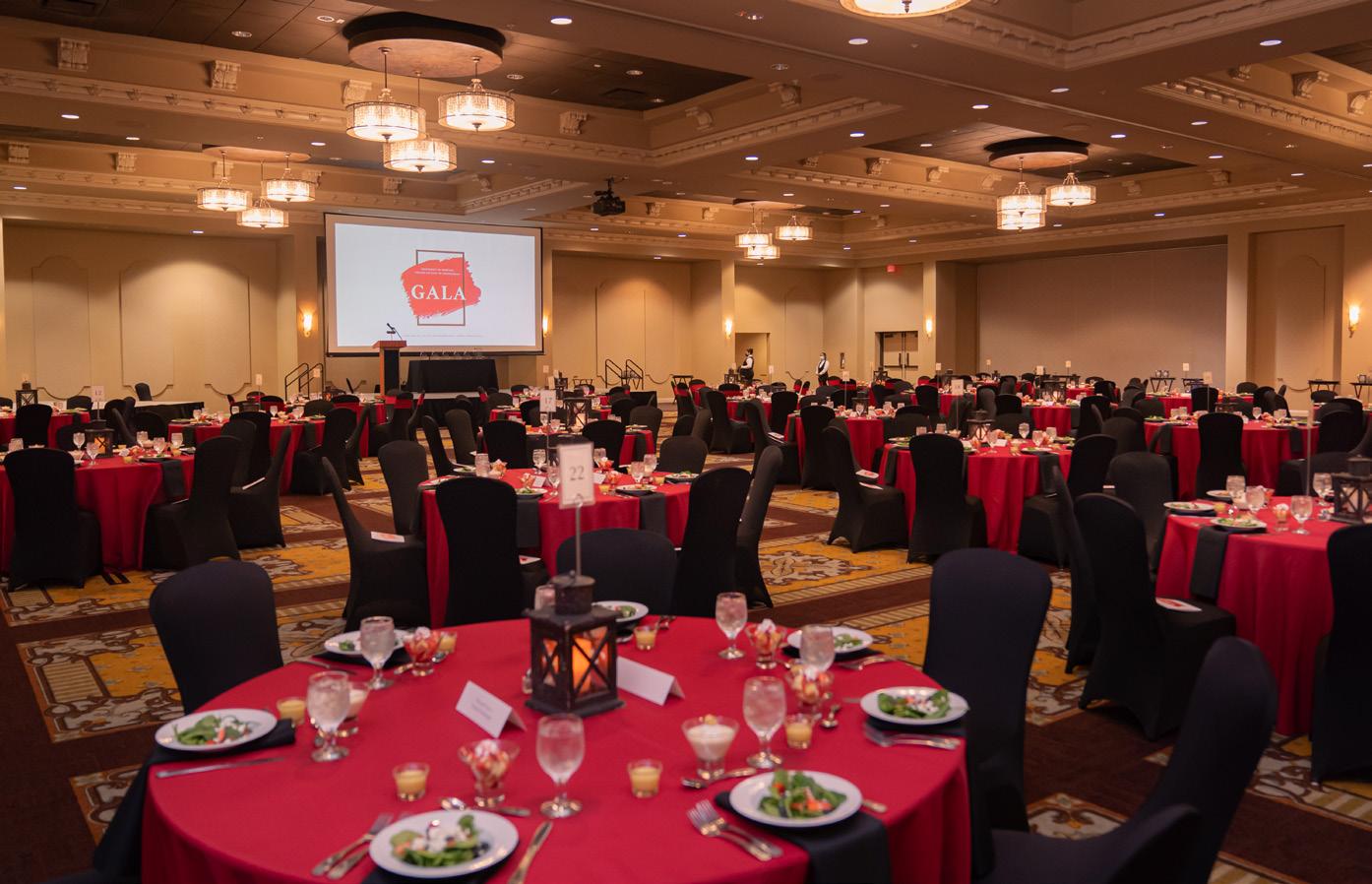


David Sikora ('86) has served as CEO for two NASDAQ-traded software companies and an independent board director for 12 venture capital-backed software companies and four NASDAQ-listed firms, but his career journey started when he earned his Bachelor of Science degree from the University of Houston's College of Technology Division.
"I have very positive professional and personal memories of my time at UH College of Technology," Sikora said. "On the professional side, the school well prepared me for the dynamic technology industry. By providing a solid technical knowledge platform, UH has enabled me to keep pace with the profound industry changes that have occurred since my graduation. Personally, I was blessed to attend UH during the Phi Slama Jamma days, and those experiences have made me a 'lifelong Cougar."
After earning his initial degree from UH, Sikora also studied at the Harvard Business School, and received his MBA there. He quickly advanced to management positions in his career, starting with serving as president and CEO of the ForeFront Group. He led the company through its IPO in 1995, which was the first internet software company IPO in the state of Texas.
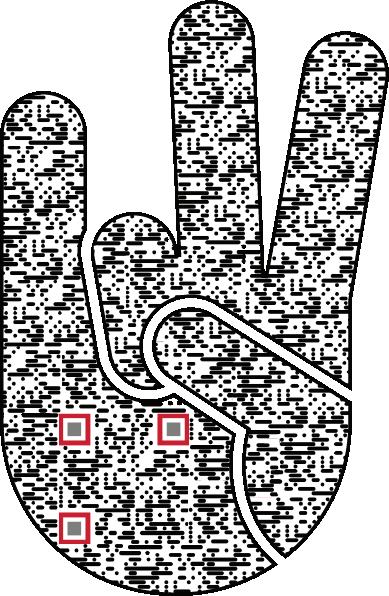
His work has taken him across the globe, as he has logged time doing business in practically every continent, but his Texas roots have remained strong throughout. Most recently, he was named Board Chairman for TDECU, the largest state-chartered Credit Union in Texas. Currently at $5 billion in assets and more than 1,000 employees, TDECU serves 400,000 members throughout Texas.
I have very positive professional and personal memories of my time at UH College of Technology.
- DAVID SIKORA
Sikora is also the Lead Board Director for ALTR, an innovative data security software company based in Austin. He also serves as Strategic Advisor and CEO Mentor for Loop & Tie, Cognota, and Aim4Hire, all companies in the technology sector.
During his 35-year career in the software industry, Sikora has also served as CEO of 2 NASDAQ-traded software companies, Pervasive Software in Austin, Texas and The ForeFront Group in Houston Texas, as well as 5 Venture-backed software companies.
His charitable endeavors include founding and managing the Girl Scouts Lone Star Council Pervasive PowerCharge, serving as Chairman for the Leukemia and Lymphoma Society’s Light the Night Walk and serving as a honorary committee member for the inaugural Cullen Gala.
In his free time, Sikora enjoys golfing, skiing, hiking and running. He has completed nine marathons with a PR of 3:32. He has been married for 38 years to his wife Lisa ('90, MBA '91), and he has three daughters and two granddaughters, with one on the way.
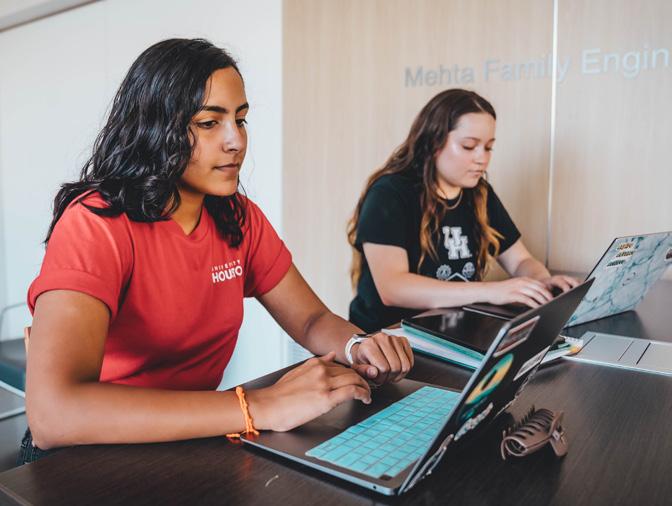
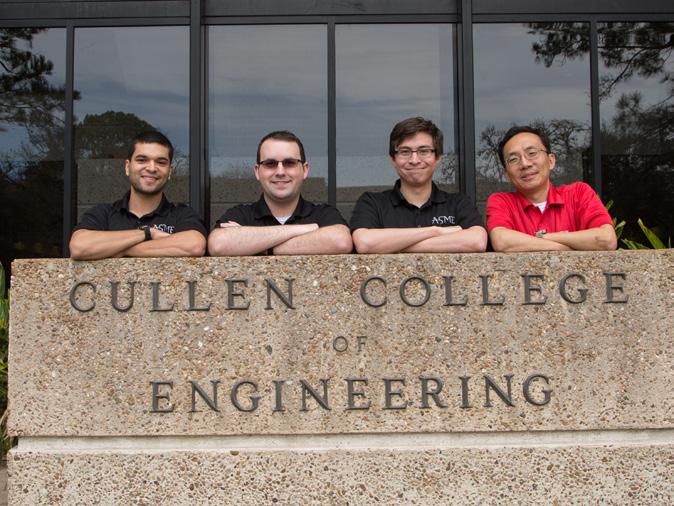

When Wenhua Cao first arrived at the University of Houston to start his doctoral work in the Industrial Engineering Department, he wasn't new to just the school – It was his first time spending significant time in the United States as well.
“The initial experience was overwhelming. But if I reflect on how I felt about the atmosphere at UH then, two words come to my mind – vibrant and welcoming,” he said. “Thanks to that, I think I adjusted very quickly to this new life and became comfortable with it.”
Cao arrived in 2007, and completed his doctorate in 2012. While he came to UH partially because of a robust scholarship package and the available research topics to him, the size of the metro area also attracted him to the school.
“I always wanted to go to university in a large city. Houston has an extremely diverse population, which I really preferred. I think it is big plus for many international students like me,” he said. “I also thought about the ample potential job opportunities after I obtained my degree in Houston. I am very happy I made the right choice. Since moving from my home country to the U.S. for graduate school in 2007, then immediately starting work, I have been in Houston. I really enjoy living here.”
He is now an associate professor in the Department of Radiation Physics, a Division of Radiation Oncology at the University of Texas MD Anderson Cancer Center. He joined MD Anderson as an assistant professor in 2016.
“I had so many memorable moments with UH,” he said. “Watching my first football game at Robertson
THERE ARE COUNTLESS PRECIOUS MEMORIES. I ALWAYS FEEL FORTUNATE THAT I COULD BE A PART OF THE UNIVERSITY OF HOUSTON.
-WENHUACAO
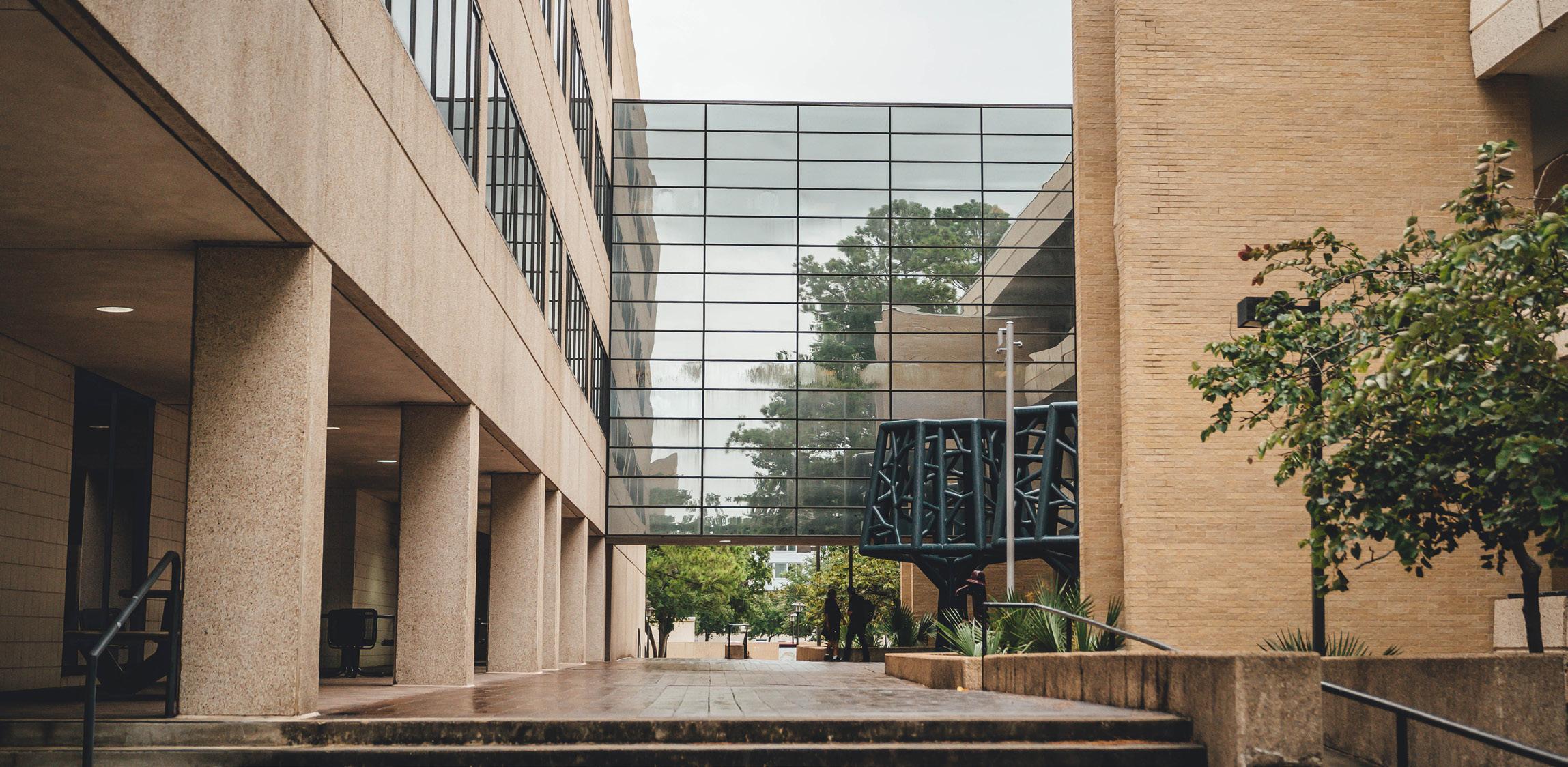
Stadium. Practicing for my driving test at parking lots and streets around the campus. Going through Hurricane Ike without electricity on the campus and apartment for days. Studying hard together with classmates on exams and projects when trying to take as many as possible classes in the first year. Discussing research with a former senior lab mate in the empty engineering building during weekends and holidays. He had graduated and was working for a company, but he was willing to come back and meet with me often.”
He added, “There are countless precious memories. I always feel fortunate that I could be a part of the University of Houston.”
Cao's advisor was Gino J. Lim, professor and R. Larry and Gerlene (Gerri) R. Snider Endowed Chairman of the Industrial Engineering Department. While at UH, the two earned a substantial research grant for nearly $880,000, and Cao said that Lim was a significant, positive influence on him.
“He was instrumental in my growth on many different fronts,” Cao said. “He introduced me to the field of radiation therapy and health care industry, where I eventually developed my career. He supported me overcoming various obstacles and difficulties throughout my academic and personal life as a Ph.D. student. He set an example of how to excel being an independent researcher and leading others. After I left UH, he became a research collaborator and a friend to me. I still interact with him frequently.”
Beyond Lim, Cao said he couldn't have completed his doctorate without the support of others.
“I want to offer my special thanks to other faculty members, staff, lab mates and classmates from the department and college,” he said. “They all helped in one way or another. Fin-
ishing a Ph.D. is never easy. And it is not just hard work on your own. You really need a lot of support from people around you. I feel very grateful to everyone who I met and helped me during my time at UH. The positive experience at UH played an important role in motivating me to make my career in academia.”
The MD Anderson Cancer Center is a nationally-recognized leader in care and research, ranking as #1 for the past nine years, and as either #1 or #2 every year dating back to 1990, when U.S. News & World Report first started its survey. Cao said he is proud to be part of the faculty there.
“My primary job is research, and I also help the clinic develop radiation therapy treatment plans for patients,” he said. “The central goal of my research is to make radiation therapy treatments more effective and efficient, and most importantly, safer to the patients, using novel mathematical optimization and artificial intelligence techniques. In other words, using computer programs to instruct radiation machines to deliver radiation to the right location in patient body in right amount at the right moment.”
“In research, we constantly challenge ourselves to better understand where is the right location, what is the right amount, and when is the right moment. At the same time, we need to figure out robust software and hardware systems to achieve those. The perk of my work is if your research is great, it can be used in the clinic quickly and help lots of patients.”
Cao has published regularly at MD Anderson, and he is listed as an author for four articles alone in 2023.

In an engaging conversation with STEMINIST podcast host Camilla Flores, Eliza Paul P.E, an esteemed #CullenCollege Alumni and District Engineer for TxDOT's Houston District, provides insights into her educational and professional journey. Eliza discusses her academic achievements and sheds light on her remarkable career trajectory. As an international STEM student, she shares her experiences and challenges, offering valuable perspectives on navigating the field. Eliza also delves into the project scope within her current role as a District Engineer at TxDOT, providing a glimpse into the responsibilities and opportunities she encounters in her position.

Eliza Paul, P.E., is the Houston District Engineer for TxDOT's Houston District.
She is responsible for overseeing the planning, designing, building, operation and maintenance of the state transportation system for the six counties in the district.
Paul earned her Bachelor of Science degree in civil engineering from Imperial College of Science and Technology in London in 1984 and a Master of Science degree in civil engineering from University of Houston in 1988. She began her career as an engineering assistant in Houston District Laboratory in January 1989 where she worked on different geotechnical designs for numerous projects throughout the Houston District.
CF: Welcome Eliza to the STEMINIST podcast. Could please state your name and tell us about yourself?
EP: I’m glad to be here! My name is Eliza Paul, and I am the Houston District Engineer with the Texas Department of Transportation (TxDot). In my position I’m responsible for overseeing the planning, designing, building, operation and maintenance of the state transportation system for six surrounding counties, Montgomery, Fort Bend, Waller, Brazoria, Galveston. I am also a UH alumni. I earned my Master of Science degree in civil engineering from the Cullen College of Engineering.
CF: Thank you, Eliza. Can you tell us a little bit about your STEM education journey?
EP: Sure. I’m from Hong Kong originally and before coming to UH for my master’s, I earned my bachelor’s degree in London from the Imperial College of Science and Technology. My parents are the ones that wanted me to come to the United States and the only university I applied to was UH.
CF: What would you say is the biggest project that you’ve worked on?
EP: We have a lot of projects. We currently have about 300 projects in construction right now. The biggest project that we’ve been working on for a long time is the 45 North Houston Highway Improvement Project. This project is a planned reconstruction of 1-45N, between Houston’s downtown and the North Sam Houston Tollway.
CF: What made you want to pursue a degree in civil engineering?
EP: I always wanted to build something. Out of all the engineering specialties, I was drawn to civil engineering because you’re building something that you can see, i.e., bridges, buildings, roadways.
CF: Your educational journey spans from London to Texas. How do you think this impacted your professional career?
EP: Being in different countries helped me to learn how to work with different cultures and people. The number one thing I’ve learned, in all walks of life, you must learn how to deal with people. Sometimes you may not be right, and even if you are right, there are times that you may have to give and take. There are things that you must do to give and take to get a collaboration and to keep something going. Learning how to deal with people is one of the greatest things.
CF: Is there anything else that you would like to share with us about yourself?
EP: Yes. One interesting thing about me is that I met my husband here at UH. My husband, Paul is the Texas State Representative for the Clear Lake area, House District 129. He’s also a UH alum, earned his master’s degree in civil engineering from the Cullen College of Engineering the same year I did.
The STEMinist podcast aims to support an underrepresented topic: science communication. The podcast project seeks to improve science communication skills and give a voice to women in STEM fields, and features students, scientists, engineers and industry leaders. Nicole Guinn served as the podcast’s primary host for seasons 1 and 2. Season 3 featured five student hosts: Aria Shankar, Michelle Patrick-Krueger, Nusayba El-Ali, Sarah Mukhida and Trinity Doan. Season 4 of the podcast features hosts Camila Flores, Nusayba El-Ali and Moriah Bisewski.
STEMinist returned this fall for season 4. Listen to new episodes online, or start from the beginning, at www.egr.uh.edu/ news/podcast or on Anchor, Spotify, or anywhere else you get your podcasts
LISTEN TO THE FULL EPISODE AND OTHERS AT: www.egr.uh.edu/news/podcast
The Cullen College of Engineering Golf Tournament teed off at the BlackHorse Golf Club last September. This was the first college event as a newly merged institution with engineering and technology alumni and donors in attendance. This tournament attracted golfers from across the Houston area including alumni, donors, current faculty, industry partners and other friends of the College.

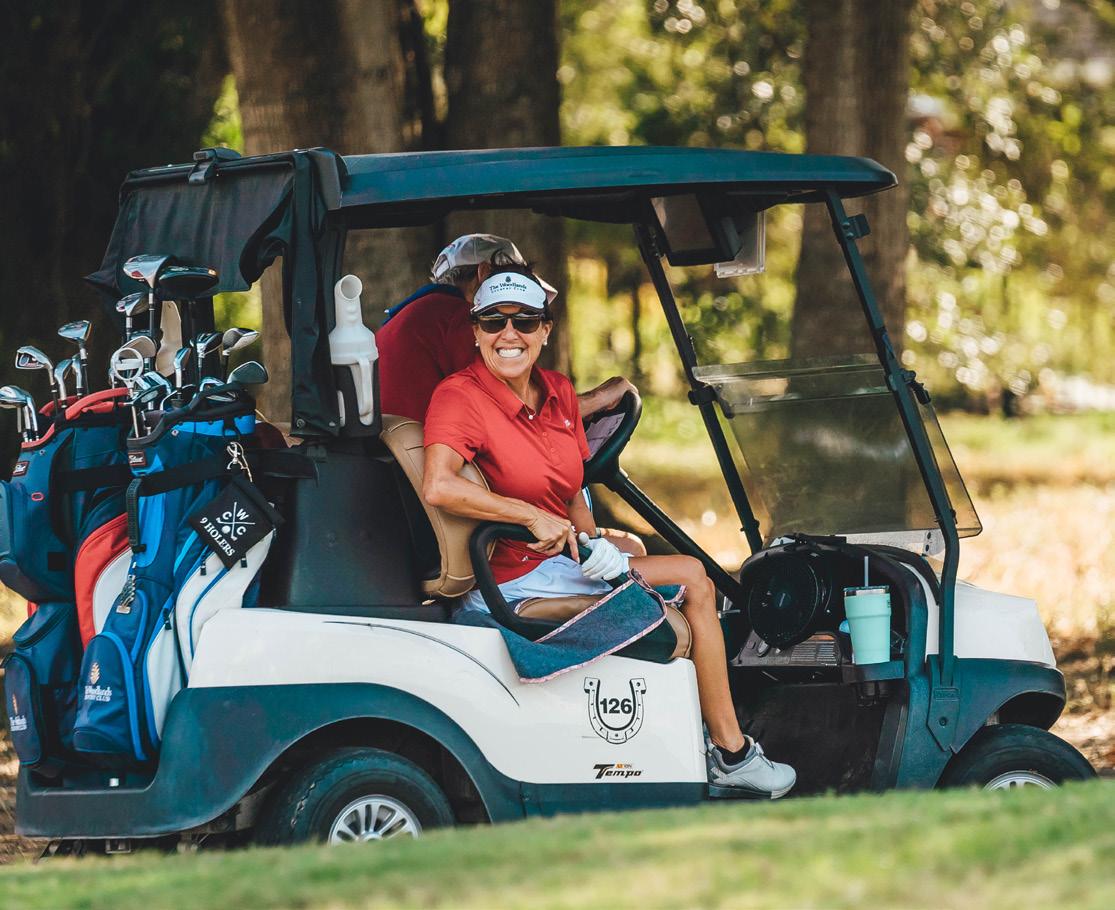
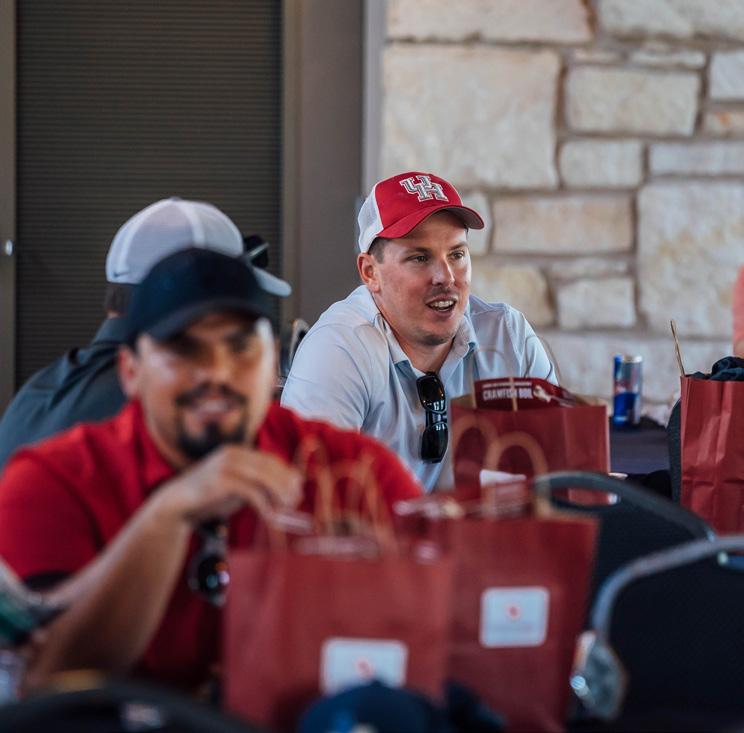
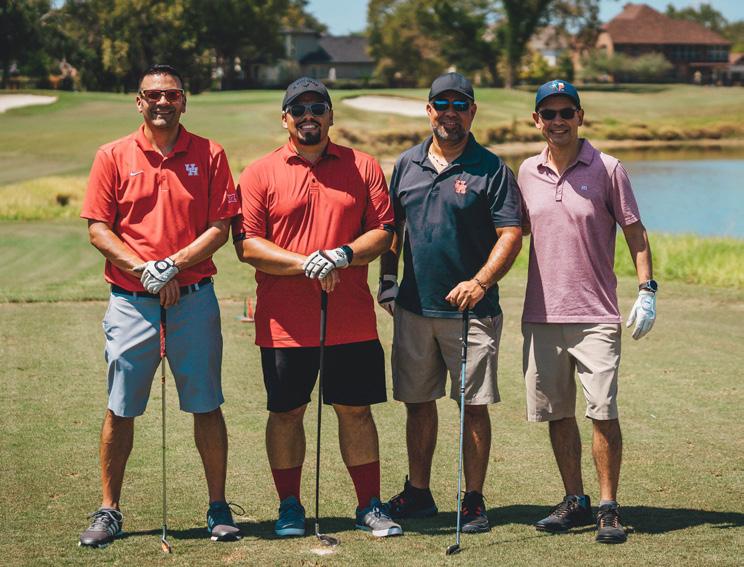
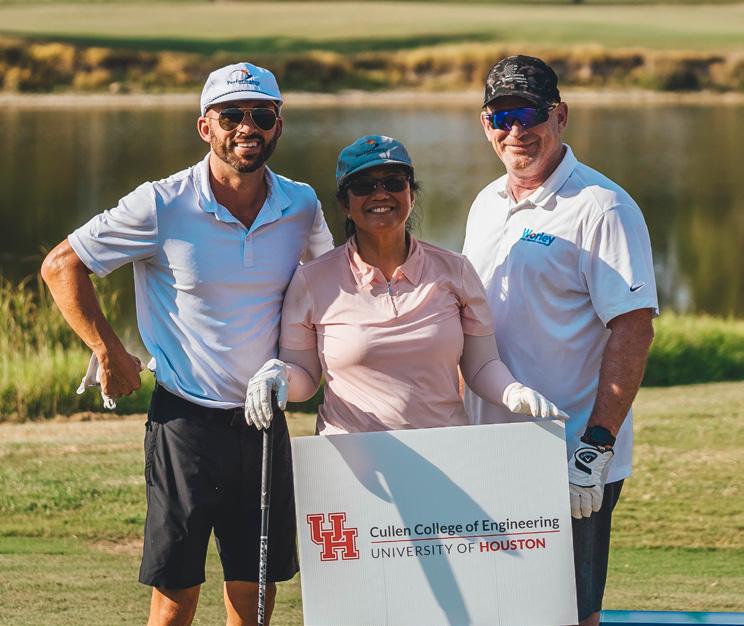

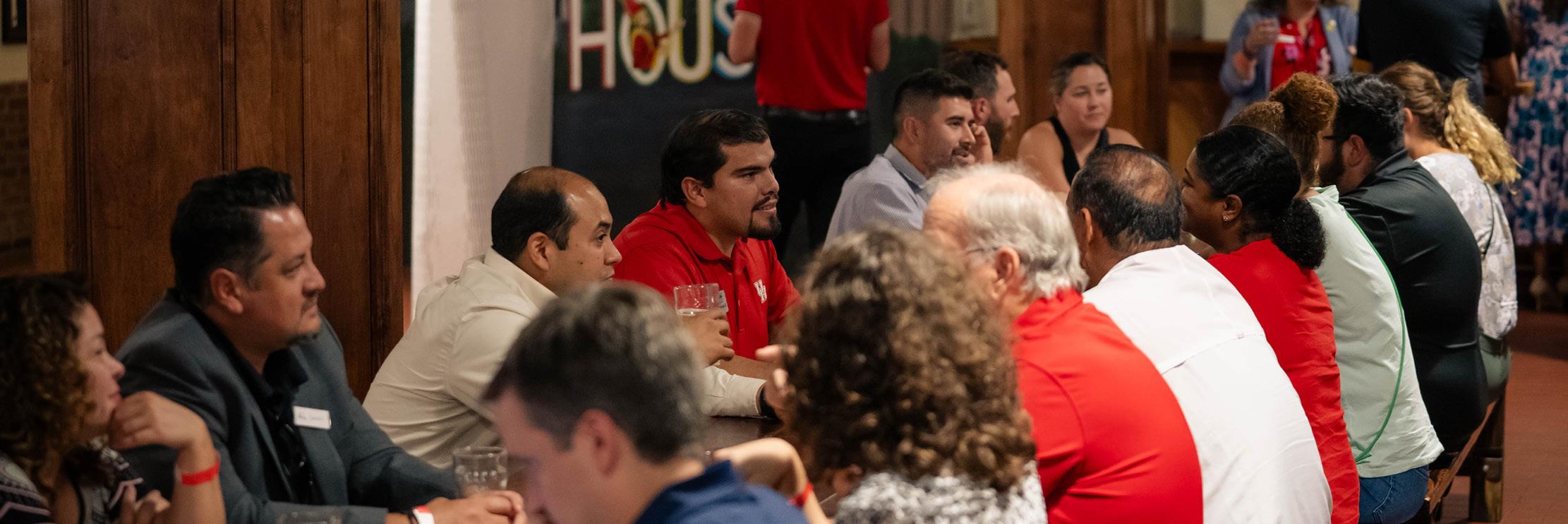


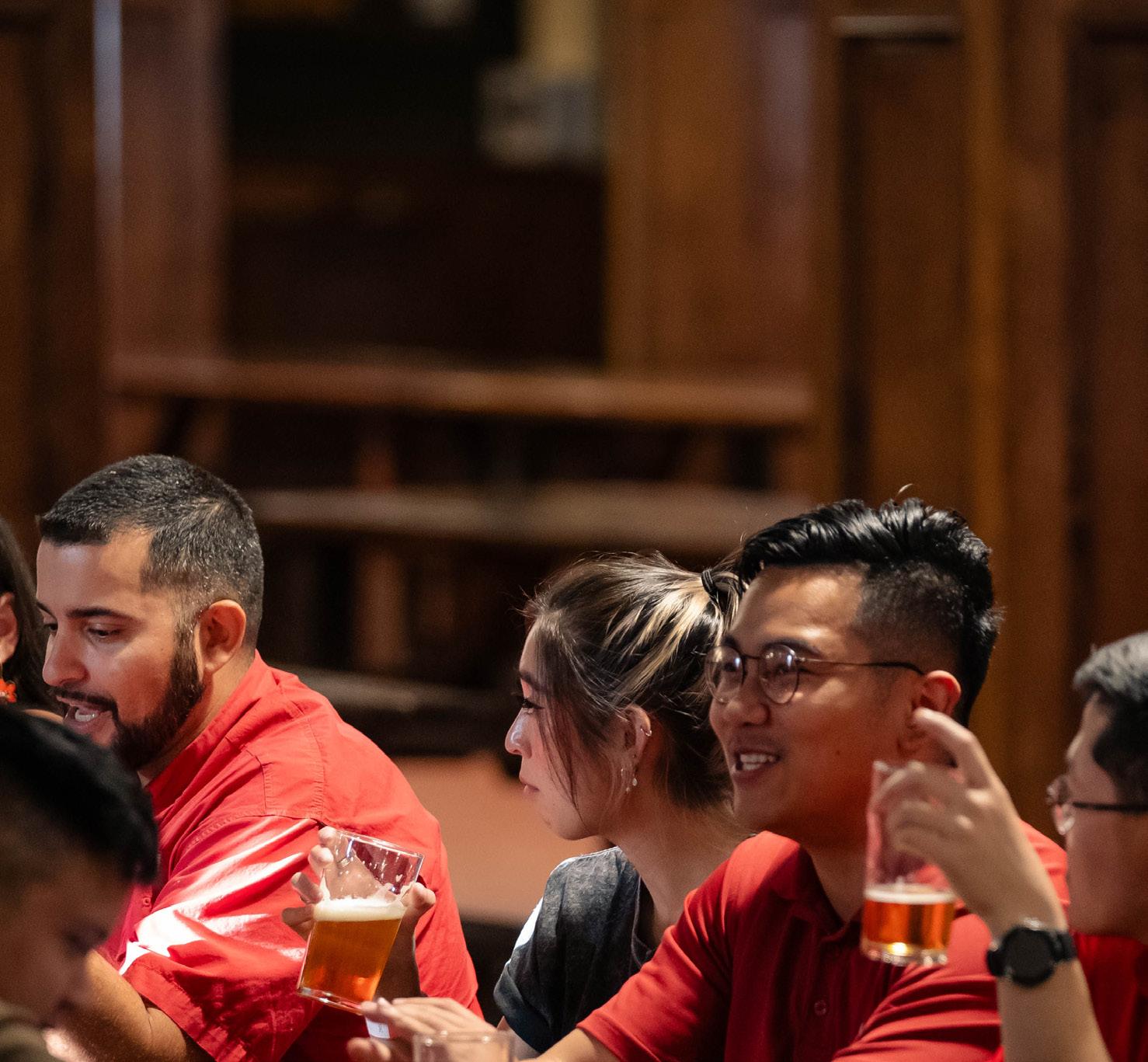
The Engineering Alumni Association Annual Meeting hosted by the Engineering Alumni Association returned to Saint Arnold Brewery Company last August. The annual meeting is an opportunity for alumni to connect, network and learn more about updates and happenings at the College.


The Beginning of Semester (BOS) Party was held in late September and was sponsored by Fluor Corporation. The event is a fun opportunity for students to let loose and check out the College’s many student organizations. Food, drinks, and games are available to attendees free of charge, and students can even try their hands at drenching a professor at the ever-popular dunk tank.
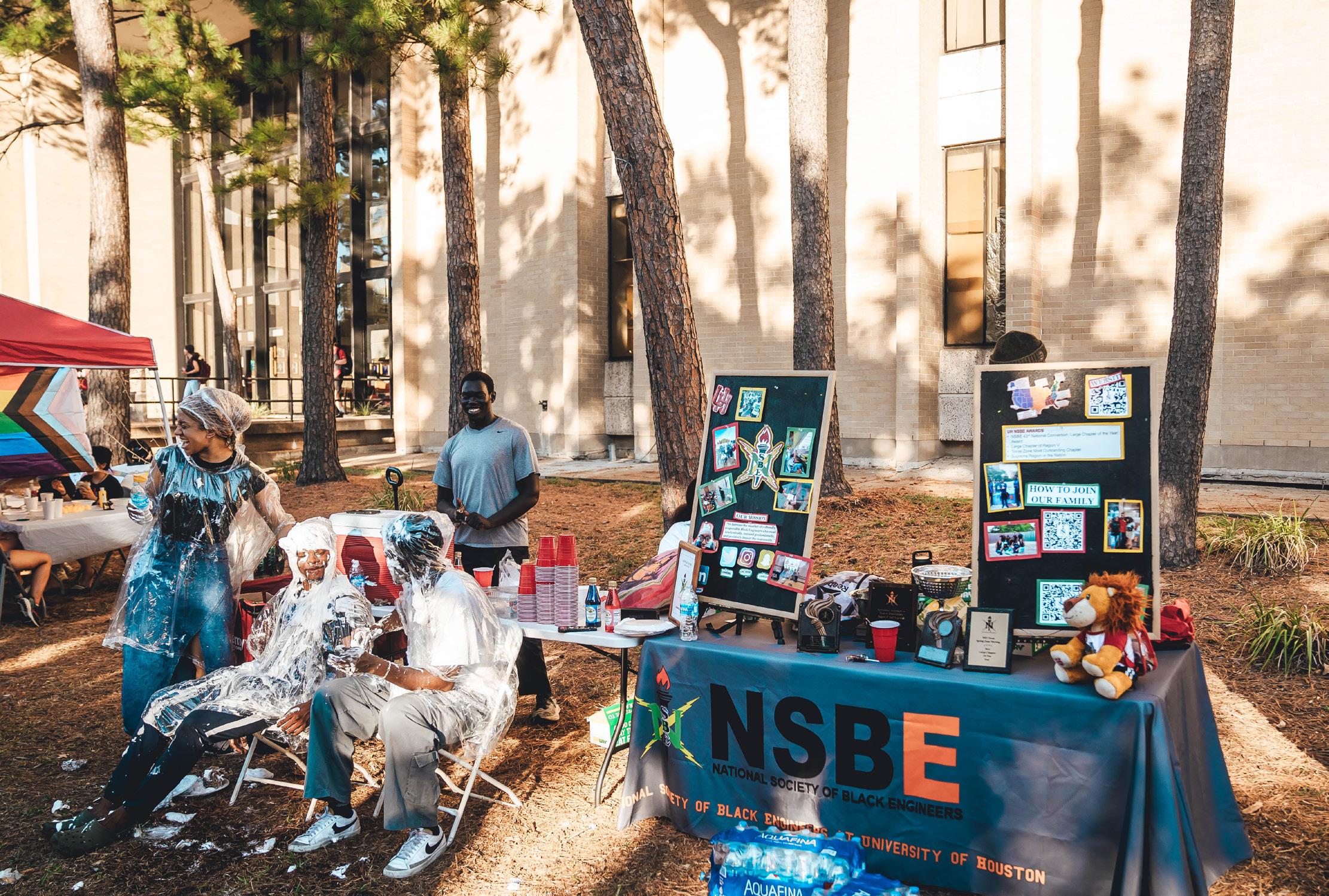




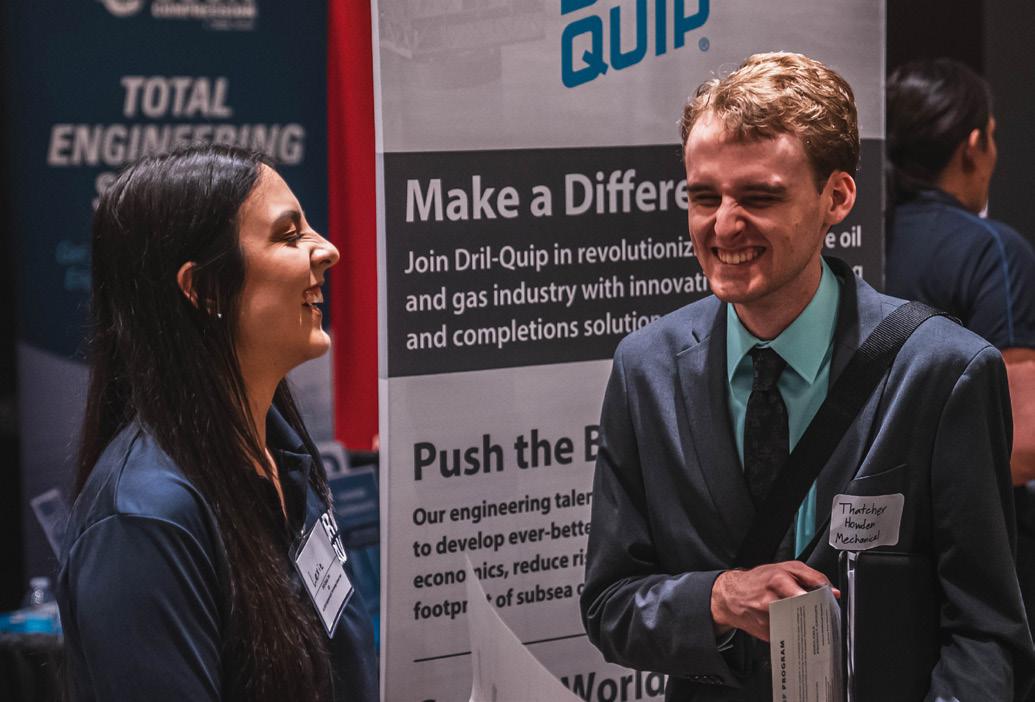
The Cullen College of Engineering hosted an expanded Fall and Spring Career Fair at the UH Hilton on the UH main campus last September and February. The fair was open to engineering and technology majors and welcomed thousands of students to the two-day career fair to network with more than 250+ company representatives and featured big name sponsors including BP, Burns & McDonnell, Chevron Phillips, Patterson-UTI Energy, Inc., Visa Inc., Enterprise Products Partners L.P., ExxonMobil and Schlumberger.




UH celebrated the groundbreaking of a $65 million academic building at its Sugar Land instructional site in October 2023. The three-floor, approximately 75,000 square-foot building will be to the UH Cullen College of Engineering Technology Division.


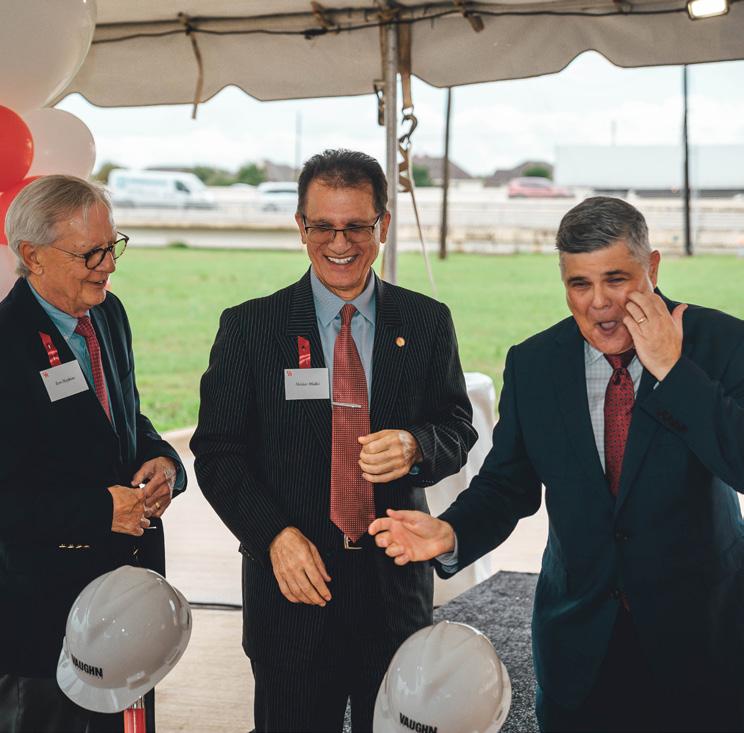




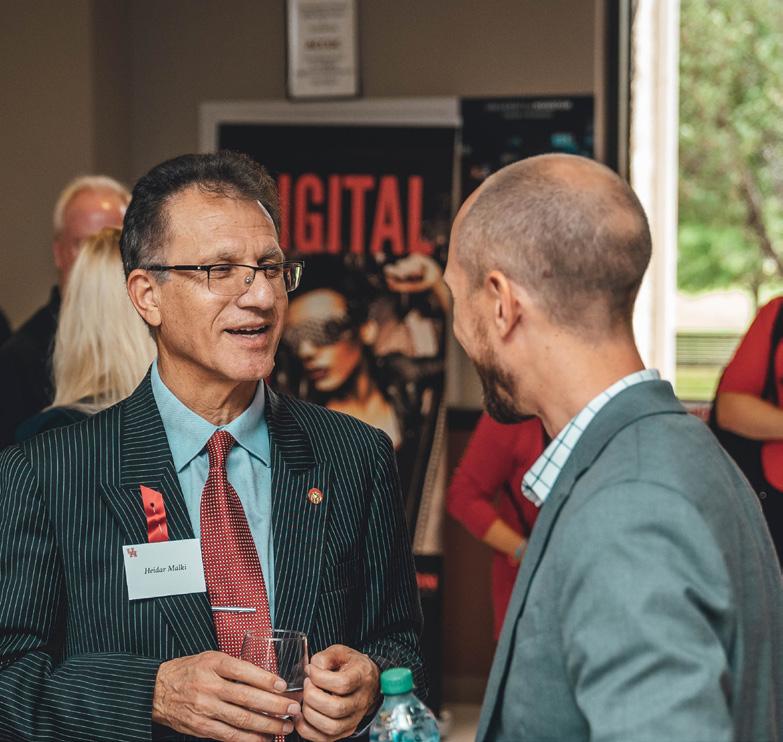




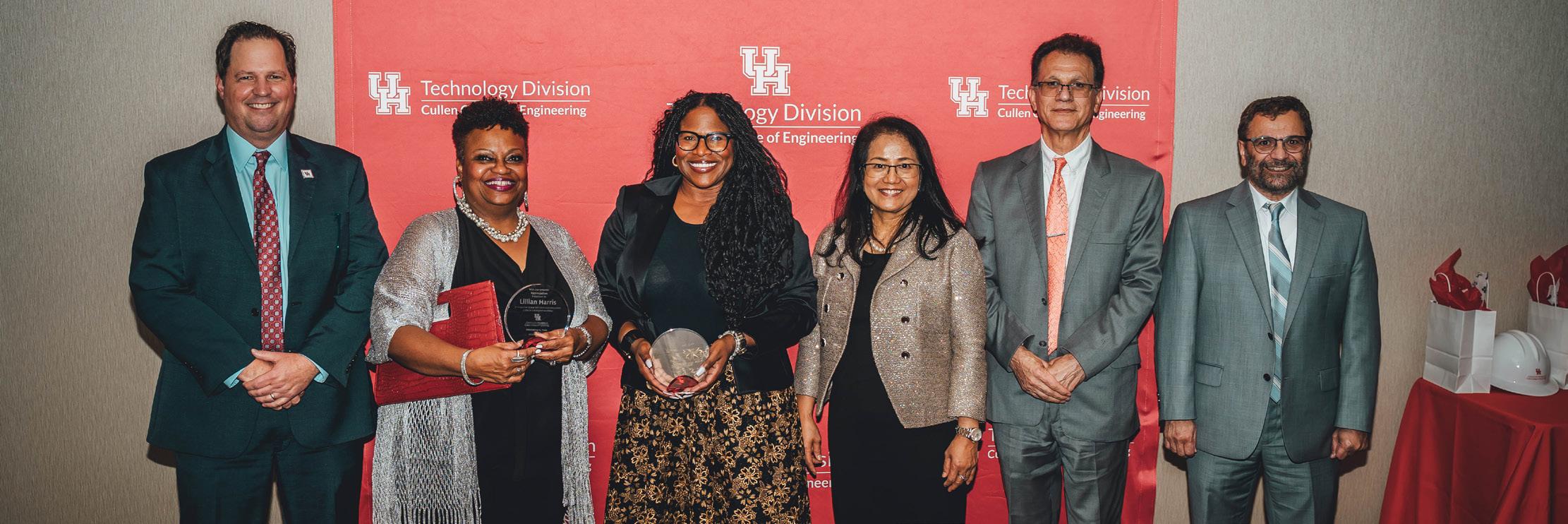


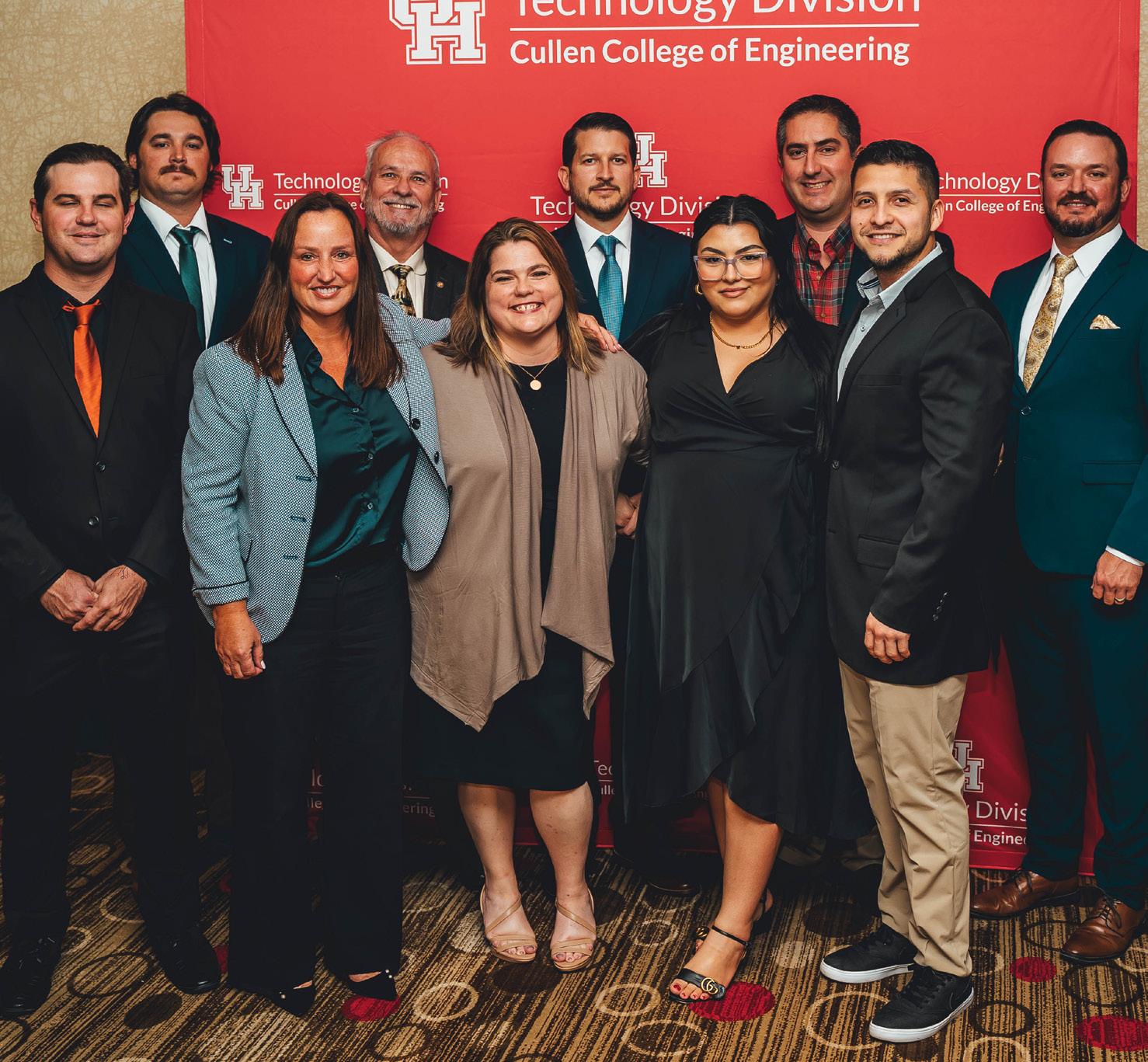
The 65th anniversary of the University of Houston's Construction Management program was celebrated at the Hilton University of Houston Hotel in October with a gathering featuring the various stakeholders that had made the program so successful. This included Construction Management Industry Advisory Board members, alumni of the program, faculty members, staffers, and current students.
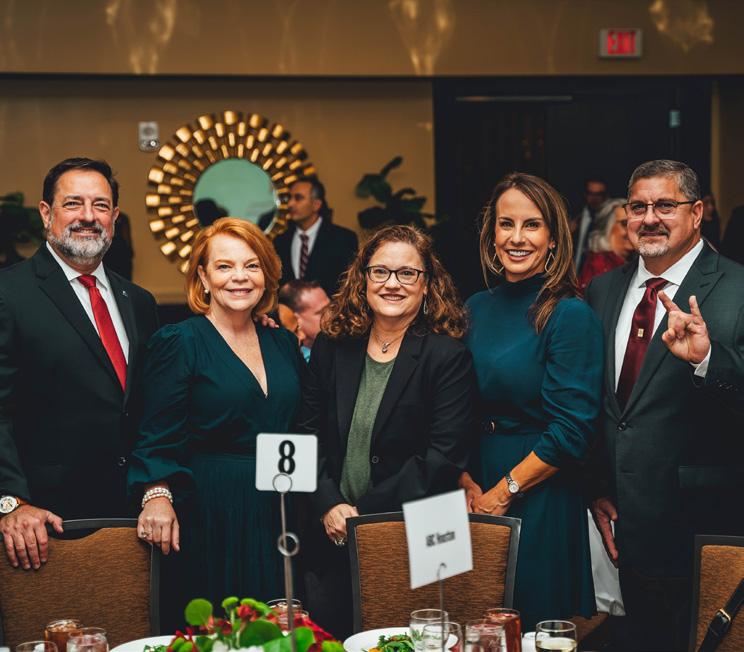

The Cullen College of Engineering’s Fall Class of 2023 Commencement Ceremony was held on Saturday, December 16. Several hundred engineering and technology students took their long-awaited walk across the stage at the Fertitta Center to receive their degrees.



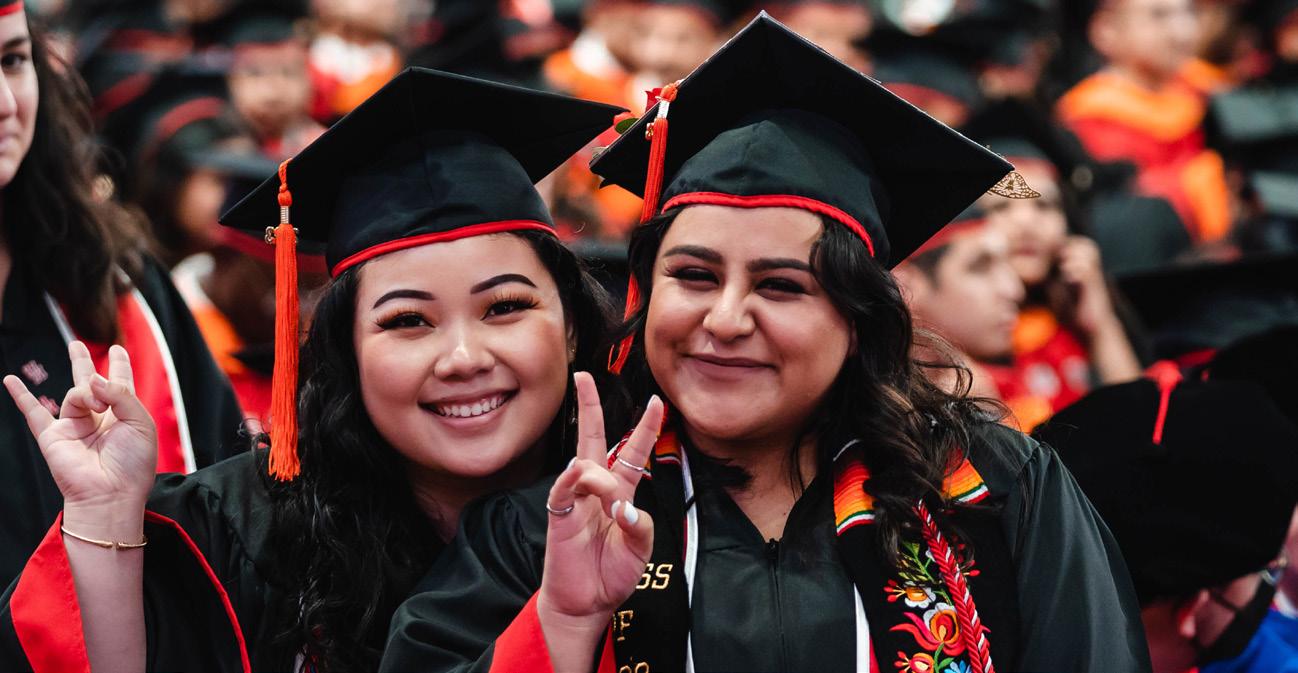

TODAY, LET’S TALK ABOUT RESEARCH AND WATER. THE UNIVERSITY OF HOUSTON PRESENTS THIS SERIES ABOUT THE MACHINES THAT MAKE OUR CIVILIZATION RUN, AND THE PEOPLE WHOSE INGENUITY CREATED THEM.

The word RESEARCH takes a beating. Should we call it research when we just look up information? We academics see research as creating new knowledge. And a huge spur to my own research has been studying water in motion. It’s so complex: How does water and other liquids behave when we handle them, heat them, cool them – hold them up to the light?
Think about spraying liquids: It takes so much energy to create the surface of a liquid droplet. Yet nature makes clouds, white caps, rain, fog. Water drops absorb most of a waterfall’s energy before it hits bottom. I was once kept away from the base of Iceland’s Seljalandsfoss waterfall. Instead of making a big splash, it drove us away with a drenching rain.

That’s why lawn sprinklers use every kind of ingenious means for chopping water into droplets. Another way to create droplets of a liquid is by heating it until it explodes. Turns out, we can heat liquids far beyond their boiling points. Then they explode into fine mists.
The patterns of boiling liquids are so complex. But we need to understand those patterns in real equipment. And that takes serious analysis.
Then there’s color: Water parades in every color of the rainbow. Well, the rainbow itself is no more than water droplets that refract and reflect sunlight. One 19th century scientist tried to prove that water was really blue in color. He shone white light through a long tube filled with very pure water. The light came out blue. But he didn’t know that water filters out red wavelengths. Blue was all the light that was left.


We now know that water has no color of its own. But, oh, the wonderful colors it refracts! Think about Newton shining light through a prism to get the rainbow spectrum of color. Well, shine white light through a bubbling fountain and we get the same colors, but in strange abstract shapes. Try it sometime. Then there’s rainfall finding its way out of a drainage basin. Turns out you can describe those raindrops with the same math that tells how velocity distributes among air molecules. Follow droplets from leaves to trickles, to rivulets, to streams, and you can learn how flooding occurs at the bottom of the basin.
Or direct a jet of water at a metal disc. A dainty sheet of water then spreads out in the shape of a bell. Or let a small water flow leave a sink faucet. When it hits the bowl it first spreads

in a thin, fast-moving sheet. Then it makes a circular jump to a thick slow-moving flow. That’s called a hydraulic jump. People who build dams find ways to trigger that jump in the dam’s spillway to keep the flow from scouring out the riverbed below. So much water research done. So much left to do.
But I now need to say, I’m John Lienhard, at the University of Houston, where we are interested in the way inventive minds work.


The Engines of Our Ingenuity is a nationally recognized radio program authored and voiced by John Lienhard, professor emeritus of mechanical engineering and history at the University of Houston and a member of the National Academy of Engineering. The program first aired in 1988, and since then more than 3,000 episodes have been broadcast. For more information about the program, visit www.uh.edu/ engines.
Watch this edition of Engines Of Our Ingenuity on our YouTube Channel: @UHEngineering
John Leinhard
